5 Reasons to Use a 50mm Lens for Travel Photography (+ Tips)
A Post By: Kevin Landwer-Johan

Why should you use a 50mm lens for travel photography ? And how can you capture beautiful 50mm travel shots?
I’m a huge fan of 50mm lenses and 50mm travel shooting; in fact, for the first two years I owned a camera, my 50mm f/1.4 lens was the only one I used. In this article, I explain five reasons why I recommend a 50mm lens for travel photography. I also include a handful of tips to help you take your 50mm shots to the next level, fast!
Let’s dive right in.


5 reasons you should use a 50mm lens for travel photography
While there are quite a few reasons to do 50mm travel photography, these are my top 5:
1. 50mm lenses are small and lightweight
In travel photography, weight is a big deal. You want to carry a light load; that way, your travels can be as convenient and comfortable as possible.
Of course, the best way to avoid a heavy load is by packing gear that is essential, small, and lightweight. The 50mm lens fits all three of these categories.
Most 50mm lenses weigh only 5.6-6.6 oz (160-190 g). Even short kit lenses are heavier than 50mm lenses, yet they produce lower-quality images and offer narrower maximum apertures .
Plus, a regular 50mm prime lens mounted on a camera will take up far less space than any zoom lens. This makes them easier to pack (plus it makes them less noticeable when you want to capture candid photos). A small camera with a 50mm lens can fit in a jacket pocket or a day bag. That way, you won’t need to carry a dedicated camera bag everywhere when traveling.

2. 50mm lenses offer wide maximum apertures
Most 50mm lenses have a maximum aperture of f/1.8 or f/1.4. (Some 50mm lenses offer even wider apertures; I’ll address those later in this article.)
A “fast” lens like this allows you to choose a quicker shutter speed , which is hugely helpful when the light is low. If you’re shooting indoors, in a cave, or at night, a fast lens comes in handy. With a 50mm prime lens, you can let in two or three extra stops of light over an average kit zoom. That is a big deal .
Wide apertures also produce lovely background blur (i.e., bokeh ). If you want to blur out the background, start by selecting a wide aperture! This effect looks great, and it also allows you to isolate your main subject so they stand out in the frame. I find that, by setting my 50mm lens to f/1.4, I can capture beautiful travel portraits that feature background blur but enough detail to add context.

3. 50mm lenses are cheap
Anyone traveling on a budget – and yes, that’s most of us! – appreciates saving a few dollars when preparing for a trip. Fortunately, adding a 50mm lens to your equipment inventory is not going to break your bank.
You can generally pick up a 50mm f/1.8 prime lens for around $100 to $350, and if you’re willing to buy used, you can go even cheaper. You won’t get the impressive bokeh and extra light offered by an f/1.4 lens, but you’ll still be able to capture some beautiful travel shots.

4. The 50mm focal length is highly versatile
Once you get your hands on a 50mm lens, you’ll understand the impressive versatility of the focal length. You can capture close-ups, medium shots, and even wider scenes.
Really, you can use a 50mm lens to photograph most subjects. It’s great for formal portraits, environmental portraits, architecture, detail shots, and so much more! You can even use it to photograph food, landscapes, and architecture.

5. 50mm prime lenses are sharp
As I mentioned above, 50mm lenses don’t cost very much – yet they offer surprisingly high-quality optics.
If you want to capture sharp travel images (and who doesn’t?), a 50mm lens will do a great job. On the other hand, you’ll be hard-pressed to find a kit zoom that’s as sharp as a 50mm prime. You see, zoom lenses contain lots of glass, which means light has to pass through more elements before it reaches the sensor to create an image. The light becomes more diffracted and the image is less likely to turn out sharp.

50mm travel photography tips
Now that you know why 50mm travel photography is a good idea, it’s time to discuss how you can get great 50mm shots! Here are some tips to help you get the most out of your 50mm lens when traveling.
1. Make sure you purchase a 50mm f/1.8 or f/1.4 (not an f/1.2)
You might not realize it, but the f/1.8 and f/1.4 versions of a 50mm lens offer a few significant advantages over the f/1.2 or faster varieties.
First, 50mm f/1.8 lenses are much cheaper than f/1.2 lenses, and even 50mm f/1.4 lenses are reasonably priced. But once you step up to f/1.2, you’ll pay a whole lot more!
And you probably won’t want to shoot at f/1.2, anyway. Using an f/1.2 aperture takes a whole lot of practice, as it’s easy to miss the point of focus and ruin the shot. Even at f/1.8 or f/1.4, keeping the right part of the composition in focus is challenging for many photographers.
Finally, f/1.8 and f/1.4 lenses are small compared to most faster 50mm primes. This does depend somewhat on the brand, but in general, if you’re concerned about size and weight, then a faster 50mm prime is best left at home.

2. Move your feet for better compositions
If you’re used to traveling with a zoom lens, then you might be in the habit of zooming to adjust your framing – but with a prime lens, if you want to alter your composition , you need to move .
Really, no matter your lens type, moving is a good thing. It’ll help you find more interesting compositions. When I teach my travel photography workshops, I often have to encourage people to move about more, and this results in much better shots. Your first composition isn’t always the best!
Of course, with a 50mm prime lens on your camera, you’ll be forced to move frequently. In my experience, the more you use a prime lens, the more you’ll automatically begin checking out other perspectives when you find a great subject to photograph – and the more you’ll leave with amazing images.

3. 50mm lenses are great for travel panoramas
If you love to capture majestic, wide-angle images when you travel, you might be worried; after all, if you shoot with a 50mm lens, you’re giving up the wide perspective, right?
Not necessarily! Because while a 50mm lens doesn’t offer a wide-angle field of view, you can expand its focal length capabilities by creating multi-shot panoramas. Bonus: 50mm lenses tend to avoid distortion, which makes it easy to create seamless panoramas.
Simply mount your setup on a tripod, then slowly rotate the camera while taking images. (Aim to overlap each shot by around 30%.) You can quickly stitch together the resulting files in post-processing, and – voila! – you’ll have a beautiful “wide-angle” shot.
4. Use your 50mm lens for a full month
If you want to get good at 50mm travel photography fast , then here’s my recommendation:
Put your 50mm lens on your camera. And don’t take it off for a whole month.
Every day (or as much as you can), head out to shoot. Get a feel for the 50mm field of view. Learn its framing. See its depth of field effects.
By the time the month is up, you’ll be a 50mm expert !
50mm travel photography: final words

Don’t be afraid to travel with a minimal amount of gear. It can actually help you become a more creative photographer! With a lighter camera bag, you’re free to move around, and you won’t feel so tired at the end of the day.
So grab a 50mm lens. Head out. And enjoy your travels!
Now over to you:
Do you plan to use a 50mm lens on your next travel outing? Why or why not? Share your thoughts in the comments below!

Read more from our Cameras & Equipment category
Kevin Landwer-Johan is a photographer, photography teacher, and author with over 30 years of experience that he loves to share with others.
Check out his website and his Buy Me a Coffee page .

- Guaranteed for 2 full months
- Pay by PayPal or Credit Card
- Instant Digital Download

- All our best articles for the week
- Fun photographic challenges
- Special offers and discounts

- Reviews TV REVIEWS v1.11 HEADPHONES REVIEWS v1.7 MONITOR REVIEWS v2.0 SOUNDBAR REVIEWS v1.3 MOUSE REVIEWS v1.5 KEYBOARD REVIEWS v1.3.1 PRINTER REVIEWS v1.2 VACUUM REVIEWS v1.3 KEYBOARD SWITCH REVIEWS v1.0 AIR PURIFIER REVIEWS v1.0 DEHUMIDIFIER REVIEWS v1.0 MICROWAVE REVIEWS v1.0 BLENDER REVIEWS v1.0 TOASTER REVIEWS v1.0 ROUTER REVIEWS v0.8 PROJECTOR REVIEWS v0.9 SPEAKER REVIEWS v0.8 CAMERA REVIEWS v0.12.1 LAPTOP REVIEWS v0.8.2
- What's New COMPUTER Monitors, Mice, Keyboards, Printers, Routers, Keyboard Switches, and Laptops HOME ENTERTAINMENT TVs, Soundbars, and Projectors AUDIO Headphones and Speakers HOME Vacuums, Dehumidifiers, and Air Purifiers PHOTO & VIDEO Cameras KITCHEN Toasters, Blenders, and Microwaves REVIEW PIPELINE See upcoming reviews, cast your vote, and suggest products
- Newsletters
- Table of Contents
- Best Camera
- Best Full Frame
- Best Mid-Range
- Best Budget
- Best Point-And-Shoot
- Best Vlogging
Notable Mentions
Recent updates, all reviews, the 6 best travel cameras - summer 2024 reviews.

A good camera can be an indispensable travel companion, letting you capture your adventures abroad to share with friends and family. For many, the best digital camera for travel is the one you've already got in your pocket—your smartphone. If you want to step up your photography game, however, there are plenty of great cameras out there that won't take up too much space in your luggage. While it can be hard to narrow them down, it's important to consider things like portability, battery life, build quality, your own ergonomic preferences, and, of course, your budget.
We've bought over 105 cameras, and below, you'll find the best travel cameras we've tested. If you're specifically looking for a point-and-shoot camera, check out the best compact cameras for travel instead. Or, if you're interested in capturing beautiful landscapes on your travels, the best cameras for landscape photography might also be of interest. Travel vloggers can also look at our top vlogging picks .
Best Camera For Travel

The OM SYSTEM OM-5 is the best digital camera for travel that you can get. As part of the Micro Four Thirds (MFT) system, it offers a balanced mix of portability, ruggedness, and image quality. Though it isn't as heavy-duty as higher-end models like the OM SYSTEM OM-1 Mark II or the older Olympus OM-D E-M1 Mark III , it has a more compact body that makes it better for travel. Plus, it's compatible with a wide selection of portable MFT lenses that will keep the overall size of your kit down.
Beyond its relatively small size, the camera is weather-sealed and feels well-built overall. It has an excellent five-axis in-body image stabilization (IBIS) system, which can help you get steadier shots at slower shutter speeds or while recording vlogs. That said, the OM-5 doesn't have the longest battery life, so you might have to pick up a spare battery for long days on the go, but overall, this is an excellent travel camera for the price. If you want to save even more money, the older Olympus OM-D E-M5 Mark III is nearly identical and can be found for less if you buy used, though it uses an older processor and lacks some extra features like 'Live ND' mode.
See our review
Best Full Frame Camera For Travel

If image quality is your top priority, the Sony α7C II is one of the best cameras for travel photography you can buy. It's one of the few full-frame cameras on the market that boasts such a compact size. While it's still the largest option on this list, and full-frame lenses are typically larger, it's impressive how compact Sony made this camera while including features like IBIS and a fully articulated screen.
The real star here, of course, is the camera's high-resolution full-frame sensor, which has plenty of dynamic range and great noise handling in trickier lighting conditions. On top of that, the camera has a fantastic battery life and a sturdy, weather-sealed body. That said, its ergonomics leave a little to be desired, particularly when shooting through the tiny viewfinder. If you want to save some money, the original Sony α7C is practically a bargain now, though the new model is more well-rounded, with better video features and a higher-resolution sensor.
Best Mid-Range Camera For Travel

If you can do without IBIS and want something a bit more affordable, the Fujifilm X-T30 II is a great mid-range option. It uses an APS-C sensor and has a portable, lightweight body that's ideal for traveling. While it lacks more premium features like weather-sealing and advanced video specs, it's still a relatively sturdy camera, and its dedicated exposure dials give you more hands-on control over camera settings.
Aside from its portability, the X-T30 II uses a relatively high-resolution APS-C sensor that delivers excellent image quality straight out of the camera. Film simulation profiles make the camera a blast to shoot with and let you change up the look of your photos without having to do any post-processing. On top of that, the camera has a decent autofocus system and a relatively long-lasting battery, making it an excellent travel camera for the price. If you can stretch your budget, its successor, the Fujifilm X-T50 , offers better video features, IBIS, and a higher-resolution sensor, but it's also significantly more expensive.
Best Budget Camera For Travel

The Olympus OM-D E-M10 Mark IV is one of the best budget cameras we've tested for travel. Like the higher-end OM SYSTEM OM-5 above, it uses a Micro Four Thirds sensor, making for a remarkably portable camera kit with plenty of lightweight and affordable lens options. It's also a great choice for beginners, thanks to simple controls and easy-to-use creative shooting modes.
This is also one of the only cameras at this price point to feature IBIS, which can help capture handheld images at slower shutter speeds and comes in handy for stabilizing videos and vlogs. That said, this is still an entry-level model, so it doesn't have the greatest build quality. Its autofocus system can also be sluggish with faster subjects. If you'd prefer a camera with a more reliable autofocus system, the Canon EOS R50 is an amazing alternative and comes a bit cheaper. However, its lens options are more limited, and it's less portable overall.
Best Point-And-Shoot Camera For Travel

A premium point-and-shoot is the way to go if you need something compact but more capable than your smartphone camera. The Sony RX100 VII has been going strong for several iterations, and for good reason. This latest model uses a stacked 1-inch sensor, so image quality is very solid for its class. It's also one of the few cameras that's actually pocketable, so you can bring it with you wherever your travels take you, and its built-in lens has a fairly long zoom range that's great for travel snapshots of everything from landscapes to far-away subjects.
Be aware that compact cameras like this have a limited battery life, though you can always bring a spare battery or a portable battery pack to charge it on the go. The RICOH GR III is a great alternative if you want a more minimalist camera. It doesn't have a viewfinder, and its fixed focal length lens is less versatile than the zoom lens on the Sony. However, it has a larger APS-C sensor that delivers excellent image quality and is better suited to low-light situations. On the other hand, if you're looking for something cheaper, you can still find older generations of the RX100 on eBay and other used camera retailers.
Best Vlogging Camera For Travel

If you prefer to vlog about your travels rather than photograph them, try the Sony ZV-1. Like the Sony RX100 VII above, it uses a 1-inch type sensor, performing similarly when it comes to image quality and autofocus, but it has a different design, with no viewfinder and a shorter zoom range. On the flip side, it's one of the only compact cameras to feature a fully articulated screen that's ideal for recording yourself. Plus, it has a better built-in mic than most point-and-shoots, complete with a detachable windscreen to cut down on wind noise while recording.
If you prefer a wider field of view, consider getting the newer Sony ZV-1 II , which has a new wide-angle lens that's a good fit for walk-and-talk vlogs. The camera performs similarly otherwise, but Sony also removed optical stabilization from its lens. For that reason, and because of its price, the original ZV-1 is a better deal for most travel vloggers and one of the best video cameras for travel if you need something compact.
- Fujifilm X100VI: The Fujifilm X100VI is one of the best point-and-shoot cameras on the market, with a larger APS-C sensor that captures excellent images. However, it's less portable, more expensive, and a bit more niche than the Sony RX100 VII, with a fixed focal length that's less versatile for everyday travel photos. See our review
- Nikon Z f: The Nikon Z f is an excellent full-frame option for travel, particularly if you like vintage-style cameras. It has a retro-inspired and relatively portable design but isn't as compact as the Sony α7C II. See our review
- RICOH GR IIIx: Like the RICOH GR III, the RICOH GR IIIx is a great alternative to the Sony RX100 VII. It's nearly identical to the GR III but features a 40mm focal length lens instead of the wider 28mm focal length on the GR III. The Sony is still more versatile for most travelers thanks to its zoom lens, better autofocus, and 4k video capability. See our review
- Sony ZV-E1: The Sony ZV-E1 is a full-frame camera that's even more compact than the Sony α7C II. It's a great choice for high-quality travel videos, with a sensor optimized for low light. However, it lacks a viewfinder and is generally less versatile for photographers and hybrid shooters. See our review
Aug 29, 2024: We replaced the Fujifilm X100V with the Fujifilm X100VI as a Notable Mention and added a comparison to the Fujifilm X-T50 in our discussion of the Fujifilm X-T30 II.
Jul 04, 2024: We added the RICOH GR IIIx to the Notable Mentions as another option for those looking for a minimalist compact camera.
Jun 04, 2024: We brushed up some of the text in the article for clarity and reviewed the picks to ensure they're still current.
May 08, 2024: We reviewed the cameras included in the article, including their price and availability, to ensure the article is up to date and adequately meets user needs.
Apr 10, 2024: We've replaced the Sony α7C with the Sony α7C II because it's more widely available and offers some advantages for video work. We also removed the Sony ZV-1 from the Notable Mentions, making it the 'Best Vlogging Camera For Travel.' Finally, we added the Nikon Z f to the Notable Mentions.
Our recommendations above are what we think are currently the top travel cameras for most people, according to their needs. We factor in the price, feedback from our visitors, and availability (no cameras that are difficult to find or almost out of stock in the U.S.).
If you'd like to choose for yourself, here's the list of all of our camera reviews, ranked by their suitability for travel photography. Be careful not to get caught up in the details. There is no single perfect camera. Personal taste, preference, and shooting habits will matter more in your selection.
Journey of Doing
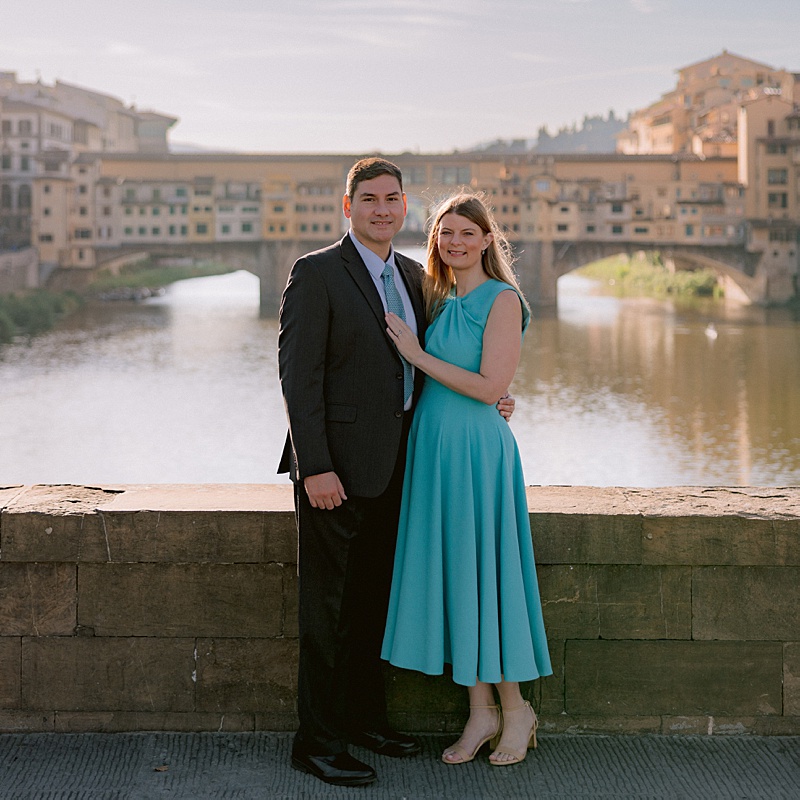
Hello! I'm Sara
- Recent Posts
- Destinations
- In My Suitcase
- Travel from Home
- Travel Services
50mm Travel Photography Lens Review & More
For awhile, I’ve been trying to figure out how to share more photography content and information on my blog. I get a lot of questions about cameras. The truth is, good photography has less to do with the camera and more to do with the lens. It also comes from knowing how to use your camera. My photography style changes from trip to trip, which means I have a nimble collection of lenses. (I’ve come a long way from expecting 50mm travel photography to be enough for me.) In attempt to help demystify which lenses to use, I am starting this series to share more about the capabilities and limitations are of different lenses. I don’t really have a vision for this yet, so if there’s something that would be helpful to you, please drop me a line!
Disclosure: This post contains affiliate links for tours and products I love at no additional cost to you. You can read my full disclosure policy here.
Photography Basics
If you aren’t sure how to use your camera, start by reading my post on how to get out of auto mode on your camera . To truly start improving your travel photography, you’ll want to understand how the f/stop (AKA aperture), shutter speed, and ISO work together to create beautiful images. You can get good images in auto mode, but they aren’t always perfect. Auto mode doesn’t allow you to control your focal point. Bumping up the ISO creates grainy images. Opening the shutter as wide as it will go in low light situations compromises the sharpness. TL, DR: There is always something to learn.
For reference, I currently shoot with Canon 5D Mark IV . I purchased a Canon 5D Mark II after I slipped and fell with my camera and needed to shoot a wedding while it was in the shop. Before that, I used a Canon 50D . And, when I started digital photography, I used the Canon Rebel xTi for several years. I mention each of those cameras to help you understand that you don’t need the most expensive camera to be successful at travel photography . I use Canon Price Watch to watch for the best deals on gear, especially around Black Friday.
50mm Travel Photography Basics
The 50mm lens is one of the first lenses I purchased when I got serious about photography. There’s a reason that it’s called the “nifty fifty.” It’s nimble, flexible, and it works great at different skill levels. There are three popular versions of this lens with a range of f/stops. You do not need the most expensive version of this lens to start with. In fact, I purchased the cheaper version when I was still learning my camera. I didn’t know if a prime lens would be for me. After I started getting the hang of it, a photographer I knew was selling all his gear and I purchased several lenses from him. (The Canon refurb site is my best travel photography hack for lenses. I’ve never been disappointed when the quality of their lenses. When they offer an additional 15% off their sale prices, everything is a steal.)
Canon 50mm f/1.8 , Canon 50mm f/1.4 , Canon 50mm f/1.2L
Note: Learning to shoot with prime lenses has a learning curve. Most people are used to a lens with a varying focal length, but prime lenses require you to use your own two feet to frame the perfect shot. Now that I’ve mastered prime lenses, I prefer the images to those created with lenses of varying focal lengths. This is a personal preference and that’s okay.
Pros of the 50mm Travel Photography Lens
As far as 50mm travel photography goes, this lens is pretty flexible. It does well with sweeping landscape photography and it can create beautiful portrait photography. If you have small children, it is a great lens for getting down on their level. Whether you use it on a full-frame sensor or not, it can provide some capacity for capturing architectural details that you would use a zoom lens for in other circumstances. (I find that it’s a particularly great lens to photograph the ceilings in cathedrals.) As a travel blogger, I like to use it in restaurants for easy food photography. You don’t have to contort yourself to get great pictures of food. All versions of the 50mm do well in low light situations. (Remember: the lower the f/stop number, the more light that can go into the lens – and the higher the price!)
TL;DR: Use the 50mm lens when photographing sweeping landscapes, architectural details, food photography, and portraits. It also does well with fireworks but you should read more about how to photograph fireworks before expecting the lens to do all the work. If you’re looking for bokeh (the “blurry background”), this lens does well with it. It takes practice though.
Cons of the 50mm Travel Photography Lens
While I used the 50mm prime lens exclusively for several years as my go-to lens for everything, it does have a lot of limitations when it comes to travel photography. This is not a wide angle lens. If your goal is to take photos of yourself enjoying your vacation, a fixed lens of a 50mm can be limiting. The distance required to get full-body shots of adults into a frame can be challenging, particularly in crowded locations. If you’re asking strangers to take photos of you, the average passerby is confused when they can’t zoom in and out to take the photo. You’ll end up with a lot of half-body shots. (These are lovely but might not be what you are looking for.) I don’t love this lens for street photography.
If you are a travel blogger, it will be difficult to photograph most hotel rooms using the 50mm lens, especially if you are not using a full-frame sensor.
One last thing to note, I shoot with the Canon 50mm f/1.2L. The weight of this lens is significant. Certainly, there are much heavier lenses, but if you’re upgrading from a kit lens, this takes a bit of getting used to.
TL; DR: This is not the one lens to use for travel photography if you want to photograph yourself on vacation. It’s definitely not a selfie lens. If you need to photograph full details within short distances (i.e. small hotels rooms or home details), this is not the lens for you.
50mm Photography Examples and Discussion
Blue hour photography.
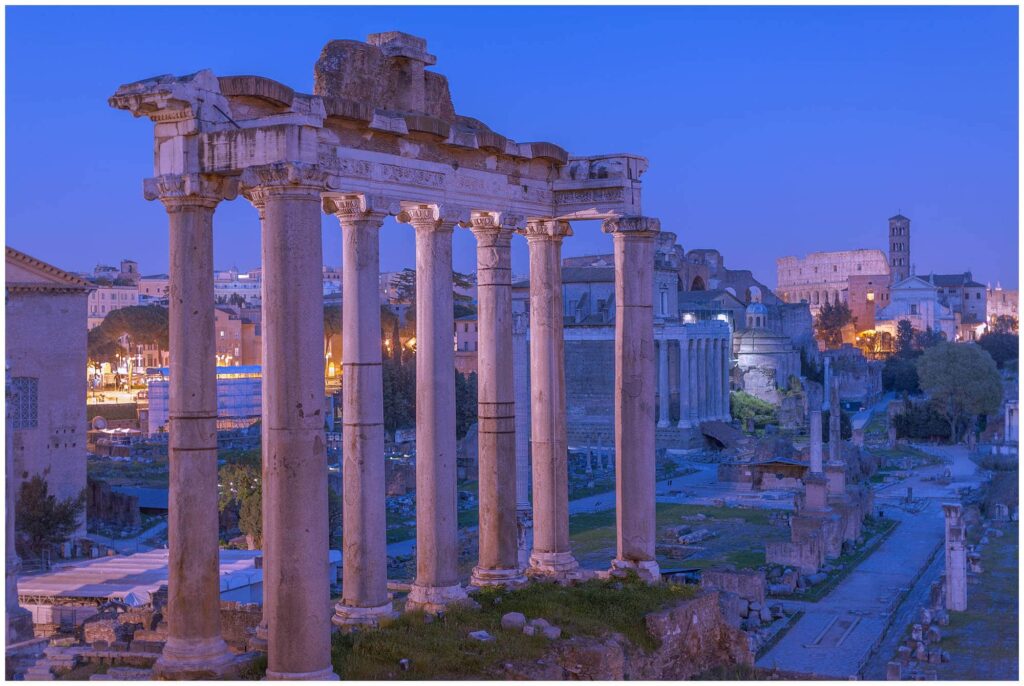
This photograph pushed my personal limits in “quick” photography. We were on a tour, so I didn’t have a tripod with me and I didn’t feel comfortable shooting long exposures. Instead, I propped my camera lens up using coins and a nearby wall and dropped my f-stop down pretty low. You’ll notice that I often keep the ISO low because I don’t want to lose the sharp details in a photograph.
Sunset and Blue Hour Photography
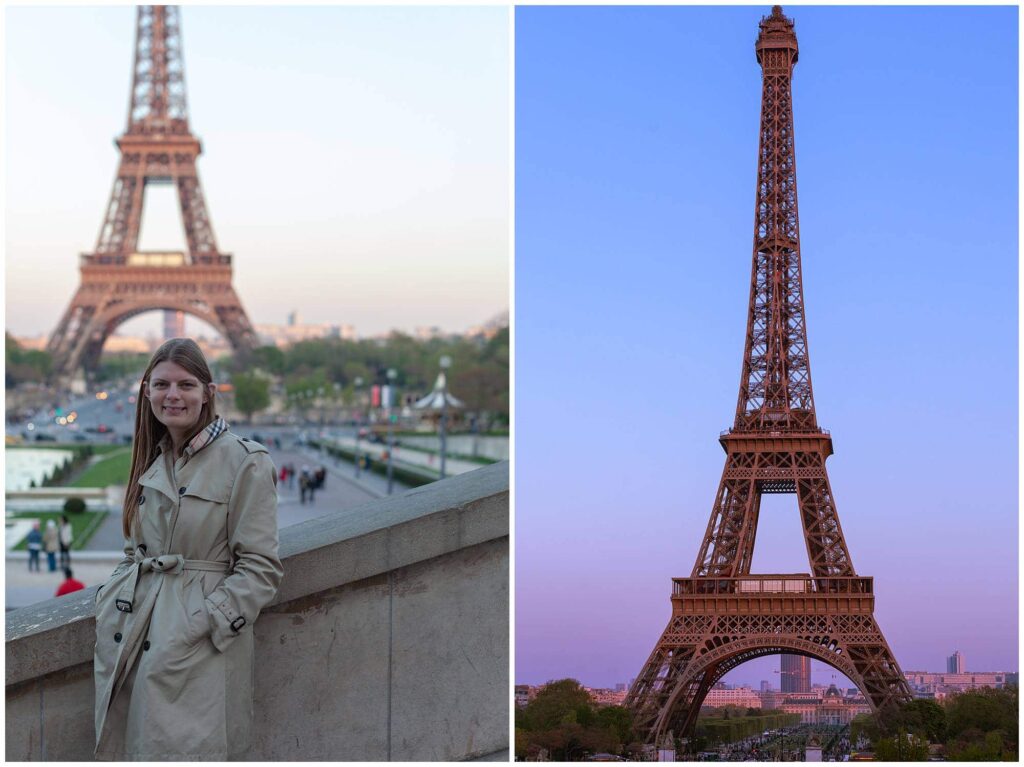
These photographs do a great job of illustrating the benefits and limitations of the 50mm lens. These photographs were taken in Paris from Trocadero. Trocadero is still/only a mile from the Eiffel Tower. You cannot see the entire Eiffel Tower in a single shot. Most of my raw photos were shot at an angle in an attempt to capture the entire tower.
On the left, you’ll notice the beautiful portrait photography. My husband is not an instagram husband by any stretch of the imagination, but I am in focus. You can see the bokeh with an f/stop as high as 2.8, proving that you don’t need the 1.2L for beautiful portraits. If he wanted to let more light in to prevent the dark shadows, he could have adjusted the shutter speed but he’s not a professional photographer and wouldn’t know to do that.
On the right, you’ll notice the sharp details achieved by bumping up the f/stop. I dropped the ISO back down to keep the beautiful colors of the sunset. Light changes rapidly during sunset and blue hour, so a tripod would have been helpful. If I was still learning my camera, I might have set my camera on aperture priority mode and allowed the camera to do the rest.
Golden Hour Photography
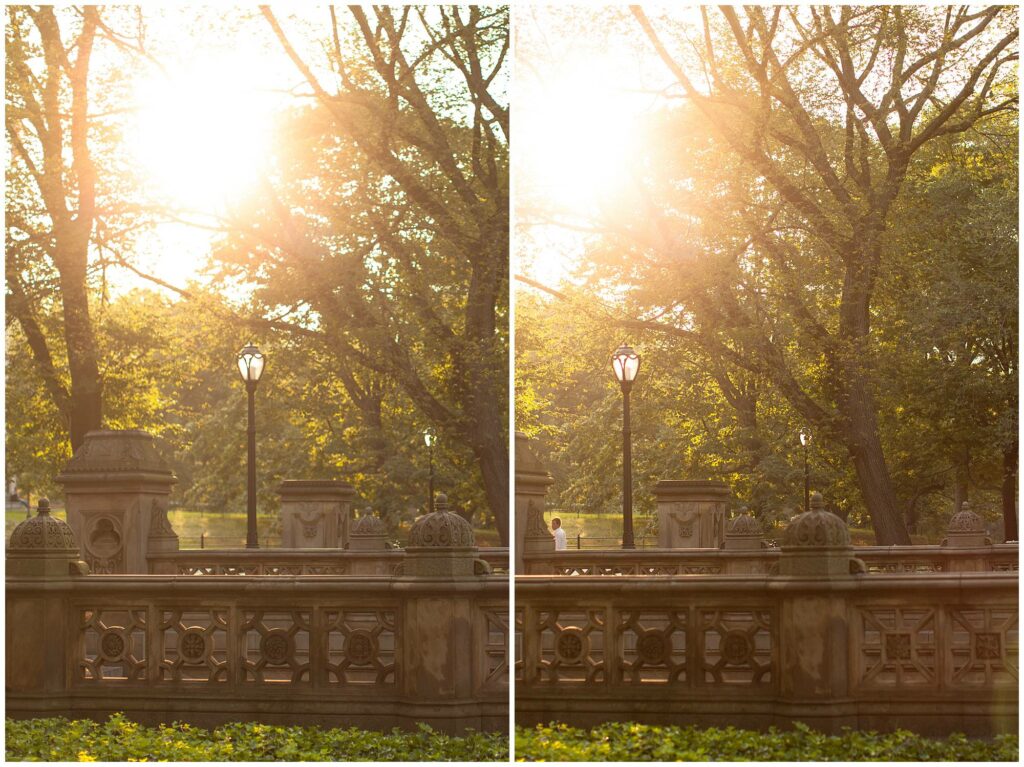
I left these two photographs in here to show that you don’t have to get perfect every time. While you can see a little bit of difference in the sharp details of the photograph on the right, the left photo is almost identical. In this case, I was more concerned with the beautiful golden hour light in Central Park. Sometimes you’ll get almost identical images by changing small things. (This shot was taken horizontally, but I cropped it vertically to get rid of the sun flare that my lens picked up from shooting directly into the sun.)
Food Photography
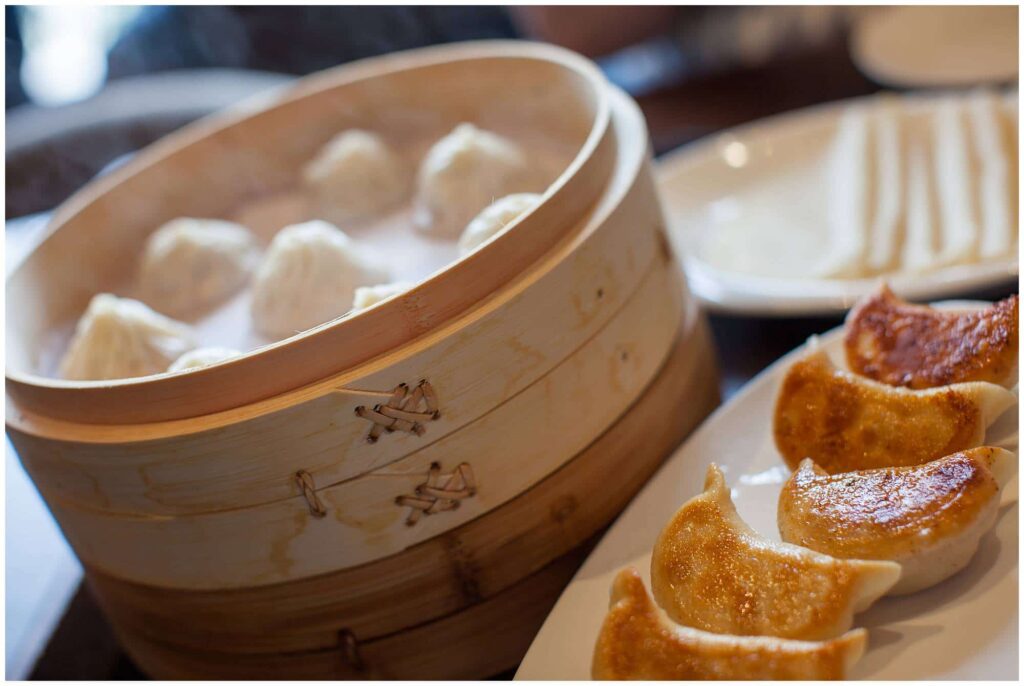
I HATE being obvious about food photography. Nothing makes me feel more awkward than jostling around in tight restaurants to take photographs of food. I refuse to change lenses in the middle of a meal either. Whatever is on my camera is what you get. The 50mm lens does a great job of allowing me to take photographs of food quickly and without being too obvious. (I refuse to reset an entire table to take photographs of food. Sometimes Tom and I will switch plates, but I prefer to get to the business of eating.) While you can see the limitations of the 50mm lens in this photo, you can also see the beauty of the details.
Night and Low Light Photography
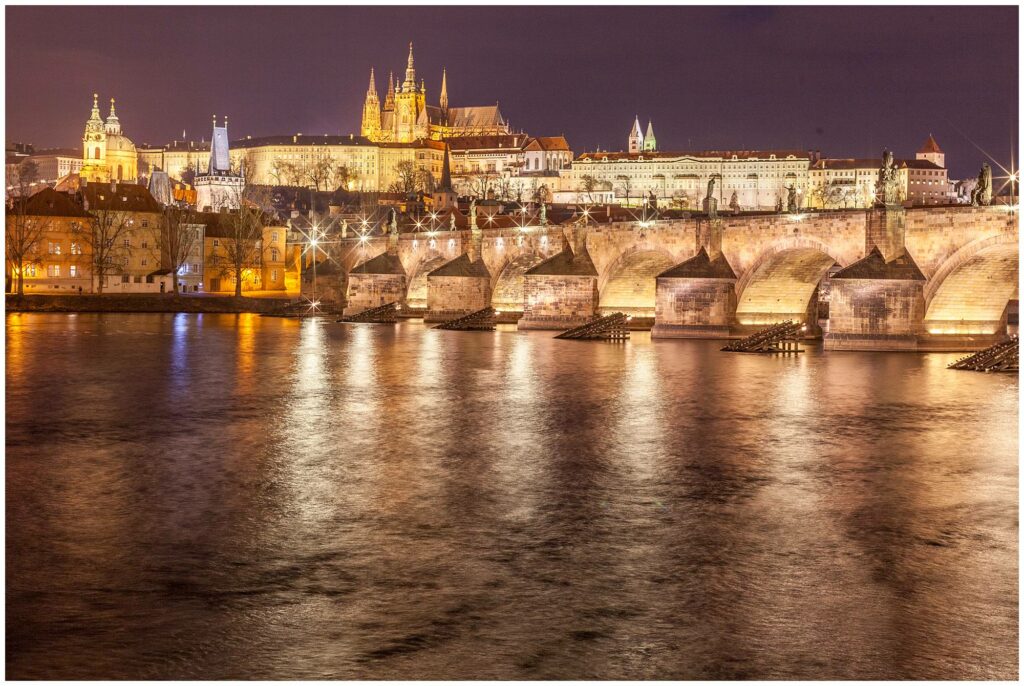
This photo was taken on a very cold, very windy winter night in Prague. (You can tell by looking at the water.) I bumped the f-stop up significantly because I wanted to capture as many details of the castle as I could. The shutter speed was a little bit long, but I didn’t want to take my gloves off to keep manipulating the dials. (If you find gloves that work well for photography, I’m all ears.) I did crop the shot in post processing, but everything else is SOOC (straight out of the camera).
When I shot with a kit lens and my Canon Rebel, I purchased filters to create the “star” effect on lights. Now I know that longer shutter speeds do the trick, no filter required. If I wanted to reduce the amount of light in this photo, I could have dropped my ISO to 100 or 200 or reduced my shutter speed to let in less light.
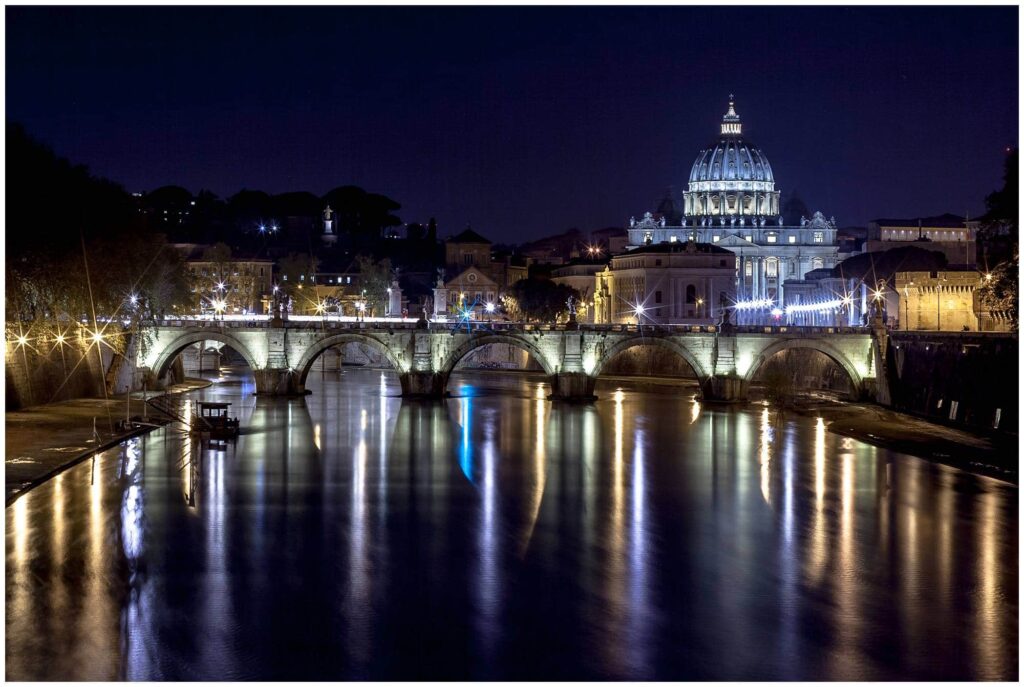
In this photo, you can see the benefits of long exposure. See how glassy the water is? That’s from the long exposure. See the light trains on the bridge? That’s from cars driving by with the long exposure. On this particular trip, I did not take a lens with more zoom capabilities. In order to create the shot I wanted, I cropped this photo during post-processing. I also used a Lightroom preset to correct the orange lights. (You can also correct white balance to do this, if you have a true white in the same lighting conditions. In this case, the preset is easier to use.)
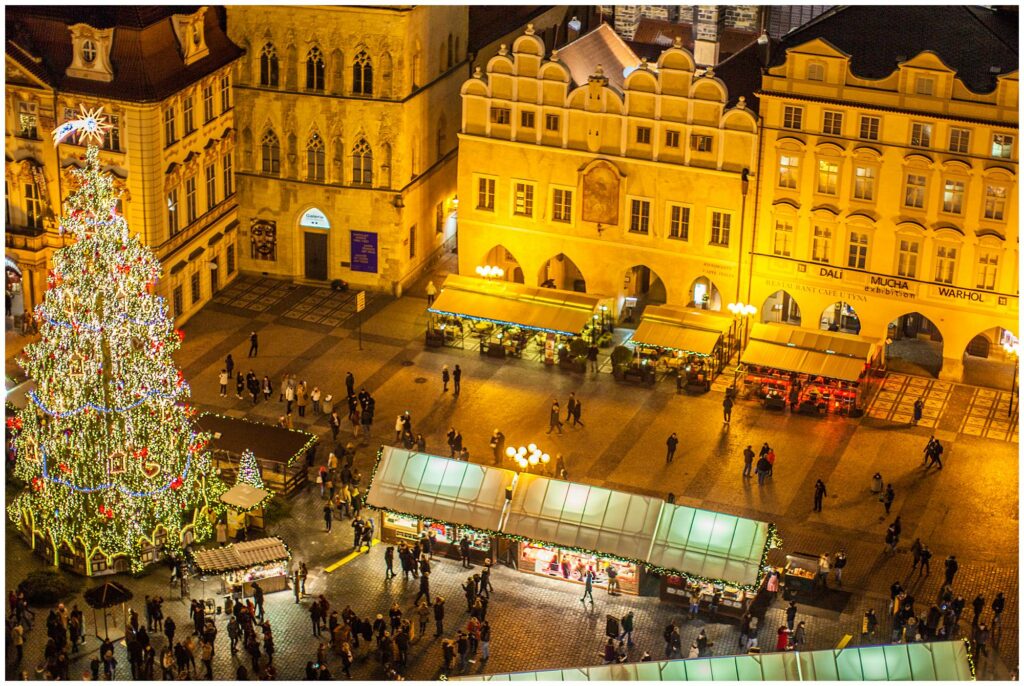
This photo does a good job of showing the benefits of having the extending f-stop range but also shows the pitfalls of using the f-stop to compensate for a tripod in low light situations. You’ll notice that this image has lost a lot of sharpness, particularly in the dimly lit areas. The lights on the Christmas tree are a bit blurry. There wasn’t room for a tripod at the top of the tower. If I had one, however, I would have moved the f-stop down and opened the shutter speed for a longer period of time. If it hadn’t been so cold, I might have played with the ISO a little more. That being said, the 50mm did a great job of providing me a bird’s eye view of the Old Town Square Christmas market that I would not have gotten from the ground.
Landscape Photography
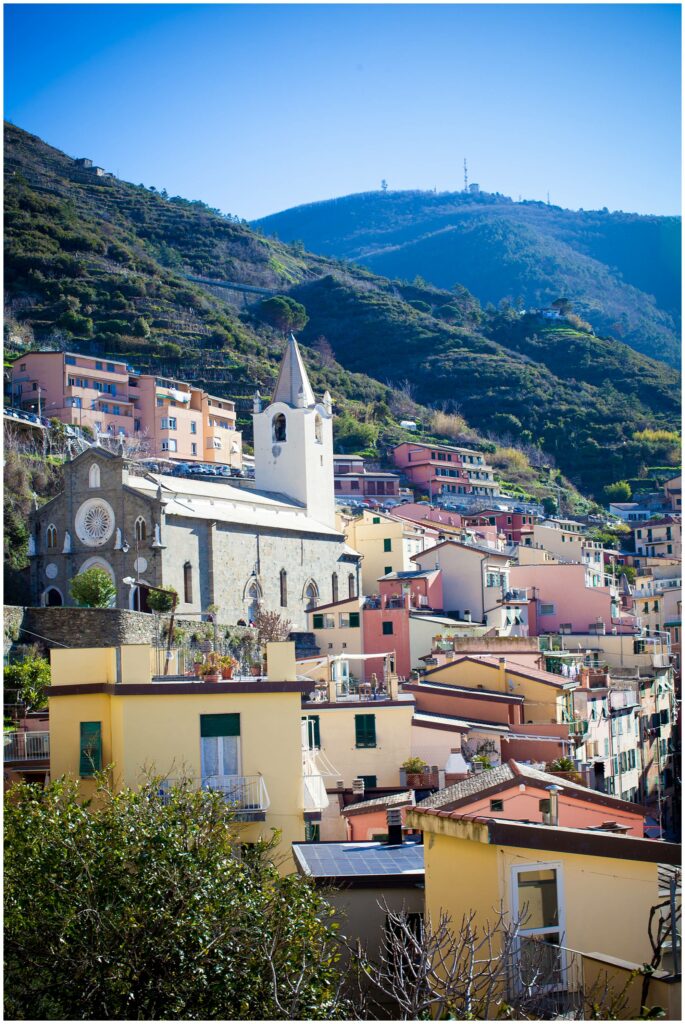
This photograph was taken in Riomaggiore and is a good example of why I don’t like to photograph cities in the middle of the day. Despite the beautiful blue skies, the midday haze made it hard to get the colors right. The buildings aren’t as vibrant as they could be. That being said, it also shows the limitations of the 50mm when photographing landscapes with a lot of details. I had difficulty framing the perfect shot because I was not able to zoom in on the church with the wine terraces in the background. I left the shot as is because cropping it would have created a lot of discontinuity.
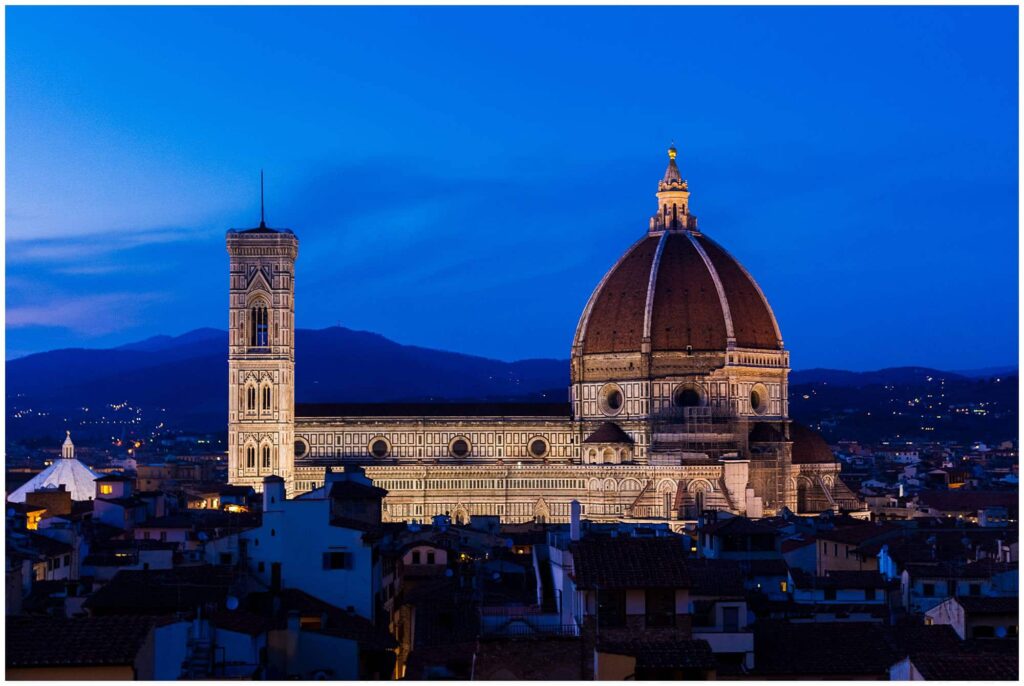
Ah, the Duomo. Impossible to photograph from the ground with a 50mm, but the 50mm takes some beautiful shots from the Palazzo Vecchio. (If you want more of the landscape details, head to the Piazzale Michelangelo or San Minato al Monte .) Rather than dropping my f/stop and losing the details of the Duomo, I bumped my ISO up to 1600. (I don’t like to go over 1600 in most circumstances. My camera has a much higher ISO range, but I have not been happy with the outcome yet.)
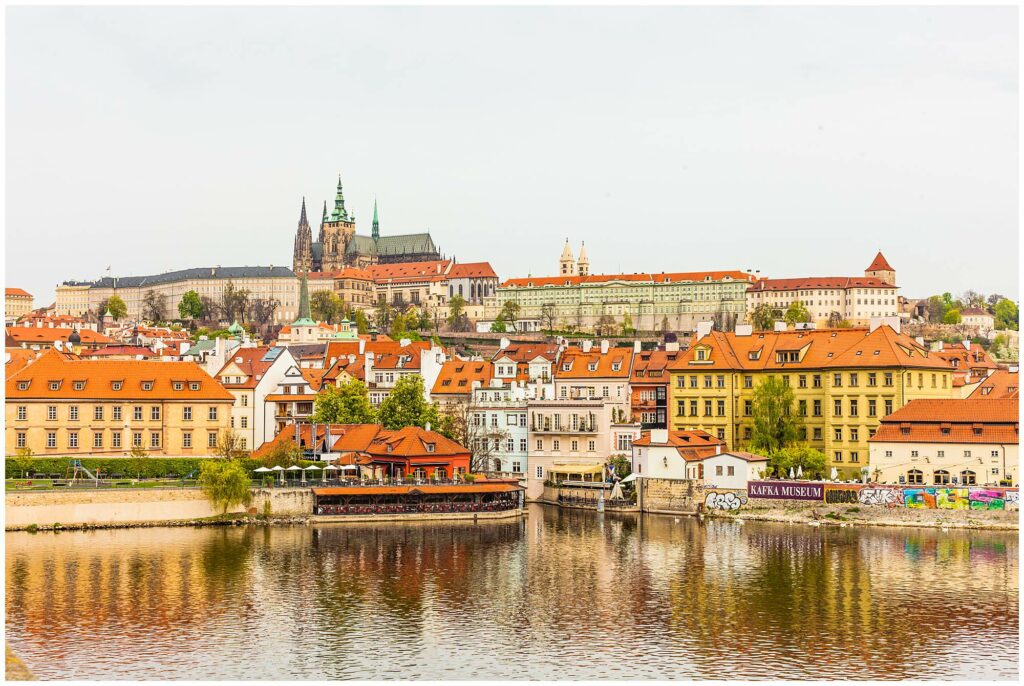
In sharp contrast with the Riomaggiore photo above, this is why I love cloudy days. Colorful cities can truly come alive with overcast days. By using the higher f-stop I was able to preserve more of the architectural details. Despite being on the opposite side of the Valtva River and more than half a mile away (on foot), the 50mm still provides the appearance of being close to Prague castle, despite the distance.
Travel Photography Tips for Beginners
- Start getting to know your camera settings. You can use Lightmate as a cheat sheet, but nothing replaces learning how your f-stop, shutter speed, and ISO all work together.
- Use the rule of thirds to frame your shot. If you can’t get the shot you want from where you are, remember that you can always crop your photo later. I try to minimize this as much as possible by spending time trying to get the shot right though. (I use Adobe Lightroom for all my post-processing tasks.) Remember, your point of view or perspective is what makes photography different and interesting.
- Get a tripod, especially if you are into night photography . After we lost my Targus tripod in Paris, we ordered this Amazon Basics lightweight tripod . It’s cheap and it gets the job done. Tom prefers it to our original tripod because he can carry it over his shoulder. I prefer it to our original tripod because the legs are easier to lock into place. (After 4 years of consistent use, we started to have trouble with the legs locking into place.)
- Plan your days. I love using the Photopills app to plan my photography. This app lets you see sunrise and sunset for a particular location, but it also gives you the timing for the golden and blue hours each day. Photopills is particularly helpful when you are planning dinner reservations. There is a lot more advanced functionality, but you can start with using it to plan your days.
- Play with your camera. Don’t put so much pressure on yourself! Photography is an art and science and it’s meant to be fun!
Follow along with Sara!

7 Christmas Market Trip Itinerary Ideas
You’ll also love.
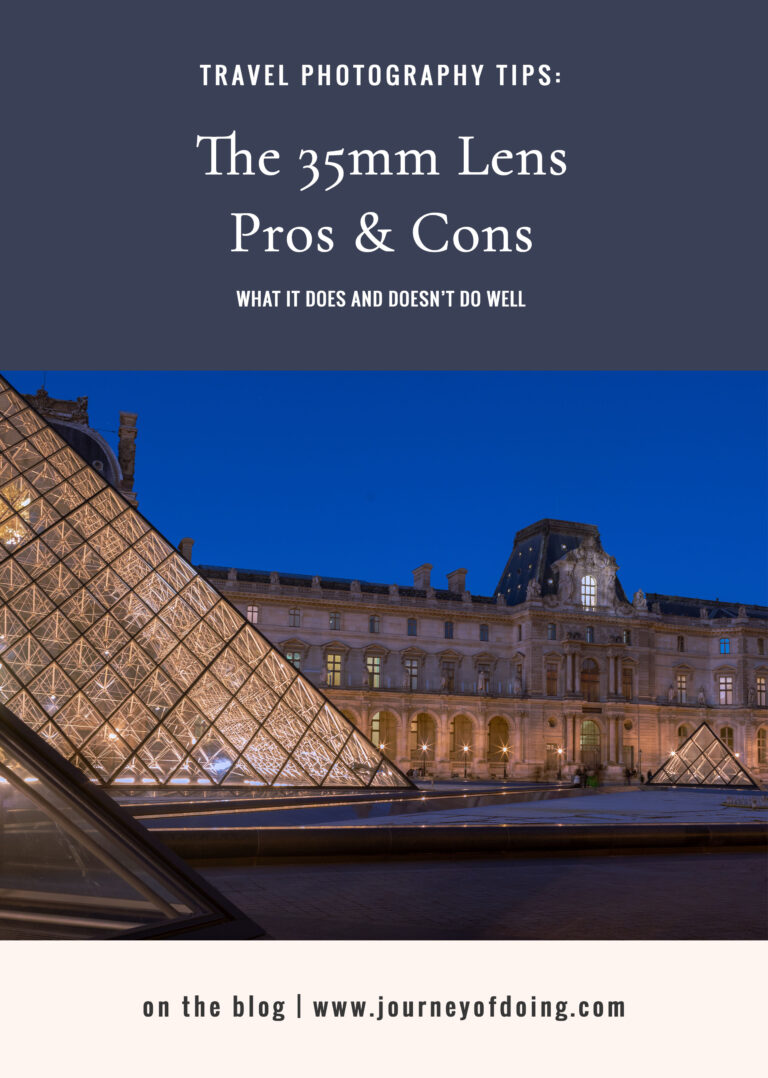
35mm Lens for Travel Photography
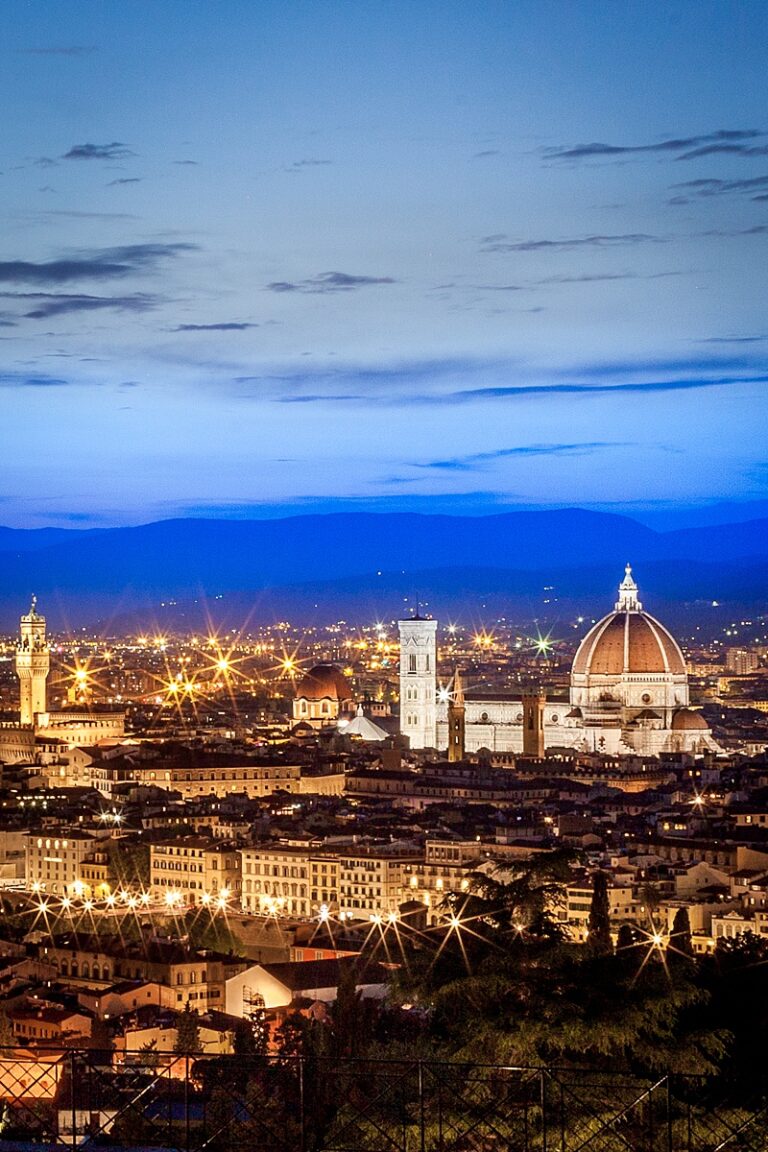
Must See: Piazzale Michelangelo Sunset & Camera Settings
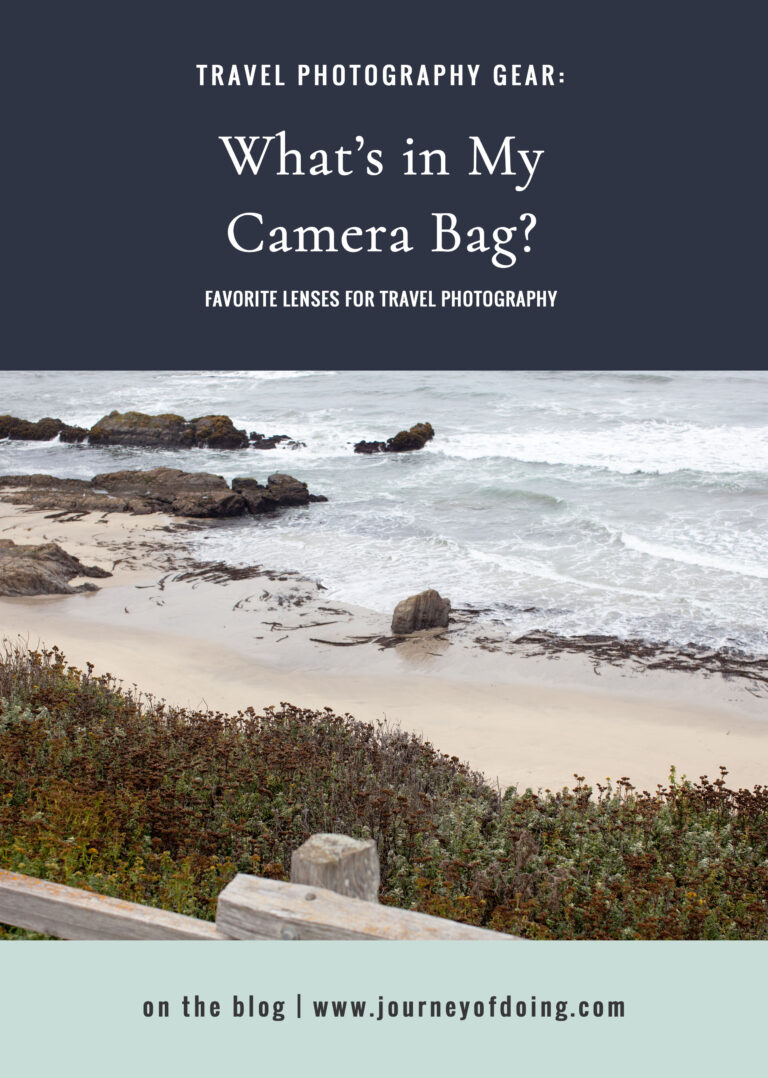
What’s in my Camera Bag
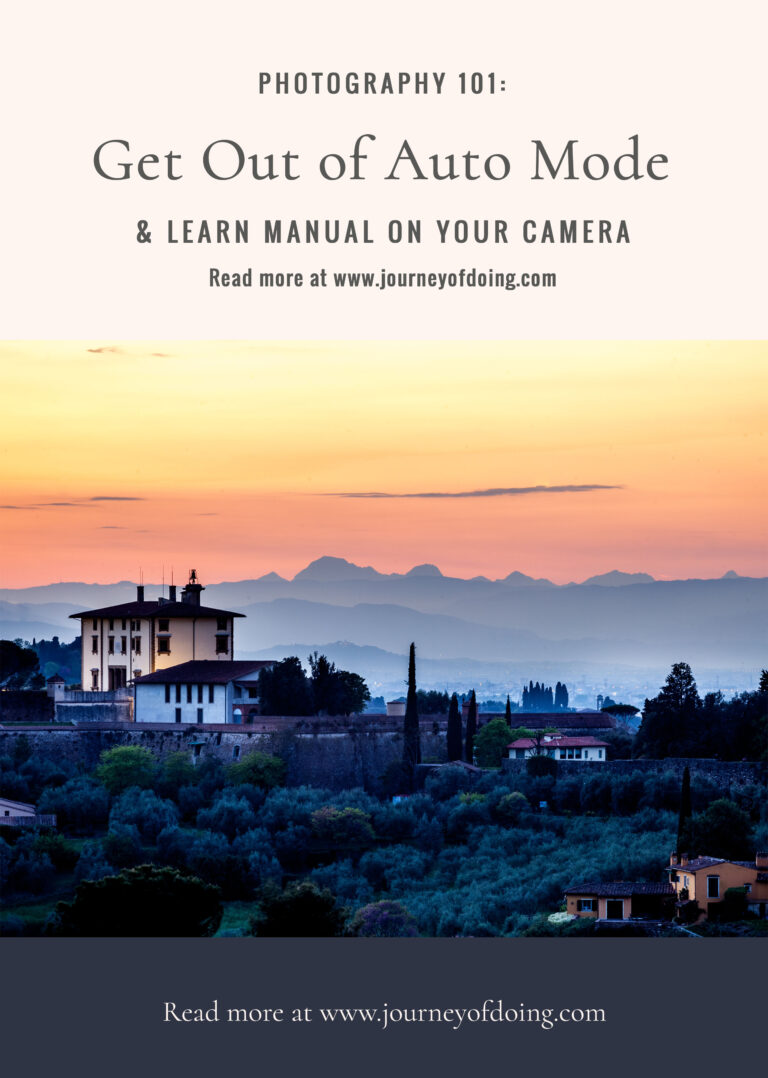
Get Out of Auto Mode and into Manual Mode on your Camera
Blurb discount for black friday.
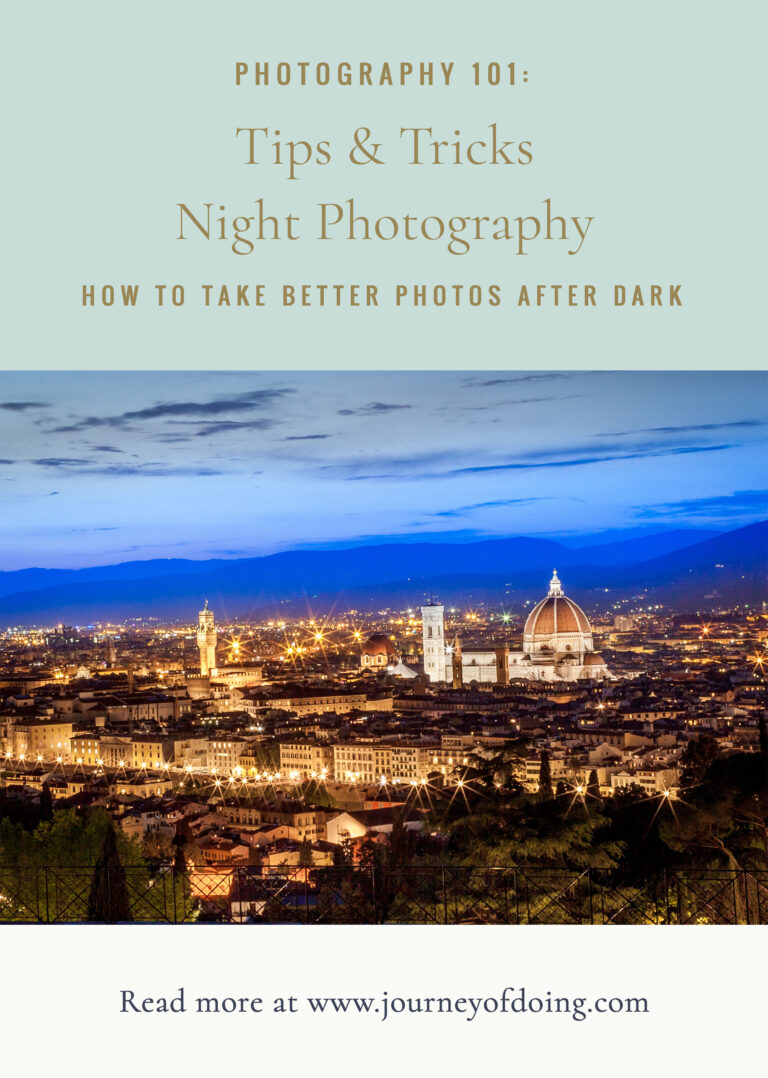
5 Easy Night Photography Tips
I need you to teach me your ways! Your images are always so incredibly gorgeous!
<a href=” http://www.greenfashionistablog.com ” title=”Green Fashionista”>Green Fashionista</a>
WOW! Such amazing shots with perfect clarity catching all the details of each scene.
I’m surprised you carry around a 50mm (or any fixed lens) when you travel.I’m always worried about taking up too much space in the camera bag and making it too heavy. But I agree that the 50mm is much better at getting gorgeous bokeh. Love the shots in this post. So beautiful!
I initially hated the 50mm a few years ago due to using a cropped sensor but since moving to full frame I absolutely love it. My last trip was to Morocco and I took 28mm, 50mm and 85mm. 90% of them taken with the 50mm.
Leave a Reply Cancel reply
Your email address will not be published. Required fields are marked *
Save my name, email, and website in this browser for the next time I comment.
What are you looking for?
What Is the Best Prime Lens for Travel Photography?
Travel photography is a staple genre of the craft and one that most photographers try at some point. However, with such a broad scope and the many other genres that it encompasses, it can be hard to keep your kit bag light. So, what's the best prime lens?
There is, of course, no correct answer, only opinions. Zoom lenses are particularly popular as walkaround, do-it-all options, but if you prefer primes or you need faster glass, a prime lens might be your only option. You then have the difficult task of working out which focal length best suits your needs.
The nifty-fifty has always been a favorite of photographers from a range of genres, but for some (myself included), it's something of a half measure. What many travel photographers opt for instead is a wider prime and in this video, TKNORTH discusses his new favorite, the Sigma 24mm f/1.4 DG HSM Art . That is particularly wide and fast, which lends itself to versatility, with wider shots on the menu, but also close-ups of subjects with a narrow depth of field and good subject separation from the background.
I have used a 24mm f/1.4 before and though I didn't expect to enjoy it as I gravitate towards far longer primes, I had to concede that it wasn't short of creative applications. For me, the success of a prime that wide is its widest aperture being so wide; had it have been an f/2.8, I would have wholly disagreed with the sentiment of this video.
What prime lens do you reach for when it comes to travel photography and why? Share your thoughts in the comment section below.
If you love travel and photography, consider checking out our Photographing the World Series with Elia Locardi where we go to some of the most beautiful locations in the world and teach the process of creating world class landscape images. Save 15% by using "ARTICLE" at checkout.
Robert K Baggs is a professional portrait and commercial photographer, educator, and consultant from England. Robert has a First-Class degree in Philosophy and a Master's by Research. In 2015 Robert's work on plagiarism in photography was published as part of several universities' photography degree syllabuses.

I find 24mm way to wide. To be honest 35mm will be bit more use I think if it comes to general purpose ....you can always pan for landscape....and it of course depends what camera you shoot....you can also crop when your camera delivers enough megapixels .
I'm going to agree. For me, a Fuji X-T3 shooter, my Viltrox 23mm f/1.4 (Full Frame 34.5mm Equivalent) is the perfect focal length for travel photography. Its versatile enough for everything that doesn't require a telephoto. If I was still shooting with Sony, I'd definitely get the Sigma 24mm.
Depends on camera and style. For crop sensor I use 24/50 combination, for full frame it’s 35/85.
No way, a 600mm F/4 is the one

I wonder for the various cute birds, has anyone found a way to convince them to volunteer for some portrait photos with a much shorter focal length, in return for compensation?
For example food, toys, or electronics?
A 24mm lens on crop body works well, but why the heck does it need to be f/1.4? This lens is nearly on par with Canon's 24-105 f/4 in terms of size and weight. Ok, travel preferences will vary. The Canon 24mm f/2.8 is a nice pancake lens, making the entire setup look like a toy and less obvious.
Low light, subject separation.
You describe special cases, not general usage. Traveling requires flexibility.
Flexibility in what exactly? If you limited to take one lens only I dont think the pancake lens will do the best job. 24/2.8 yet on a aps-c is pretty much like smartphone photos... Only the quality on pixel level is better
Give me a nifty -50. I’ll stitch in photoshop if it’s not wide enough.
I agree with other posts that for FF 35mm is the best. A touch wide but not distorting with the ability to stitch together frames.
Have not quite figured out the need for fast glass in the digital times, except for the bokeh and narrow DOF. In the film days fast glass allowed for a faster SS to handle the motion of clicking the shutter hand held! Why a travel lens at one focal point and fast glass today! When one travels you never know what you will see/come across, so a telephoto is the best to have. In the Sony world (since '14) you have several 2470, 70200 (f/4,2.8) the best is the FE 24-240mm F3.5-6.3 OSS (360 in APS-C mode) it is wide but has reach and is OSS where primes don't. How many cameras have IBIS so why use a prime without IS, you will also need sticks (extra for travel). After 8 years with most every Sony prime and telephoto lens I carry everyday in a teardrop bag a A7iii with the 24-240mm and the surprise the APS-C E 1018mm f/4 OSS (15-27mm) that is also 12-18mm in full frame (18mm if remove the light shield) that uses screw on filters and both lenses have the Haida Filters adapter that I can use the Clear Night filter at night. Be truthful, how many travel with a backpack of gear or even one lens. As far a bokeh/dof it is where you set you focus and mode, and for clarity near and far you will set f/# 2 stops above wide open. Truth, Yes when I travel away from home I have all my primes and telephotos for planned captures BUT for the unplanned everyday drive/walkabout it is my Teardrop bag. Today it is SW that gets clarity and or bokeh in the end!!!!

I like the 40mm Zeiss Batis. It's got some macro capabilities, autofocus, lightweight and is fast enough at F2.
Articles like these always leave me wondering "Why?". The usual motivations for carrying a prime are improved clarity, less weight, faster lens. But, even a simple comparison of, say, the Sigma 24mm mentioned in the article versus, say, Canon's RF24-105mm challenges those benefits. The Sigma weighs a "svelte"1.46 pounds (665 grams), while the Canon weighs a "whopping" 1.54 pounds (700 grams). The Sigma spec's don't mention image stabilization, so presumably there is none. Compare that to the Canon's 8 stops of IS when mounted on a Canon R5, and the Sigma's f/1.4 doesn't seem so impressive compared to the Canon's f/4.. Improved clarity? The reviews of both lenses suggest that, if you can see the difference in clarity, you're probably looking fhrough a microscope. So, for 35 grams, would I ever really want to give up the reach of a 24-105 zoom? Not in my lifetime, where that extra reach has enabled me to capture images not possible with a 24 mm prime. .
for me in M43 land, I have the Oly 12-42, and I will always also carry the 20mm Pana. size and weight I don't even realize it's in the bag, 100g. speed is huge, 2.8 for the Oly zoom, vs 1.7 for the Pana prime.
no brainer really.
Define the type of travel photography?
If it's for weeks at a time in a far off land (like I do), then there is no single lens. You need to build a kit that is light enough to get on the small turbo prop planes that get you out in the sticks.
I like shooting with 2x identical FF bodies at the same time. Therefore I carry:
20/21 F2.8 for landscapes + light travel CF tripod.
35 F1.4 + 85 F1.8/F1.4 for 90% of the shots, one on each body.
70-200 F4 for the long end.
Everything has to be able to be carried on, especially batteries, so weight is the killer.
Well, I chose the Leica Q2 as best travel combination for me (enough MP to crop and wide enough), but before owning that I'd have chosen the Fuji X100F which I owned previously, so 35mm would do as well.
On the EOS R system I'd take the lightweight RF 35mm f1.8 IS macro lens, which is a hell of an allrounder lens, unfortunately not weather sealed. I guess you find similar options for nearly every camera system.
Unbelivable that nobody had mentioned 28mm...
Since I had an Old pancake Nikon 28mm, I've found it more organic and cinematographic than the 35mm, less wide than a 24mm, making composition less busy.
Your phone is the best choice for travel 👌
for M43, the 20mm 1.7 Panasonic is always in my bag. lens weighs 100g, and is 2.5" diameter, and 1" length.
absolutely tiny. sharpness is great, where it drops off is on the focus speed, it is slow to focus. any other aspect though, it shines.
I struggled with this recently on a trip to Hawaii. I love macro and wildlife photography, but this was a couples excursion, not exclusively a photography one. I settled for my Nikkor Z 40mm f/2 and a Nikkor Z 24-200mm f4-6.3.
For me the issue with just a prime is sometimes when I'm traveling with family, I want to crop close without dragging my kids/wife across the street or make them wait while I sneak to get close enough to wildlife. A variable zoom is great and compact - maybe not getting any professional wildlife shots, but sharp enough for myself.
I can never go without a prime though, because for human subjects I just can't go without the ability to customize my f stop at more usable levels to isolate depth of field and enhance sharpness by limiting ISO. Do I usually keep it at f/4ish? Sure. But do I take quite a few shots at 2 or 2.8? You bet.
While it is not a prime lens, it is a fixed lens. The Sony RX 10 IV is a 24 to 600 mm Zeiss lens that is by far the best camera and lens for travel photography.
35mm 1.4. You can sit directly across from the people you are traveling with and take an environmental portrait with the perfect amount of subject separation from the background and foreground. In a tight room, it may seem not wide enough but often, just put the camera against the wall and it usually works. It really captures the moment without the distortion of a 24mm. I find that 24mm really doesnt solve the problem of not having a wide enough lens in a small sapce. You will get distorted faces and the the atmosphereis will be altered by inaccurately representing the size of the room. Once in a while you do run into a large landmarks that just wont work with a 35mm but you can either bring a 16-35mm or a 24mm. Or simply use a smartphone because you probably don't want much or any background blur anyways in a shot wider than 35mm.
My SLR days go back to a Nikon FTn back in 1974. I traded it in for Hasselblad for weddings, but when I went back to 35mm, i chose the super small Pentax ME with a pancake 40 f/2.8. It had a belt clip. I took it everywhere! Best lens focal length ever. Fast forward nearly 50 years, Nikon released the Z 40mm f/2. On a Z5, it's hard to beat for a concealable travel camera. I ordered the 28 f2.8 for my Z50. 42mm equivalent with the crop. Hard to beat it now. Small and light. Crazy sharp since I'm not using the edges!

- Jun 29, 2020
Travel Photography Gear: Nikon Z50 Review

It's taken me years (no kidding!) to find a good replacement for my trusty old Nikon D3. I ideally wanted something smaller and lighter, but with equally convincing image quality, plus an option to shoot great videos. Now that my travel photography gear collection has finally been expanded, read this Nikon Z50 review to find out why I believe it's the best camera for travel photography. Based on a few months of experience with the camera, testing different modes and pressing all the buttons, hopefully, I will be able to answer any questions you may have - sample images also included of course.
Disclaimer: As an Amazon affiliate, I earn from qualifying purchases
First of all , what sort of camera is the Nikon Z50?
The Z50 is a mirrorless camera, meaning it's compact in size and more lightweight than most DSLR brothers. For a travel camera particularly, the small size and weight is definitely something you will appreciate, having to carry it with you on tours and hikes. However much I love my Nikon D3 DSLR, after a while, it feels like I'm carrying a brick around...
At the same time, like the DSLR cameras, a mirrorless camera still comes with interchangeable lenses, so, if the kit lens is not enough, you can expand your collection and pick different ones depending on the nature of the shoot.
Nikon markets the Z50 as a 'camera for the rest of us'. I'm not sure what to make of the slogan really as it sounds kind of funny, but I guess the way you could interpret it is that it's suitable for both those with little photographic knowledge and those who are more advanced, just maybe not quite techy enough for the professional photographers. So, it's a great choice both if you are looking to upgrade from a phone or a compact camera or looking to downsize from a bulky DSLR. Depending on your skill set and desired level of involvement, you can use the fully automatic mode and let the camera make the decisions about the best settings, choose from a range of preset shooting modes (like sports, landscape, sunset etc.) or play around with all the settings in manual mode. I've done all three and got great results. The 'scene' modes are super handy when you don't want to dive into the individual settings.
The key camera stats:
(not going to get too technical here, just listing what I think is important from a user perspective and why it matters)
20.9MP APC-S sensor (not the biggest megapixel number I've seen, but unless you like to crop your photos a lot, I would actually prefer 20MP to 50MP, because image size! The more megapixels you have, the more space the photos will take up, both on the memory card and, afterwards, on your computer. With the amount of photos I transfer to my laptop after each trip, available disk space matters. For comparison, my Nikon D3 is 12 megapixel and I never felt that I needed more. It's more than enough for blog posts, social media as well as to print A4-size photo books.)
Body weight of 395 grams (nothing compared to 1.2 kilos for the Nikon D3! When I go hiking and carry it on my shoulder, I don't feel like I am lugging around a brick. I can hold it up in one hand with the arm stretched out to take a selfie without a problem.)
4K video at 30 fps and 1080 p HD video at 120 fps (personally, I am not bothered about 4K, HD is good enough for me, but, you know, it's there if you want to have the latest and greatest trends.)
Shoots photos at up to 11 fps (fast enough to get that perfect yawning cat shot - tested by me!)
Electronic viewfinder (while I don't always use it, it's an important option to have in case the conditions don't allow to effectively use the screen. Some manufacturers decided to lose this feature, which is a shame - Canon EOS M6 Mark II, a similar mirrorless camera, for example, only offers the viewfinder as an optional extra.)
3.2 inch rear screen is a touchscreen with live view and 'touch to focus' and 'touch to take a photo' features (I love being able to take a photo by touching - sometimes you just need that speedy reaction as opposed to starting to press buttons to move the focus point around. You literally just click on what you want sharp in the image and the camera focuses there and takes a photo.)
Rear screen can be tilted upwards and flipped to face the front (both of those I've been using a lot. The tilting comes super handy for shooting from awkward angles, for example, from the ground. If I didn't have the tilt option, I would have to lie down to be able to see what the camera captures - this way, I just crouch next to it and can see everything. The flipping makes selfies super easy.)

Face tracking/eye recognition (good for portraits, as it removes the need to move around the focus point manually.)
No in-body image stabilisation (but both kit lenses have image stabilisation.)
Wireless photo transfer to smartphone through the Nikon SnapBridge app (I find it a bit fiddly, but the cool thing is that you can choose whether you want to transfer the full-sized photo or a smaller version, so if storage space is an issue on your phone and you only want to post to Instagram, it's a nifty option to have)
Storage card type: SD/SDHC/SDXC; One card slot only. (Quite a common memory card format with lots of options available for all budgets. My Nikon D3 has two card slots, so it's possible to put .jpeg and .raw photos on different cards, but, to be honest, I haven't felt any inconvenience from only being able to use one memory card.)
One more thing I wanted to point out - compared to its direct competitors (Sony A6400, Fujifilm X-T30 and Canon EOS M6 Mark II), Nikon Z50 has the most protruding hand grip, which does wonders for comfort of holding. One of the issues of small mirrorless cameras for me is that they have shrunk down so much there's nothing to hold on to. That was a real downer when I was trying cameras out in the shops. I am happy to report that's not the case with the Z50 at all. It sits firmly in my hand and I don't worry about dropping it, so the ergonomics is definitely winning here.

So why did I buy the Nikon Z50 after years of indecision?
When looking for my next travel camera, I kept an open mind and researched and tried cameras from different brands and types (compact, bridge, mirrorless, DSLR). The competitors just weren't good enough in handling or image quality for me to forget about my Nikon lens collection, so in the end I resigned myself to having to carry a lot of weight around and was looking to buy another top of the range Nikon DSLR. But then I came across the Z50 and realised that in side-by-side image comparisons, in my opinion, it was coming out better than the flagship D4 and D850.
Ultimately, it was the image quality that did it for me, and, having now spent plenty of time taking photos with the Z50, I can confirm it hasn't disappointed. The images come out sharp and gorgeous.
Speaking of image quality, naturally, no camera review is complete without sample images and videos, so check them out. I used the 16-50mm kit lens throughout, so you can see what you get with the camera out of the box, without the need to invest in fancy professional lenses. Click on the photo to see a larger size.
Nikon Z50 sample images:

And here's a video filmed completely with the Nikon Z50:
What are the different kits and which one should I choose?
Naturally, you can get just the body of the camera, but there are several interesting bundles that you can buy that I recommend choosing from:
Nikon Z50 body + FTZ adapter
What on earth is an FTZ adapter you may ask and why would I need one? Well, the diameter of the lens mount on the Nikon Z-series cameras is different compared to the other Nikons (they call the other mount the F-mount). There aren't that many lenses on the market that were made for the Z-mount. The adapter allows you to be able to use the lenses made for the other Nikons and, as long as the lens has an integrated autofocus drive, the autofocus functionality will be fully supported.
If there is no drive in the lens, you will be able to focus manually with a focus box in the viewfinder turning green when the object behind it is sharp. It's not what you would want to use for photographing moving subjects, but is surprisingly easy to use for shooting landscapes and other stills.
This bundle is for you if you already have a Nikon DSLR with all the lenses you could need and that you definitely want to keep using. However, before you settle on this one, I would encourage you to check out bundle number 3 (body + FTZ adapter + 16-50mm lens) because the lens is pretty awesome and you will be saving weight and space not having to wear the adapter with it.
Nikon Z50 body + 16-50mm lens
In this kit, you get a great lens that, in my opinion, will cover most situations a travel photographer comes across. Sure, you wouldn't use it to take photos of birds far away in the sky, nor is it the right thing for something like whale and dolphin watching tours, where the subjects tend to be quite far away from the photographer, but mostly my travel shots consist of landscapes, architecture and some selfies, which this lens is ideal for.
All the reviews I read about this lens were glowing and, having tried it out myself now, I can confirm that they were not wrong - I love the quality of the photos! I've got other Nikon lenses, but to be honest, after playing around with a few for test purposes, I just left the kit lens on and that's what I use all the time.
The 16-50mm lens is tiny, which is ideal for something that you have to carry for a while. It also has built-in image stabilisation, to compensate for the lack of it in the camera body.
This bundle is for you if all you're after is a small-sized camera that takes great landscape to portrait photos and you're not really bothered about adding more lenses to your collection
Nikon Z50 body + FTZ adapter + 16-50mm lens
I've already described the adapter and the lens above, so I'll be short and sweet. This bundle is for you if a) you want to have a native kit lens, but also have a few F-mount lenses that you don't want to part with or b) you want to purchase several lenses and don't want to wait for Nikon to make more Z-mount ones (or you find the Z-mount lenses rather expensive, which they totally are)
Nikon Z50 body + 16-50mm lens + 50-250mm lens
If you like having a big zoom range, then this bundle might just be the thing for you. You get two kit lenses native to the camera, which together cover a very substantial zoom range. Both lenses also come with built-in image stabilisation. I haven't tested the 50-250mm lens myself, as I've decided that between the 16-50 lens and the other Nikon lenses I already own, I've got everything I need.
Sounds interesting? Then use the links below to see what sort of prices you would be looking at.
Check out available bundles and prices for Nikon Z50 on Amazon UK
Check out available bundles and prices for Nikon Z50 on Amazon US
So I've been waxing lyrical about the Nikon Z50 for what feels like an eternity, but do I have any gripes ? As a matter of fact I do have a few, no camera is perfect!
You have to flip a switch to change between photo and video mode as well as use different buttons to start a recording vs take a photo. My brain struggles to remember to do both. A bit disappointing thinking you're catching a cool moment on video to discover the switch was actually in photo mode...
A small gripe is that while the 'tap the screen to focus and take a photo' feature is great, I often end up taking random photos when trying to flip the screen out and back. You can disable that functionality if you find it annoying though.
If you want to use the selfie mode (i.e. flip the screen to face the same direction as the lens, so you can see yourself), you can't do that and use a tripod in the conventional way, because the screen flips down to where the tripod is and will be obstructed. Fortunately, there is an inexpensive solution for this problem - Smallrig made a special mounting plate that shifts the location of the tripod to the side.
Shop Smallrig mounting plate on Amazon US
Shop Smallrig mounting plate on Amazon UK
And that is all. I am in love with my Nikon Z50 and if this post has convinced you to get one too, I hope you love it just as much as I do!
#travelessentials #photography #shopping
- Product Review
Recent Posts
8 Must-Have Train Travel Accessories
Best Travel Games for 2 Adults
Best Travel Kettle - Researched, Tested, and Reviewed
The best 50mm lens in 2024: which 'standard prime' is the right one for you?
The best 50mm lens, or nifty fifty, is a great low-cost wide-aperture lens for bokehlicious portraits and for low light
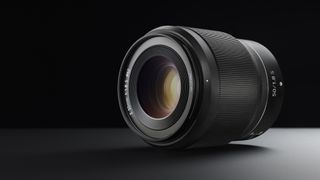
- Micro Four Thirds
- Multi-mount
The best 50mm lenses are an essential addition to the camera bag of any serious photographer. These lenses, also referred to as 'standard' lenses or 'nifty fifties', capture a perspective that's roughly equivalent to the field of the view the human eye can see, making them an ideal choice for capturing imagery with a naturalistic feel.
• The best camera lenses to buy • Best Canon lenses • Best Fujifilm lenses • Best Nikon lenses • Best Olympus lenses • Best Panasonic lenses • Best Pentax lenses • Best Sony lenses
These lenses also run the gamut in terms of price – it's possible to spend a four-figure sum on some of the best 50mm lenses out there, but there are also some ultra-budget optics at there that offer surprisingly good quality for a minimal outlay. Of course, spending more will mean you get better features – a wider maximum aperture up to f/1.4, or even f/1.2, for instance. Cheap lenses tend to top out at f/1.8, which is still pretty useful in low light, and they have their own advantages too, as their simpler optical builds make them lighter and more portable.
There's a lot of choice out there, that's for sure. That's why we've put together this extensive guide of 50mm lenses for all the major mounts that are out there right now, as well as some that are available for multiple systems. We've split the guide into sections to make it easier to navigate, so you can easily find your system of choice.
Best 50mm lens: Equivalent focal lengths
Why you can trust Digital Camera World Our expert reviewers spend hours testing and comparing products and services so you can choose the best for you. Find out how we test.
One thing that's worth being aware of is that a 50mm lens does not always produce the field of view of a 50mm lens, depending on the sensor size of the camera you're using. On an APS-C body, such as a Fujifilm X camera, the same lens will have an effective focal length of 75mm (80mm for Canon ), making it a better fit for portraiture.
Shrink down to a Micro Four Thirds camera, and a 50mm lens will have an 100mm effective focal length, more suitable for really tight portraits and short telephoto shooting.
With that in mind, the MFT lens we've included here is a bit less than 50mm: its 42.5mm focal length equates to 85mm in full-frame terms. Many regard that as spot-on for portraiture.
Whichever camp you’re in, a ‘nifty fifty’ might well be the only prime lens you ever buy, so it pays to get a good one. Even so, nobody likes spending over the odds. So let's take a look at the best 50mm lenses available right now...
The best 50mm lens in 2024
Canon ef & rf 50mm lenses.
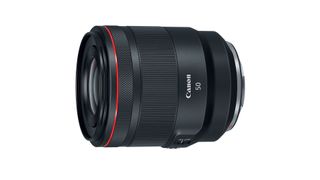
1. Canon RF 50mm f/1.2L USM
Our expert review:
Specifications
Reasons to buy, reasons to avoid.
Sure, it's too big for the cameras it's made for. Sure, it costs about the same as a new EOS R camera. All these are valid points. But... well, if you use the RF 50mm f/1.2L USM, you'll understand. It is quite simply a beautiful lens that radically redefines what the L series is capable of. Real-world results are near-flawless, with exceptional sharpness even wide open at f/1.2, and the customisable control ring allows you to really make the lens your own and have it handle exactly the way you want it to. There's weather-sealing too, and a super-speedy autofocus system: in short, everything you could want from a lens of this type. It's an incredible feat of engineering by Canon.

2. Canon RF 50mm f/1.8 STM
While the RF 50mm f/1.2L USM is a stunning lens, its price means it's out of reach for many EOS R series users. That's where the new RF 50mm f/1.8 STM comes in - a cheap, compact and capable standard prime lens. The great news too is that image quality hasn't been compromised - our tests show that it's on par in some areas with the much pricier f/1.2 variant, while the build quality is noticeably better than the EF equivalent (though it's worth bearing in mind it's not weather sealed). Focusing is also very good, with the stepping motor (STM) used offering quick and quiet focus, which is fast enough to stills and smooth enough for video. The Canon RF 50mm f/1.8 STM is a fantastic everyday lens that pairs well with any RF body.
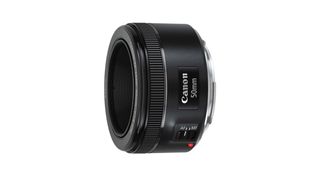
3. Canon EF 50mm f/1.8 STM
Canon’s 25-year-old 50mm f/1.4 lens might seem the obvious choice, but we prefer this newer option . It’s two-thirds of an f/stop slower, but is less than a third of the price, is much lighter and has better performance.
Unlike previous f/1.8 editions, the ‘STM’ model has a stepping motor autofocus system that gives speedy yet quiet operation. The focus ring no longer rotates during autofocus, which improves handling, as well as enabling manual override in Single AF mode.
The lens has a metal rather than plastic mounting plate, and a better-rounded aperture based on seven diaphragm blades instead of just five.
After testing multiple samples of the Canon 50mm f/1.4 and f/1.8 lenses, we've found the f/1.8’s autofocus system to be much more accurate and reliable than its older sibling. Sharpness is also better than from Canon’s 50mm f/1.4 lens, from the centre to the edges.
Colour fringing is minimal at wide apertures and negligible at other apertures. There’s a little more distortion than with some rival lenses, but it’s rarely noticeable. Considering its accessible pricing, this lens is a great value budget buy.
Nikon F & Z 50mm lenses


4. Nikon Z 50mm f/1.8 S
Nikon 's standard prime for its full-frame mirrorless Z cameras packs a 12-element optical stack which includes two ED glass elements as well as two aspherical elements to boost contrast and vibrancy.
Externally, the Z 50mm is noticeably bigger and heavier than a good old F-mount Nikkor AF-S 50mm f/1.8G , but compared with some F-mount 50mm alternatives from Sigma and Tokina , it’s pleasingly portable.
The lens barrel features just a single AF/MF switch, but the wide, tactile and precise manual focus ring isn’t redundant if you’re using autofocus, as it can also be set in-camera to adjust exposure compensation or ISO sensitivity.
Nikon has made much noise about the Z-mount's larger 55mm inner diameter and shortened distance between lens flange and image sensor, versus Nikon's F-mount. It's all supposed to add up to increased image quality.
This isn't just hype though, as the Z 50mm is terrifically sharp, only fractionally down on the significantly pricier Z 35mm f/1.8 S, and that’s the sharpest lens we’ve ever tested.
Aberrations are practically non-existent at any aperture, as is distortion, and the lens's stepping motor autofocus never missed its mark in our testing.
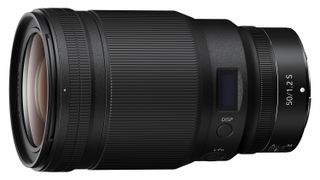
5. Nikkor Z 50mm f/1.2 S
Up to now, if you wanted a Nikon Z-mount prime faster than f/1.8, you'd have to remortgage your house and fork out for a Nikkor 58mm f/0.95 Noct . When compared to that lens, this 50mm f/1.2 S could almost be called cheap. However, there's no getting around the fact that at 150mm long and over 1kg in weight, this is one hefty 50mm prime. This 17-element pro lens incorporates advanced coatings like anti-reflection ARNEO and Nano Crystal Coat, along with a 9-blade rounded diaphragm. The exterior is fully weather sealed and features a video-friendly silent control ring, along with a customisable Fn button and OLED info panel that displays important data.
Read more Nikkor Z 50mm f/1.2 S review

6. Nikon AF-S 50mm f/1.4G
Compared with a Nikon-fit Sigma 50mm f/1.4 DG HSM | A or a Zeiss Milvus 50mm f/1.4, Nikon’s own-brand lens is only half the physical length and about a third of the weight. It’s simpler than the Sigma, with eight rather than 13 optical elements, and rather less robust than the metal-jacketed Zeiss.
A further sign of the downsizing is that the Nikkor only has a 58mm filter thread, which is quite small for a 50mm f/1.4 lens. The straightforward optical path doesn’t contain an aspherical element (as featured in Nikon’s more budget-oriented 50mm f/1.8), and there are neither any ED (Extra-low Dispersion) elements nor any Nano Crystal Coat.
Autofocus accuracy is more critical in very wide-aperture lenses and the Nikkor does well in this respect, unlike Canon’s f/1.4 counterpart. Sharpness is average at f/1.4, but stop down to f/2.8 and this lens delivers superb sharpness across the entire image frame.
Lateral chromatic aberrations are minimal, though longitudinal fringing is present when wide-open. A nine-blade diaphragm helps to maintain smooth bokeh when stopping down a little. The only weak link is distortion, which is worse than we'd like for a standard prime. Overall, this lens is worth the extra outlay compared with the less expensive Nikon AF-S NIKKOR 50mm f/1.8G optic.
Sony E 50mm lenses
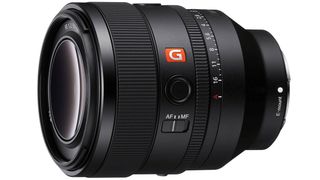
7. Sony FE 50mm F1.2 G Master
Sony 's 50mm lens range is now very extensive, but we reckon its latest 50mm f/1.2 G Master optic is the best of the bunch. Although it feels quite bulky on a Sony mirrorless body, it’s still fairly compact and reasonably lightweight for an f/1.2 lens. The weather-sealed construction feels of fully professional-grade quality, there are two customizable function buttons that fall naturally under the thumb in both landscape and portrait orientation shooting, and the manual aperture ring comes complete with a de-click switch for stepless control during video capture. Unlike most ultra-fast lenses, the Sony maintains spectacular sharpness across the entire image frame, even when shooting wide-open. Bokeh is beautifully smooth and both lateral and axial color fringing are very negligible. There’s noticeable vignetting when shooting at f/1.2 but this pretty much disappears by f/2, and automatic in-camera correction is available anyway.
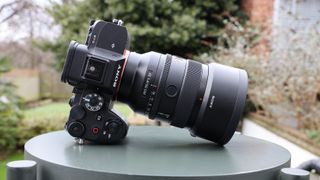
8. Sony FE 50mm f/1.4 GM
The Sony FE 50mm f/1.4 is the lens that is most suited to most Sony users, with its impressively light and compact build, however, it does not compromise one bit on optical quality, and this lens is almost perfect when it comes to sharpness in the center with only a small falloff towards the edges of the frame and some vignetting wide open, this lens gets almost full marks.
If you don't need the extra aperture stop, (which most shooters don't) or the added size, weight, or considerable cost of the FE 50mm f/1.2 GM, then the Sony FE 50mm f/1.4 will serve you perfectly.
The lens is expensive when compared to third-party glass that will achieve similar results, however, not with quite the same size and weight, lightning-fast autofocus, and reliable moisture-resistant construction that this lens offers.
Read our full Sony FE 50mm f/1.4 GM review .
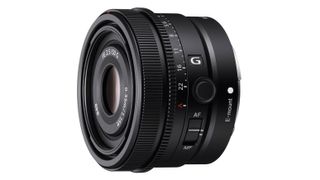
9. Sony FE 50mm f/2.5 G
Unlike many high-profile 50mm lenses with very fast max apertures, the FE 50mm f/2.5 is extremely small, extremely light and extremely practical. It can go places where you just wouldn’t take a bigger lens: with a lens this size you can shoot all day without getting arm-ache. Its maximum aperture of f/2.5 might sound very tame by today’s standards, but it’s still faster than even a pro zoom lens, while being a fraction of the size and cost. Performance-wise, this lens is just terrific. Sharpness is sensational, especially between f/2.8 and f/5.6, and chromatic aberration is almost invisible. The dual linear AF motors do their work silently, smoothly and quickly, and though there no stabilisation, all current Sony A7 (and A9) cameras have in-body stabilisation anyway.
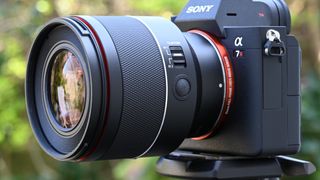
10. Samyang AF 50mm f/1.4 FE II
The original edition of the Samyang AF 50mm F1.4 FE II was Samyang’s first ever autofocus lens, launched in celebration of the company’s 50th year in the business. Five years down the road, the Mark II features a new and improved autofocus system which is faster and more consistently accurate. Although relatively compact and lightweight for a modern 50mm f/1.4 lens, the Samyang packs some impressive features. Its new linear stepping motor-based autofocus system is super-fast for stills capture and works well for Sony’s face- and eye-detection AF, complete with highly effective tracking. It also enables smooth autofocus transitions for movie capture, the latter with minimal focus breathing, so the focus position doesn’t change when you adjust the aperture.

11. Sony Zeiss Planar T* FE 50mm F1.4 ZA
If f/1.4 is fast enough for your purposes and you don't quite fancy the asking price of the G Master lens above, the Sony Zeiss Planar T* FE 50mm F1.4 ZA is an excellent choice. It's a bulky, heavy lens, designed around the tried-and-tested Zeiss Planar concept designed to enhance image quality. In our review, we found center-sharpness, contrast and color fidelity of the lens to all be absolutely exceptional, and the quality of the bokeh to be delightfully smooth and creamy thanks to the 11-blade diaphragm. Is it a bit of a monster for 50mm, in terms of both size and price? Yes, but there's a lot going on under the hood here, and it's a credible alternative to the G Master.

12. Sony FE 50mm f/1.8
Not everybody has the money for G Master and Zeiss lenses, and if you just need a simple 50mm for your Sony camera that'll get the job without costing the earth, here it is. The Sony FE 50mm f/1.8 performed well in our tests when we subjected it to a full review, with good sharpness and distortion control. Things do soften up when the lens is wide open at f/1.8, and there is some severe vignetting at this aperture, but otherwise performance is pretty excellent. One thing to be aware of though is that the autofocus is quiet but not silent, which will be a concern if you're planning to shoot video.
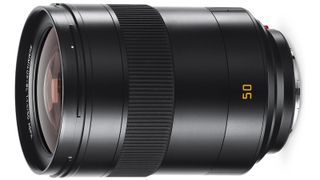
13. Leica Summilux-SL 50mm f/1.4 ASPH
All right, we'll wait until you're finished fainting at the price tag. All done? Right – while we're going to admit that this expensive lens is not for everyone, we have to also be fair and say that it is one of the sharpest lenses we've ever tested – ever. The Leica Summilux-SL 50mm f/1.4 ASPH is ludicrously well constructed, inside and out, and the reason it weighs more than a kilogram is because it's packed with some of the finest glass in optical engineering. If you need the best of the best to pair with your Leica L-mount camera, this is the buy to make – it's absurdly sharp even with the aperture wide open or stopped fully down, and in the mid-range it's simply scintillating. What a lens.
Fujifilm X 50mm lenses
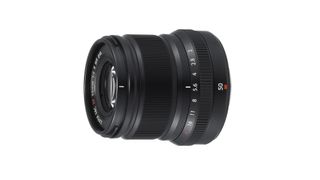
14. Fujinon XF50mm f/2 R WR
Available in black or silver, there’s no denying that the Fujifilm XF50mm looks a bit pricey for an f/2 lens. Indeed, it has the slowest aperture rating of any lens in this test group.
However, it’s impeccably built, with comprehensive weather-seals, a physical aperture ring for refined Aperture Priority and Manual mode shooting, and a high-grade optical path that includes an aspherical ED (Extra-low Dispersion) element. The nine-blade diaphragm is well-rounded.
Autofocus is virtually silent. As with other ‘stepping motor’ systems, the focus ring is electronically coupled and, in this case, enables particularly precise manual control.
On Fujifilm X cameras, the lens has an effective focal length of 75mm and delivers a tight depth of field at f/2, making it a great portrait lens. Wide-open sharpness is excellent across the entire image frame, there’s very good resistance to ghosting and flare, and fringing is practically impossible to spot at wide apertures. There’s a very slight hint of pincushion distortion, but it’ll generally go unnoticed.
Micro Four Thirds 50mm lenses

15. Panasonic Lumix G 42.5mm f/1.7 Asph P.OIS
Micro Four Thirds lenses only need to produce a relatively small image circle, and this Panasonic is typically compact and very light at only 130g - a fraction of the weight of some premium prices for DSLR cameras.
With its effective focal length of 85mm, the Panasonic is ideal for portraiture and the f/1.7 aperture enables a fairly tight depth of field. It’s well-engineered and features an optical image stabilizer.
This makes it ideally suited to Panasonic cameras; for Olympus bodies with sensor-shift stabilisation, we’d go for the Olympus M.Zuiko Digital 45mm f/1.8.
Autofocus is quick and accurate, while color fringing is essentially a non-issue, as even Raw files are automatically corrected. There’s the merest touch of barrel distortion but you’re unlikely to notice it. Sharpness is good, but not great, and many other rival optics manage better centre-frame sharpness.
With its relatively ‘telephoto’ effective focal length, this lens's optical stabilization will clinch the deal for MFT shooters whose cameras don’t have an in-body stabilizer.
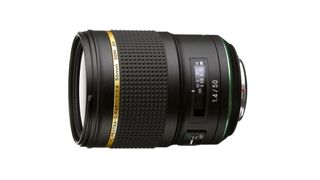
16. HD Pentax D FA* 50mm f1.4 SDM AW
The HD Pentax D FA* 50mm f1.4 SDM AW represents Pentax's the first in a new generation of Star-series optics that have been designed for use with the both the full-frame K-1 and K-1 Mark II DSLRs. Designed to deliver the highest in-house standards both for current and future Pentax DSLRs, this 50mm lens features Aero Bright Coating II - a lens-coating nanotechnology employing a super-low refractive film fabrication process, while the lens also incorporates three super-low dispersion glass elements and one aspherical element. A large and heavy lens at almost 1kg, it's both dust-proof and weather-resistant, as well as enjoying a newly developed ring-type SDM (Supersonic Direct-drive Motor). It's pricey, but if you're looking for a high quality standard prime for your full-frame Pentax DSLR, this is the best 50mm lens you can buy.

17. Pentax smc DA 50mm f/1.8
So-called ‘portrait primes’ are often fairly big, heavy and expensive, but this Pentax lens is none of those things. At just 1.5 inches long and 122g in weight, it’s really compact and lightweight, yet still delivers a 76.5mm effective focal length with a fast f/1.8 aperture on Pentax APS-C format DSLRs for which it’s designed. It lacks an autofocus motor and is somewhat basic in some respects but that’s reflected in the refreshingly affordable purchase price. Read our full S MC Pentax DA 50mm f/1.8 review .
Multi-mount 50mm lenses
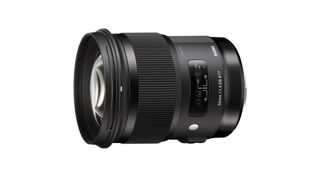
18. Sigma 50mm f/1.4 DG HSM | A
Sigma’s previous 50mm lens was renowned as being a heavyweight, but the replacement ‘Art’ edition really piles on the grammes. It gains 50 per cent in physical length and rises from 505g to 815g in weight.
The main reason for the Art lens’s weight gain is that it has a much more complex and sophisticated optical path than its predecessor, based on 13 rather than eight elements. These include one complex aspherical element and three SLD (Special Low Dispersion) elements.
Build quality feels superb, although there are no weather-seals and the focus ring doesn’t quite have the tactile fluidity of a lens like the Zeiss Milvus. But you can count on the Sigma’s autofocus system to be fast and accurate.
The Sigma is amazingly sharp, even at f/1.4, along with soft, creamy bokeh. Sharpness only drops off at f/1.4 in the extreme corners of the image frame. Colour fringing is very minimal at any aperture, even at the corners of the frame, and barrel distortion is absolutely negligible.
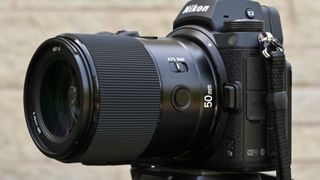
19. Yongnuo YN50mm F1.8Z DF DSM
Third-party lenses can often be a way to snag some real bargains – case in point, this inexpensive lens for full-frame Nikon Z and Sony FE cameras that nevertheless punches above its weight. The Yongnuo YN50mm F1.8Z DF DSM is built to a pleasing standard of quality, and has a few clever handling features like the two L-fn buttons that can be assigned to your preferred functions. Optical quality is generally pretty good – there's some noticeable pincushion distortion and lateral chromatic aberration, but both can be corrected pretty easily with software. We do wish the bokeh was a little less fidgety – there are definitely smoother 50mm f/1.8 lenses out there. Overall though, this is an impressive package.
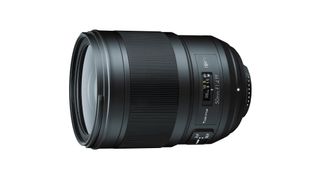
20. Tokina Opera 50mm f/1.4 FF
Designed to be the start of a high-end Opera series, this lens is positioned above the company's AT-X lens line and rivals Sigma and Tamron’s latest premium offerings.
Inside is a 9-element optical stack that contains three SD (Super-low Dispersion) elements and one aspherical element to minimise chromatic aberrations, while a new ELR (Extremely Low Reflection) coating reduces ghosting, flare and reflections.
The Opera 50mm is dust and moisture resistant, and though its AF system is of the ring-type ultrasonic variety rather than a more modern stepping motor design, it's fast and reliable.
But it's the Opera's image quality that impresses most. Sharpness is excellent, even wide open at f/1.4, becoming simply sublime from f/2 right through to f/11. Purple fringing is very well controlled, right at the corners of the frame, and you can forget about distortion, as there simply isn't any.
The Opera 50mm will cost you a sizeable chunk more cash than the already-pricey Sigma 50mm f/1.4 DG HSM | A, but it is the new sharpness benchmark for a Canon or Nikon DSLR standard prime.
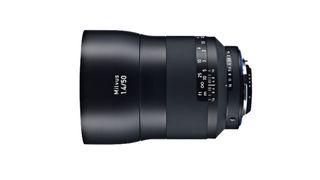
21. Zeiss Milvus 50mm f/1.4 ZF.2
Autofocus cameras have been around since 1977, so it might seem strange that Zeiss is still doggedly making manual-focus lenses. However, the range of Milvus prime lenses certainly gives a hands-on, feel-good factor.
The 50mm f/1.4 is typical in having a beautifully engineered metal barrel and a full set of weather-seals. The optical design is based on Zeiss’s legendary Distagon principles. The long rotational travel of the focus ring helps focusing precision, and its super-smooth fluidity makes focusing a joy.
The Nikon edition has a physical aperture ring with a de-click facility, to enable smooth aperture transitions during movie capture. This ring is absent on the Canon edition.
Living up to its reputation and price tag, the Milvus delivers gorgeous image quality. Wide-open, it combines superb contrast and stellar sharpness across almost the entire frame.
There's beautiful bokeh, and the lens maintains a lovely smoothness in defocused areas when stopping down a little. Colour fringing is almost a complete non-issue with this lens, even in the corners.
There’s a little more distortion than in Tamron's SP 45mm f/1.8 Di VC USD, but less than in competing 50mm primes from Canon and Nikon.
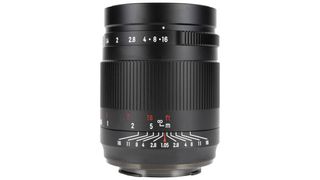
22. 7Artisans 50mm f/1.05
The super-fast 7Artisans 50mm f/1.05 combines impressive sharpness - even wide open at f/1.05 - with sumptuously smooth bokeh. When it comes to image quality, that’s the perfect combination for a lens of this class. Added bonuses are that both lateral and longitudinal color fringing are negligible, and barrel distortion is very slight. The lens lacks autofocus and has no built-in electronics, so focus and aperture have to be adjusted via the on-board control rings. Even so, it’s amazingly small and lightweight for such a fast-aperture lens, is strongly built and has refined handling characteristics, making it standout value for money.
How we test lenses
We test lenses using both real world sample images and lab tests. Our lab tests are carried out scientifically in controlled conditions using the Imatest testing suite, which consists of custom charts and analysis software that measures resolution in line widths/picture height, a measurement widely used in lens and camera testing. We find the combination of lab and real-word testing works best, as each reveals different qualities and characteristics. See more on how we test and review at Digital Camera World .
• The best wide-angle lenses for Canon • The best wide-angle lenses for Nikon • The best 70-200mm telephoto lenses • Best portrait lenses
Get the Digital Camera World Newsletter
The best camera deals, reviews, product advice, and unmissable photography news, direct to your inbox!
Matthew Richards is a photographer and journalist who has spent years using and reviewing all manner of photo gear. He is Digital Camera World's principal lens reviewer – and has tested more primes and zooms than most people have had hot dinners!
His expertise with equipment doesn’t end there, though. He is also an encyclopedia when it comes to all manner of cameras, camera holsters and bags, flashguns, tripods and heads, printers, papers and inks, and just about anything imaging-related.
In an earlier life he was a broadcast engineer at the BBC, as well as a former editor of PC Guide.
Related articles
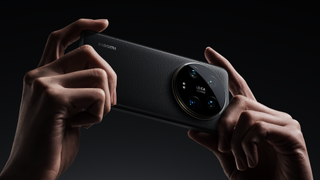
The leading authority in photography and camera gear.
Become a better photographer.
12.9 Million
Annual Readers
Newsletter Subscribers
Featured Photographers
Photography Guides & Gear Reviews

Best Travel Camera for your Photography Adventures
Need the best travel camera to take on your next trip? Lightweight, high performance and affordable - this in-depth guide reveals the 6 top options!
Camera Gear Guides | Camera Guides | By Mark Condon | Last Updated: April 11, 2024
Shotkit may earn a commission on affiliate links. Learn more.
Finding the best travel camera has been something of a never-ending quest of mine over the years.
Whether I’m travelling to shoot a destination wedding or simply on holiday with my wife and kids, I always try and carry some form of camera in my travel bag.
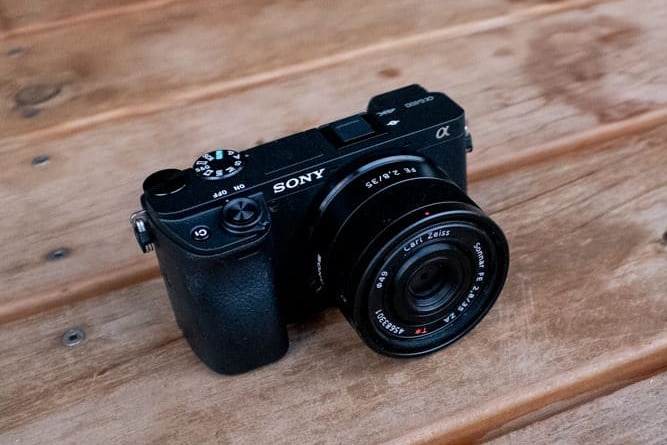
Offers incredible autofocus and amazing image quality in a compact, affordable body.
Even though you still see the odd tourist sweating under the weight of a bulky DSLR and zoom lens, the savvy traveller knows that the latest mirrorless cameras deliver the same image quality at a fraction of the size.
Capturing photos whilst travelling is essential, and having something small and lightweight to do it with is the goal.
Sure, everyone’s got a smartphone in their pocket that’s up to the job, but a dedicated camera for travel blogging is far superior.
If you really value your holiday memories, trust me – invest in a good travel camera. Ensure your new experiences are captured perfectly, for you and your family to enjoy for years to come.
Now, let’s look at the best travel cameras here in 2024.
- Don’t miss our essential travel photography tips
Table of Contents
Best Travel Cameras in 2024
Remember, all these recommendations are cameras that I can imagine the average person who cares about the quality of their images taking on holiday with them.
They’re not absolute bargain basement prices, (although I do include my choice of the best budget travel camera), and similarly, they’re not priced solely for the realm of pros.
Each camera will blow your smartphone out the water in terms of image quality and features, and teach you the fundamentals of photography at the same time… without being a pain in the a** to use.
In short, these are the cameras I’d recommend to any good friend who needs something to record all the precious memories on their next trip.
1. Sony a6400 | All Round Best Travel Camera
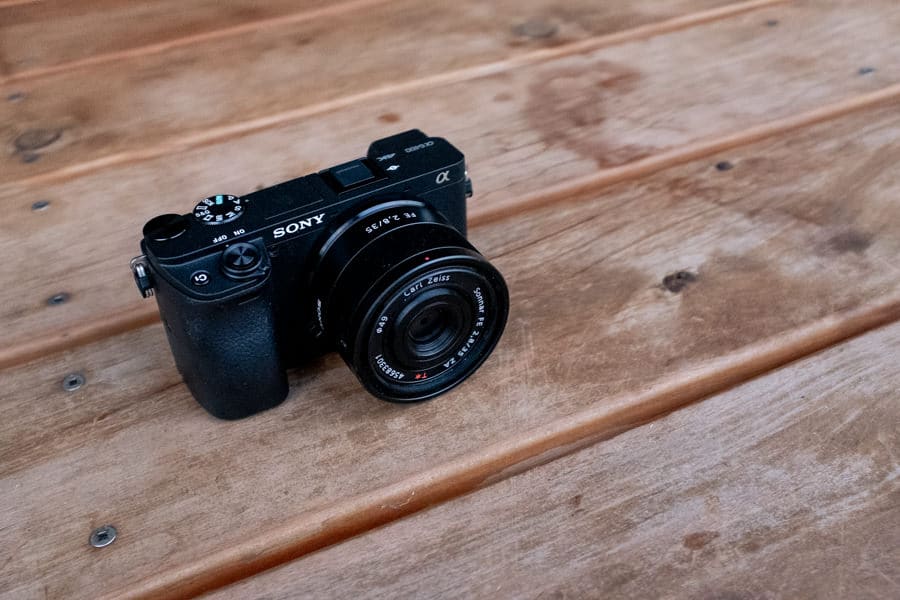
See More Reviews
Type: Mirrorless APS-C sensor camera Megapixels: 24.2 Size: 4.72 x 2.64 x 2.36 (120 x 67 x 60 mm) Weight: 403 g (0.89 lb) More Info: Sony a6400 Review
This is by far the best camera for travel photography.
The Sony APS-C sensor a6 series has been the best selling mirrorless cameras in history. Releasing what seems like a new camera body each year, it can be rather confusing which one to choose.
Last year, I spent a month with the Sony a6400 – despite newer models existing (a6100 and a6600), the a6400 is still the best bang for your buck travel camera, here in 2024.
Looks-wise, it’s hard to tell the a6400 from any of the other versions, although there’s a lot that’s changed since its predecessors.
The Sony a6400 boasts a much-improved build quality, with the standout feature of a touch-enabled, 180 degree rotating LCD screen – much to the delight of vloggers and the selfie crowd .
There are surprisingly few cameras that offer a front-facing LCD screen, but the a6400 handles this gracefully, allowing for some creative composition options while travelling.
This is one of several features that put the a6400 ahead of my previous choice of top travel camera of the year – the Fujifilm X100F ( review ), that offered no such LCD swivelling.
Another stand out feature is the best-in-class AutoFocus, which offers a frankly mind-blowing 425 phase-detects points, Real-time Eye AF (which also works on animals!), and Real-time tracking for moving subjects – it also works really well in a studio environment with static subjects.
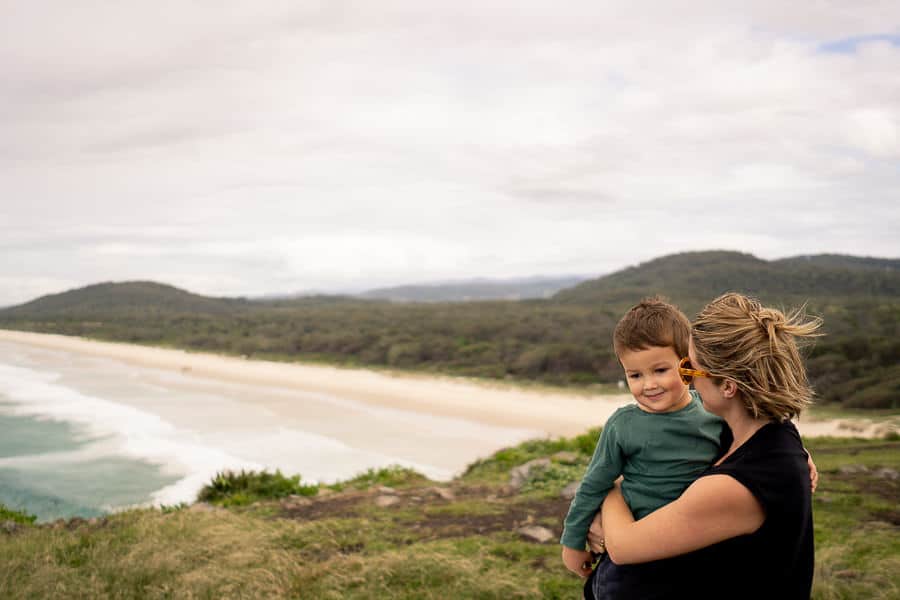
Great wide-angle with shallow depth of field by using the Sony a6400 + Sony FE 28mm f/2 | 1/4000 f/2 ISO100.
The a6400 also continues the trend of 11FPS with continuous AF, much like the first model which was released over 5 years ago.
To say that this is a camera that can handle the most demanding focusing situations while traveling would be an understatement.
A couple of years ago, Sony unveiled its flagship full frame mirrorless camera, the a9. Those that could afford it were blown away by its auto-focus abilities… and now the same technology is available in the Sony a6400 – a camera a fraction its size, and its price. This is absolutely incredible!
We’re not talking about video features in this roundup since we’re all stills photographers here, but I can’t help but mention that the 4k recording is excellent on the a6400, and coupled with the front-facing screen, a real hit for vloggers … (although investing in this SmallRig is advised if you want to use an on-camera mic – see video below).
Like its two predecessors, the Sony Alpha a6400 features the same gorgeous 24.2MP APS-C Exmor CMOS sensor, but thanks to a front-end LSI and the latest BIONZ X image processor, Sony claims processing speeds that are 1.8x faster.
In practice, this relates to a faster ‘buffer’, which means that the Sony a6400 can keep shooting 11fps for 46 RAW+JOG, 49 RAW, or 114 JPG shots.
When testing with one of my fastest memory cards , the buffer took a rather sluggish 40 seconds to clear that many shots, but I imagine it’d be rare to need to shoot so many photos in one go while on holiday.
Another reason why the a6400 is the top camera for travel of the year is its image quality, which is on par with full frame cameras twice its price.
While die-hard Fujifilm camera fans will prefer the straight-out-of-camera colours of the Fuji sensor, the Sonys still manage to produce great-looking images, full of contrast and punch.
The a6400 does a great job on Auto-White Balance, and results all the way up to ISO 6400 still look great, with minimal in-camera noise-reduction.
If you’re a pro photographer or an amateur with deep pockets, obviously investing in a full frame (35mm sensor) camera will be better in low light, and give you the ability to shoot your lenses at their native focal lengths (APS-C sensors have a ‘crop factor’, which multiplies the lens’ length).
However, the benefits of the APS-C format far outweigh full frame for travelling, namely cost, size (of camera body/lens) and all-round practicality.
Paired with a great Sony travel lens like the 24mm f/1.8 , you’ll have an equivalent 36mm field of view – perfect for documentary-style travel photography.
[Related: best Sony a6400 lenses .]
Being able to shoot at 36mm with the Sony a6400, you’ll be able to capture everything from landscapes to people without distortion, while being able to fit enough in the frame to tell the complete story of your holiday.
(If your budget can’t stretch to the 24mm, the Sony 20mm f/2.8 is a more affordable option, which has the added benefits as a pancake lens of making the a6400 compact enough to slip in a jacket pocket.)
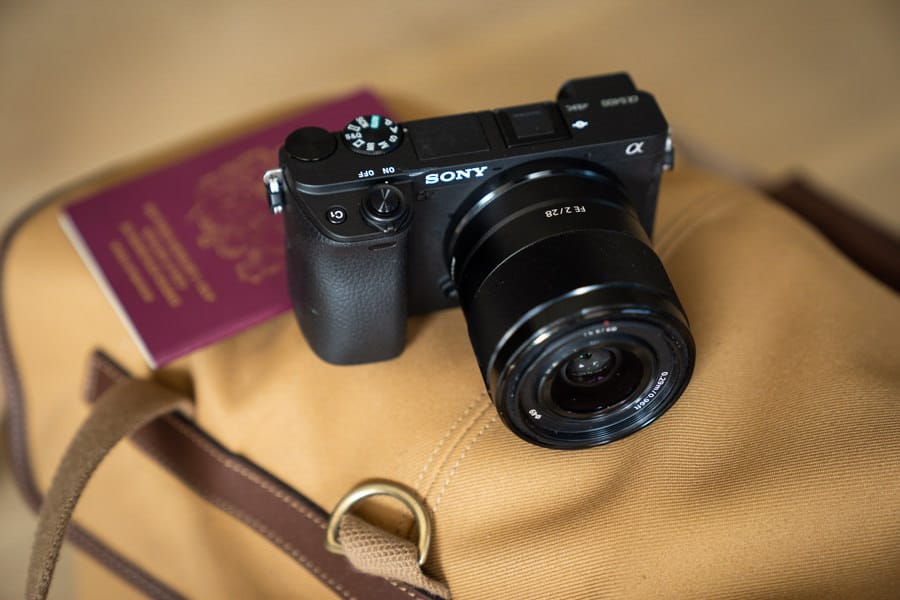
Sony a6400 + Sony 28mm f/2 FE is also a great combination.
With this versatile setup, the blazing auto focus performance, and first-class image quality, the Sony a6400 is in my mind the best compact travel camera for professional photographers who need something smaller than their main body.
Not only can it comfortably be used for professional work, but it’s also beginner-friendly enough to hand to another tourist for a quick self-shot… although with the flip-forward screen, you can do it yourself.
Price-wise, at around $1,000, this is a definitely a premium crop sensor camera but could be priced much more based on the impressive features included, especially since it also shoots video in 4k.
Check out these Sony a6400 bundles for some great freebies when purchasing, like camera bags, travel tripods , spare batteries and cards.
As is typical with Sonys, there are tons of features somewhat hidden in the confusing menu, but when you have the a6400 set up as you want, you can use the physical camera buttons and dials 99% of the time. I also really like being able to focus and shoot just by touching the screen – perfect for remaining inconspicuous while travelling.
Is the a6400 better than the a6500 ? Yes. Is it worth twice the price of the a6000? Definitely.
Ladies and gentlemen, this is one of the best APS-C sensor cameras available right now, and rightly deserves a place in your travel bag.
2. Fujifilm X100V | Highly Recommended
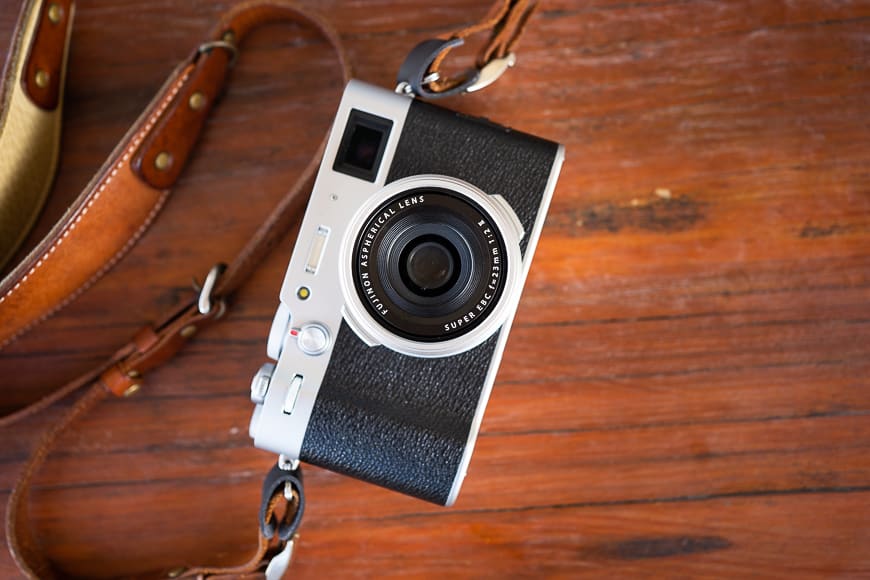
Type: X-Trans CMOS IV and X Processor Pro Megapixels: 26.1 Size: (W) 128.0mm x (H) 74.8mm x (D) 53.3mm / (W) 5.04″ x (H) 2.94″ x ((D) 2.01″ Weight: 478g (16.9oz) More Info: Fuji X100V Review
I’ve used 3 of the past 4 iterations of the Fujfilm X100 series cameras, and now can whole-heartedly recommend the Fujifilm X100V.
Regardless of if you’re a pro or not, this is a great camera to take on holiday with you. (I also recommended it as the best compact camera .)
Running through my criteria, the price is the only area that may put some people off – at around $1,400 (click here to find today’s price) , it’s clearly an investment.
In my mind though, this is actually great value for a camera that can produce such incredible image quality in such a compact body.
The size and weight of the Fujifilm X100V is what I consider to be perfect for a travel camera. It’s easily pocketable if you are wearing a jacket, and is just as comfortable worn around the neck on a strap.
It’s just the right size/weight to be pleasurable to use , whilst still remaining discreet when carried on a camera strap behind your body.
What’s more, you can carry this camera all day long and experience no annoyance or fatigue, although the grip could definitely be a bit ‘grippier’!
I use a Gordy wrist strap just to ensure against accidental drops and find that’s enough – you might prefer a shoulder strap though, so check out some of the best camera straps to see what would be right for you.
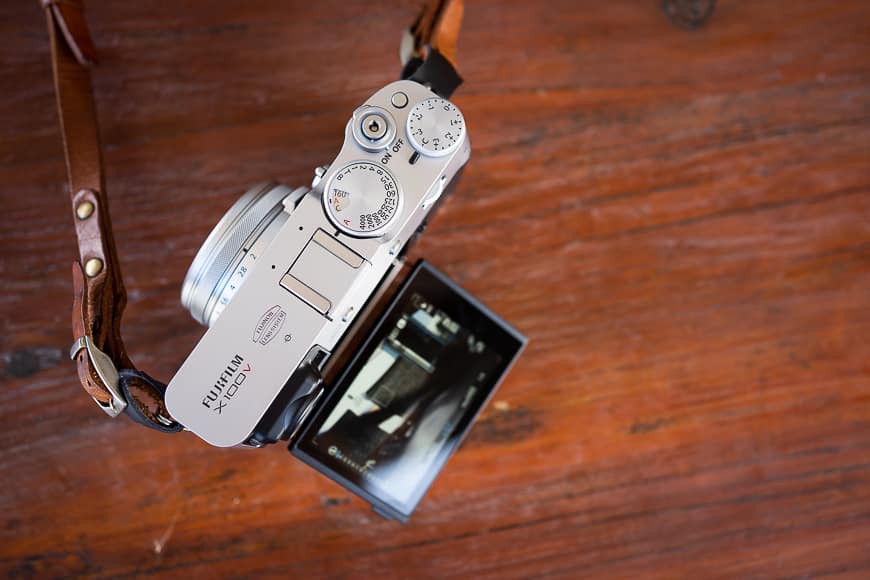
The flip-out touchscreen on the X100V is well implemented and a pleasure to use.
Moving on to image quality, and this is where the Fujifilm X100V really excels.
The whole range of Fujifilm X series mirrorless cameras are very popular at the moment for their stellar image quality in smaller bodies, and I recommend another Fuji in this list.
Fujifilm lenses are top-notch, but you won’t need any of them with the fixed-lens X100V…
I find that the brand new 23mm f/2 version 2 fixed lens on the Fujifilm X100FV is actually sharper than any of the other interchangeable X-series lens options in 2024.
I also love being restricted to only one focal length (35mm equivalent), especially when travelling.
The fixed focal length of the Fuji X100V is a draw-card over other similarly priced mirrorless travel cameras – its simplicity is what defines it, and will help you improve as a photographer, while making your travel bag much lighter to boot.
When taking a camera on holiday, it’s tempting to bring lots of lenses with you. “What if I need to photograph a whale from a boat… I’ll need a zoom lens! And what if I need to shoot a mountain range… I’ll need my best wide-angle lens !” …etc.
Don’t do it! Taking photos on holiday is meant to be fun, and with the weight and worry of multiple lenses , it definitely won’t be… especially if children are involved!
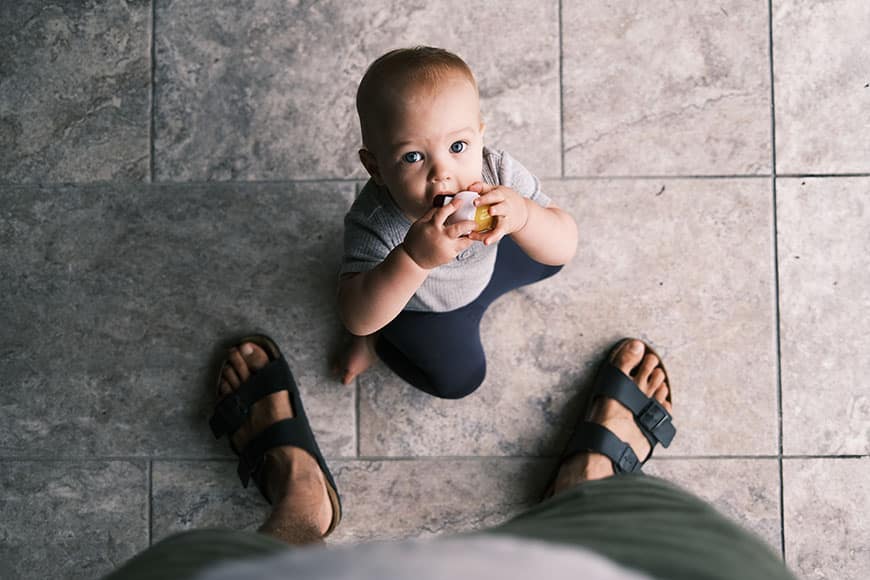
1/340 f/2 ISO100 | Straight out of camera, Pro Neg Film Simulation

150% crop – very impressive sharpness and detail from the new 23mm f/2 lens.
The Fujifilm X100V features a new fixed focal length 35mm equivalent lens with an f/2 aperture. This is flexible enough to shoot anything from portraits to landscapes, and the f/2 means you’ll be able to blur the background and/or shoot in low light without a flash.
Then there’s the new tilting LCD touch screen which allows you to get more candid travel photos , with a tap-to-shoot function that makes capturing incognito images a cinch.
Touchscreen implementation is excellent, with all the pinch-to-zoom/double-tap gestures you’re already used to from your smartphone.
Wifi transfers are fun with the free Fujifilm Cam Remote app, and allow you to wirelessly backup and/or share images taken on your holidays.
Other notable features that contribute to great image quality and flexibility are an inbuilt ND filter (allowing you to create a beautifully blurred background behind your subject even in bright sunlight); fast and precise autofocus (meaning no more blurry/missed shots); brilliant ISO (shoot at night with no flash); and something magical called the X-Trans sensor which means that a camera such as the Fujifilm X100V with a smaller ‘APS-C’ sized sensor can keep up with the big (full-frame sensor) boys!
I also love the 17 film-simulation modes, which apply Instagram-like effects to your images which accurately imitate popular Fuji film stock from days gone by.

You’d be forgiven for thinking this was taken by a 35mm film camera, but it’s actually the ‘Pro Neg’ film simulation of the X100V.
I love the ability to shoot confidently in JPEG, knowing that I won’t be spending hours editing RAWs in front of my computer.
Shooting in RAW + JPEG allows you the choice of increased dynamic range in post-production with the RAW file, but honestly, this is a camera that begs to be shot JPEG-only.
Wirelessly uploading straight-out-of-camera JPEGs to your devices, then to social media is a huge workflow time-saver, and the gorgeous film-simulation modes make editing a thing of the past.
Another great feature of the Fujifilm X100V is the fast autofocus system, which offers effective face and eye detection.
This is especially hand when shooting fidgety children – it’s spookily accurate!
I leave the camera on single-point focus and allow it to recognise faces in the frame, so I can capture any moment quickly and easily.
‘Design’ or ‘aesthetics’ isn’t one of my criteria for finding the best travel camera as it’s entirely subjective.
However, I should add that the Fujifilm X100V is the best looking camera I’ve ever seen. For me, it’s even more beautiful than a Leica, and there are a ton of great Fuji accessories with which to make it look even prettier!
- Related: What are the best lenses for travel photography?
The Fujifilm X100 series of cameras have always come in either silver/black or all black. Both have a unique film camera styling to them and the all-black model is especially discreet. It attracts no unwanted eyes since it’s easy to miss, but to the trained eye, it always attracts compliments :-)
Ah, one more thing I love about this camera – you can charge it via your laptop’s USB port or a battery pack, meaning one less battery charger to carry.
If you’re ready to invest in a camera for travel that has image quality so good that it can even be used professionally, I highly recommend the Fujifilm X100V. The best travel camera for professional photographers and beginners alike.
3. Olympus OM-D E-M10 M ark III
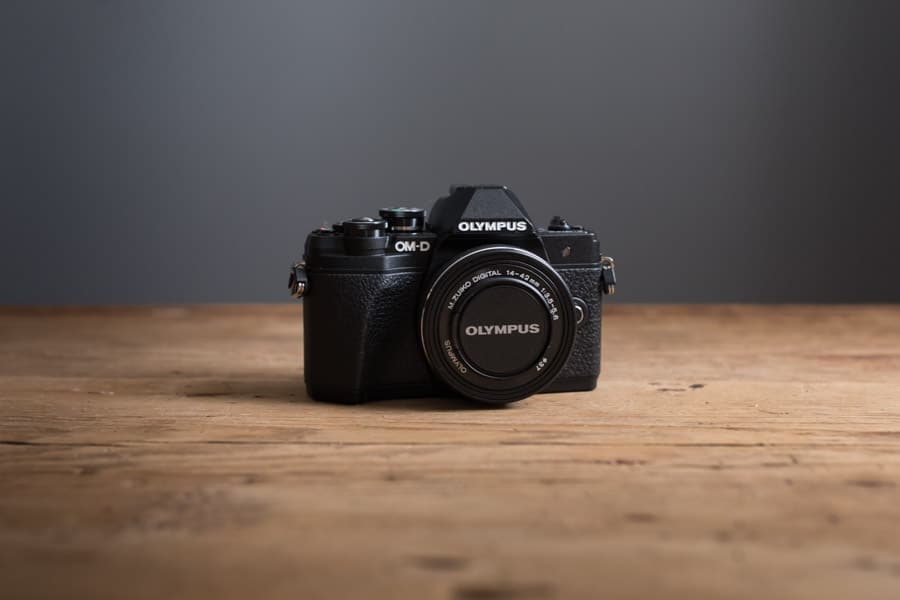
Type: Mirrorless micro four-thirds sensor camera Megapixels: 16 Size: 122 x 84 x 50 mm (4.8 x 3.31 x 1.97″) Weight: 410 g (14.46 oz) More Info: Olympus OM-D E-M10 Mark III Review
The Olympus OM-D E-M10 Mark III is a smaller, lighter, newer and more affordable version of a camera I named the OMD-EM5 Mark II. It was the camera I used for travel before I bought the Fuji mentioned above.
One thing to mention right off the bat is that the Olympus OM-D E-M10 Mark III is an inter-changeable lens camera.
The price of around $650 is actually great value, but it’s for the body only, so you’ll also need to invest in a lens.
There’s a camera + lens bundle option available here which is perfect for most people, but if you want to really make the most of the Olympus’ stellar image quality, I’d recommend you invest an M.Zuiko 17mm f/1.8 lens – it’s a 35mm equivalent lens suitable for everything from portraits to landscapes, can be shot in low light, and produces great blurred backgrounds for subject separation.
(Check out the best micro four-thirds lenses for more options that work well on this camera.)

Using the Olympus O-MD E-M10 Mark III in combination with M.Zuiko 17mm f/1.8 allows you to blur foreground and background elements easily. Black and white in-camera JPEG conversion applied.
I’d recommend you steer clear of bulky zoom lenses, since this defeats the object of having a small camera for travel.
The size and weight of the Olympus OM-D E-M10 Mark III is perfect even for larger hands, and can be carried effortlessly around the neck.
So with price and size/weight accounted for in my aforementioned list of criteria, let’s move on to that all important image quality.
The Olympus OM-D E-M10 Mark III uses a 16 mega pixel micro four thirds sensor which produces amazing image quality for such a small sensor.
When shot in JPEG format, images are sharp, vibrant and contrasty, although this will depend on your in-camera settings and lens choice of course.
There’s also the option of RAW for those who enjoy more flexibility in editing photos after shooting.
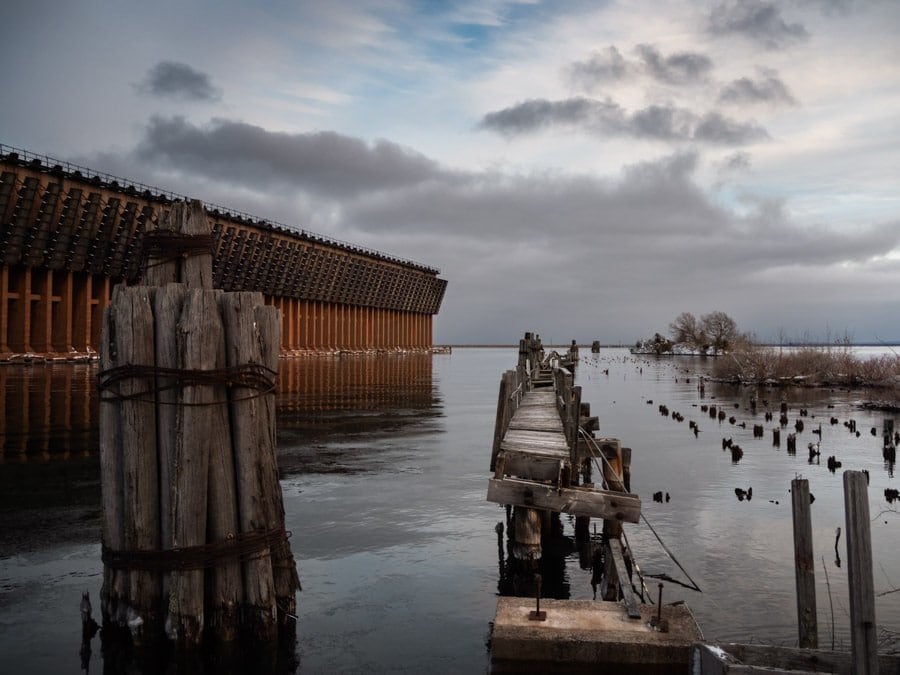
Olympus E-M10 Mark III | 1/200 at f/3.5 ISO 200 | © Meg Loeks
Another stand out feature of the Olympus OM-D E-M10 Mark III is the auto-focus. In practice, I’ve found the 121-point auto-focus to be even faster than my pro-grade dSLR which costs twice the price. It’s also the fastest auto-focus of any of the cameras on this list.
You can actually focus and shoot just by touching the screen on the Olympus OM-D E-M10 Mark III, which swivels to allow for more creative and convenient framing of your shot.
I know I said I wouldn’t dwell on individual camera features outside of my main criteria, but let me just say that the combination of lightning fast auto-focus and swivelling touch-to-shoot LCD screen is the number one reason you should consider buying this camera – it really is that good, and makes photography a lot of fun .
Silent shooting mode is also invaluable when trying to get candid photos of the kids, or when shooting locals whilst travelling – often it’s important to remain as discrete as possible, and this camera allows you to do this, all while shooting from the hip with the flip-out screen.
The Olympus OM-D E-M10 Mark III has plenty of manual control features that I won’t go into here, but even if you leave the camera on an Auto setting and just prod the screen to take photos, it’s entirely worth the cost. I wish every camera had this functionality!
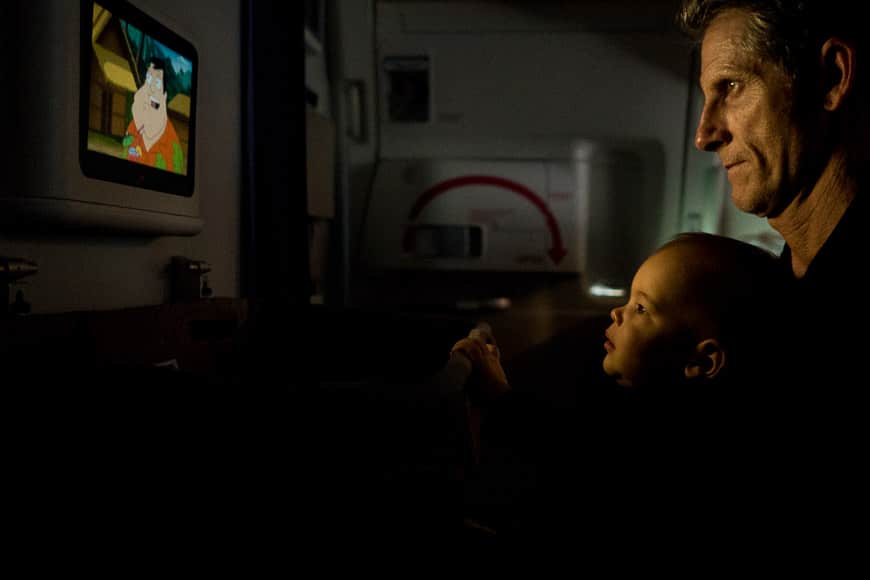
Medium-high ISO on the Olympus O-MD E-M10 Mark III is impressive for a camera of this size. This was shot at ISO1600 in almost pitch darkness on a plane and retains accurate colours and little noise.
Another unique feature of the Olympus OM-D E-M10 Mark III is the 5-Axis image stabilisation. This works great for video recording, giving you smooth, Steadycam-like footage.
For still images, it allows you to hand hold the camera at much slower shutter speeds than normal , meaning cleaner, sharper low light photos thanks to the ability to lower your ISO.
16.1 megapixels is more than enough to print out your images as wall art, but it’s worth remembering that all micro-four-third sensor cameras such as this Olympus will record photos in the 4:3 ratio, probably different to what you’re used to.
You can ‘force’ the camera to shoot at a more standard 3:2 ratio by cropping the image (which is what I did for all the sample photos here).
Overall, the Olympus OM-D E-M10 Mark III is a great-looking, lightweight, compact and robust camera that offers some unique features and excellent performance, making it perfect for travel .
It’s available in discreet all-black or a retro silver-black option that’s equally sexy. I highly recommend it as a camera to document your next trip.
4. Ricoh GR III | Best Pocketable Travel Camera
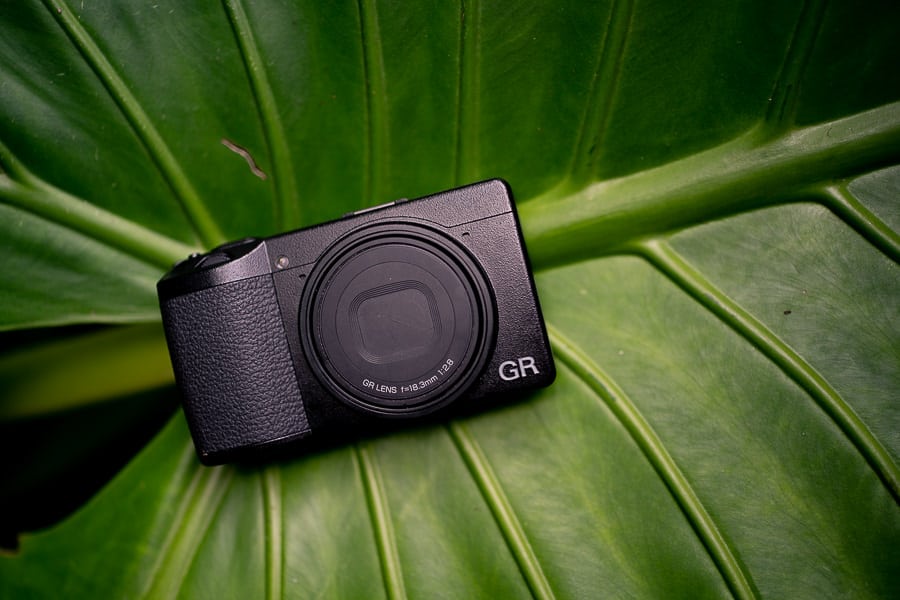
Type: APS-C sensor pocket camera Megapixels: 16.9 Size: 4.6 x 2.5 x 1.4 in. (117 x 63 x 35 mm) Weight: 251 g (0.55 lb)
I tested the previous generation of this camera a few years back, and while I found the image quality impressive for its size, the sluggish autofocus performance annoyed me. Thankfully, with the GRIII, Ricoh has made a much snappier experience with the Ricoh GRIII.
It also offers a new 24MP sensor (a significant resolution boost), a sharper lens with macro capabilities, a hybrid autofocus system, better battery life, image stabilisation and even a nice and responsive touchscreen.
The 3-axis sensor stabilisation is great, and worth the additional money for the III over the II – I was able to take handheld shots with a shutter speed as slow as 1/2 second, allowing me to blur motion without the use of a tripod!
This is a great feature when you’re travelling, and want to take a photo at a crowded tourist attraction – now you can blur out people walking by, to remove them as a distraction and create a more engaging photo.
The touchscreen on the Ricoh GRIII is great – snappy and responsive , with a tap-to-focus-and-shoot function, which all cameras should have. It allows for the inconspicuous photos – perfect for incognito travel photography.
Image quality is excellent , and I particularly like the colours from the JPEGs. I like shooting in Vivid Mode, with the contrast increased for some additional punch, like in the photo of our son Harry throwing a paper aeroplane below.

I love the JPEG colours straight out of the Ricoh GRIII on Vivid setting | 1/400 f/2.8 ISO200
RAW quality is also impressive, with a decent amount of dynamic range from the APS-C sensor. If you’re coming from the previous version, there are 8 additional mega pixels, which helps to make images sharper and give you the ability to crop.
The 18.3mm (28mm equivalent) lens’ width is unchanged from the GRII, which is good news – 28mm is fun and easy to shoot , with minimal distortion, and provides a unique perspective which can immerse the viewer into the shot, without feeling too wide.
As for the design and ergonomics, this is what I love the most about the Ricoh GRIII – minimal branding, buttons that blend into the body, and a rubberised grip that’s moulded perfectly to your fingers. You’ll slip by virtually unnoticed when using this on holiday, allowing you to capture candid moments of locals or your family. Definitely not your typical “tourist camera”.
The Ricoh GRIII is one of the smallest cameras I’ve used, but it still retains excellent ergonomics , which isn’t an easy task. I love the fact that I can slip it into my shirt pocket, and I hardly know it’s there – it really is light as a feather.
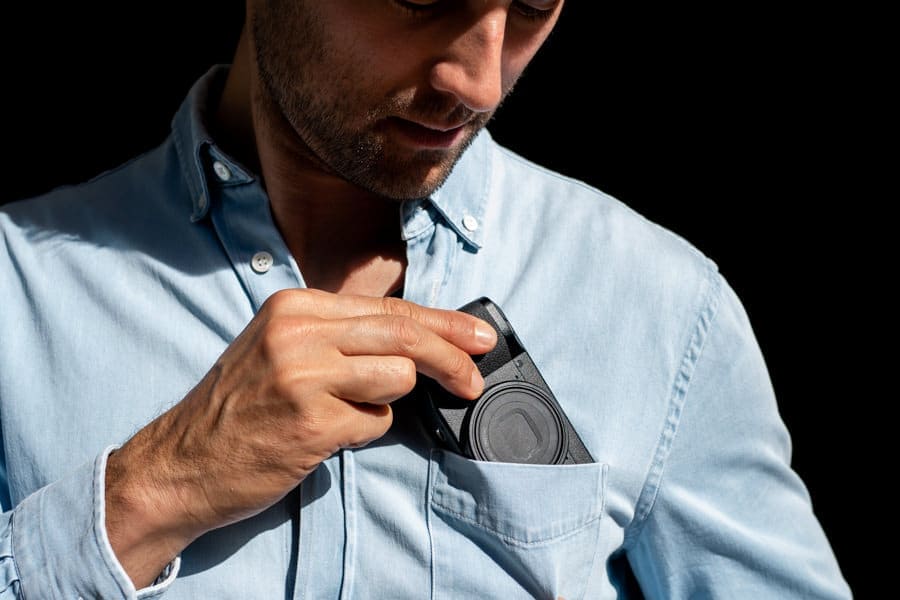
The Ricoh GRIII is truly pocketable, and so light you’ll barely notice it there.
The grip on the front of the Ricoh GRIII is sticky and moulded enough to allow you to use the camera one-handed all day long, in landscape or portrait orientation.
The battery life could be better (I got around 280 shots per charge), and I do wish the touchscreen rotated, but other than that, there’s not much to complain about the design itself.
Focusing in really low light was sometimes troublesome, with the AF point hunting back and forth to find the subject. On the flip side, in bright sunlight, the glossy LCD screen (and lack of viewfinder) made it a little hard to see too.
However, these are all minor niggles on a really enjoyable camera that takes fantastic photos, with minimal editing required, all for an impressively affordable price.
Don’t let the Ricoh GRIII be the camera you’ve never heard of! It’s a truly unique product, and one that deserves a lot more of the limelight than it receives.
5. Sony a6000 | Best Budget Travel Camera
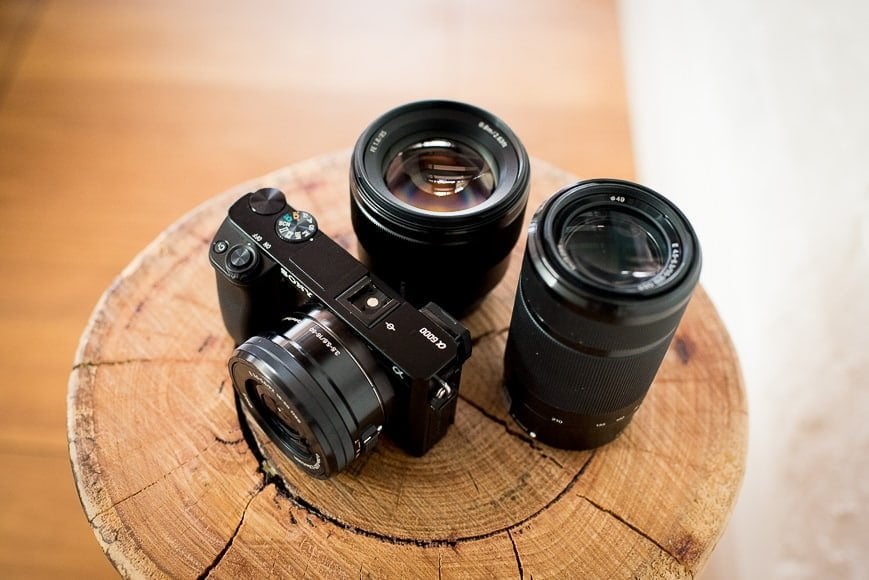
Type: Mirrorless APS-C sensor camera Megapixels: 16 Size: 4.72 x 2.64 x 1.77″ (120 x 67 x 45 mm) Weight: 0.76 lb (344 g) More Info: Sony a6000 Review
If your budget can’t quite stretch to the other offerings in this guide, don’t despair – the Sony a6000 is still the best budget travel camera money can buy.
I say ‘still’ since this is a camera that’s over 5 years old… but don’t let that put you off. It’s also the best selling mirrorless camera in the world.
For the incredible price of around $400 (latest price here ) for the body only, you can get one of the many lens bundles for a little bit more and have yourself an amazing set up, ready to take on your next travels.
You can check out my full review and selection of the best lenses for the Sony a6000 , but the long and short of it is this:
The Sony a6000 remains the best bang for the buck camera for travel in 2024. No other camera offers such high image quality and lightning fast auto-focus in such a compact body, for such a bargain price.
At only 0.76 lb (344 g) and as pocketable as a smart phone, the balance and portability set it apart from bulkier inter-changeable lens offerings, but you need to be careful when pairing it with the range of Sony e mount lenses .
My choice of lens to go with the Sony Alpha a6000 for taking on holiday would always be the Sony 20mm f/2.8 – a ‘pancake’ lens with proportions that makes the camera an absolute joy to use .
It’s a 30mm equivalent field of view, meaning its wide enough for most things you’ll encounter whilst travelling, but can still be used for portraits.
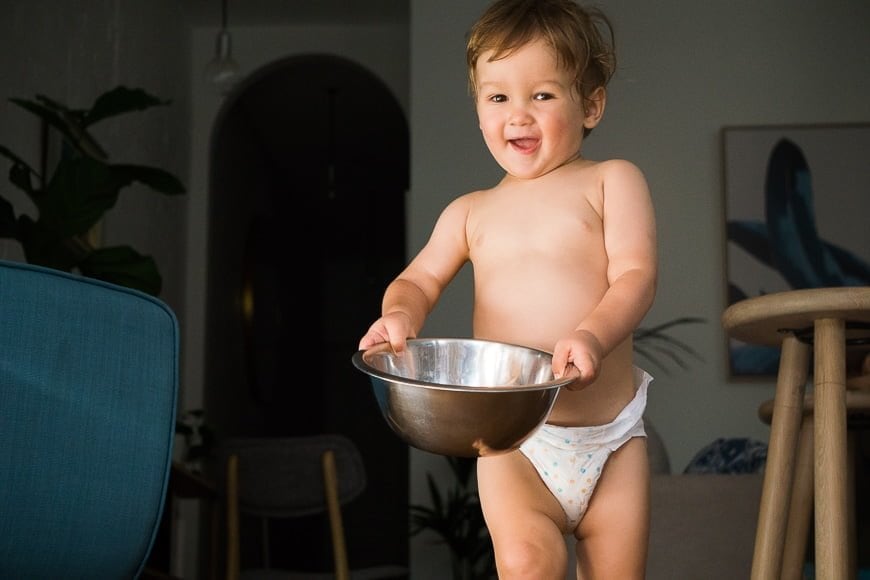
Sony a6000 + Sony 55-210mm f/4.5-6.3 | 1/320 at f/5.6 ISO 3200 | Image quality is crisp and clear even at ISO 3200
Whatever lens you choose for the Sony Alpha a6000, the image quality is excellent , especially when you consider the camera’s sensor is ‘only’ APS-C size.
Colours are vibrant and details are sharp in JPEG format, and the RAW files provide adequate dynamic range to push/pull your images, squeezing every last drop of editable data from them.
Things really start to impress when shooting at higher ISOs, with photos being relatively clean even up to ISO 25,000.
In practice, this means you can take photos at night just by using the ambient light around you. On holiday, this is great since it means you won’t draw unwanted attention to yourself whilst shooting without a flash.
At its launch, the auto-focus on the Sony Alpha a6000 with its 179 phase-detect focus points spanning almost the entire area of the viewfinder, would have been considered class-leading. Here in 2024, the several successors to this camera boast many more focus points, but this is not really an issue- 179 focus points is more than enough for most situations.
Either way, the AF on the a6000 is able to effectively track fast subjects at up to 11 frames-per-second – truly remarkable for a camera at this price and much faster than most DSLRs .

Sony a6000 + Sony 85mm f/1.8 FE | 1/250 at f/1.8 ISO100
Having such fast auto-focus and frame rate on a camera makes it great for travel to capture images of locals whilst whizzing past on a bus, or simply to get a shot in focus of your child jumping into the pool.
Another neat feature is the WiFi and NFC connectivity , which allows you to share your travel photos to social media, transferring them from your camera straight to your smartphone or tablet.
This is ideal whilst travelling, meaning you don’t need to bring your bulky laptop.
One slight drawback with the a6000 (and indeed, any Sony mirrorless camera ), is the confusing menu. However, once you’ve set the functions up to your liking, you can reach all the main functions by using the camera’s physical buttons, which are all in easy reach.
With the right lens for you attached to it, the Sony Alpha a6000 is a great budget camera for travel and definitely deserves its place on this list.
If you only have around $500 to spend, you’ll be getting a camera that can run rings around your smartphone’s camera, while still being able to fit inside a jacket pocket.
6. Canon G9 X Mark II

Type: CMOS sensor pocket camera Megapixels: 20.2 Size: 3.9 x 2.3 x 1.2 in (9.8 x 5 x 3 cm) Weight: 206 g (0.45 lbs)
As another affordable camera for travel, the Canon G9 X Mark II is a great little point and shoot camera to consider for your next trip.
For under 500 bucks, you’re getting impressive image performance from a camera that’s small and light enough to have in your pocket all day long.
At only 0.45 lbs (206 g), the Canon G9 X Mark II is the lightest camera on this list. However, it also has the smallest sensor (CMOS) out of all the other cameras – so why have I included it here? Small sensor = crap image quality, right?!
Well, not quite. The sensor is actually much bigger than that one found in even the most high-end smartphone, and with a better lens and image processor to ensure the Canon G9 X Mark II can do things your phone simply cannot.
Similar to the Ricoh mentioned above, the Canon G9 X Mark II doesn’t have a viewfinder, meaning you’ll have to rely on the touch LCD screen. Fortunately, it’s bright and sharp and 3″ in size to ensure you won’t be squinting.

A combination of fast auto-focus and impressive low light performance enables the Canon G9 X Mark II to capture images like this without using flash .
Some people love touchscreens but some prefer physical buttons. Whilst the Canon G9 X Mark II features a few buttons for the most needed functions, you’ll have to use the touch screen to access everything else, even moving the focus point. Less buttons does mean less chance of buttons sticking though, which can happen after frequent travels with a camera.
The Canon G9 X Mark II features a 28-84mm equivalent lens with an f/2 – 4.9 aperture. Since this zoom lens adds no bulk to the body of the camera and remains lightweight, I have no hesitation in recommending this Canon as a good camera for travel.
28-84mm means wide-angle focal length to medium telephoto. In practice, I was able to shoot any landscape image with ease, then quickly get a close-up shot of passing wildlife. Shooting at 84mm when your subject is relatively close will also put the background nicely out of focus too (‘bokeh’).
f/2 means that the Canon G9 X Mark II does well in low light and can blur the background and/or foreground nicely, depending on how close you are to the subject.
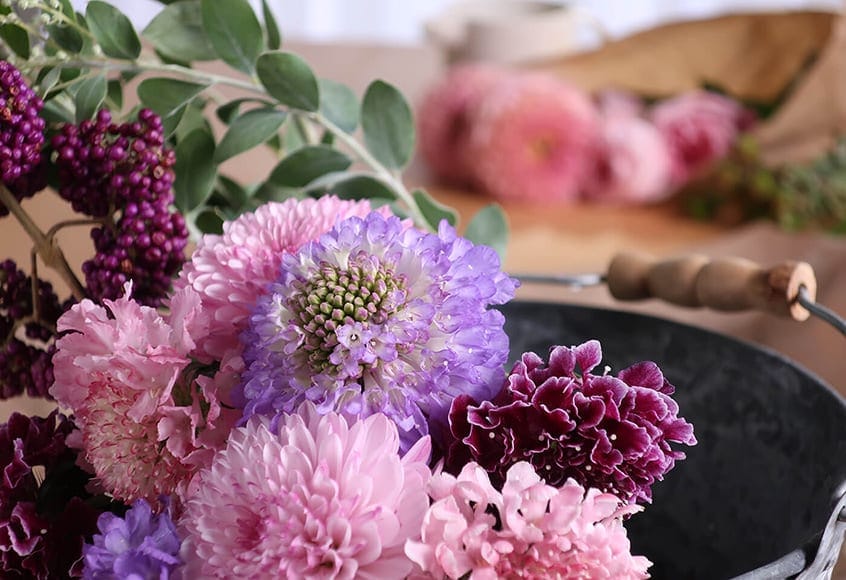
When shot at f/2, the Canon G9 X Mark II is able to produce pleasing bokeh (blurred foreground and background elements) similar to a camera with a much bigger sensor.
As for image quality, the DIGIC 7 image processor used by the Canon G9 X Mark II ensures that JPEGs are very impressive for a camera this small. RAW images are decent too, offering some flexibility during post-processing.
Personally, post-processing is the last thing I want to do after a holiday with the family, but it’s nice to know there’s RAW functionality there if needed.
The Canon G9 X Mark II also offers Auto ISO, a nice addition to a compact camera at this price point. The ISO range is 125-12800, but I’d only feel comfortable using a maximum of ISO1600 to ensure the clearest photo possible.
In practice this means that with Auto ISO applied, you can comfortably let the camera decide when to raise and lower ISO from morning to dusk. After that, you’ll need to rely on the camera’s flash.
Speaking of the flash, it’s a little on the slow side to recharge. Also, on battery life, the Canon G9 X Mark II can only manage around 240 shots per charge. I find I rarely shoot more than 200 photos per day whilst travelling, but if you’ve got a heavy shutter finger, you might want to pick up a couple of spare batteries.
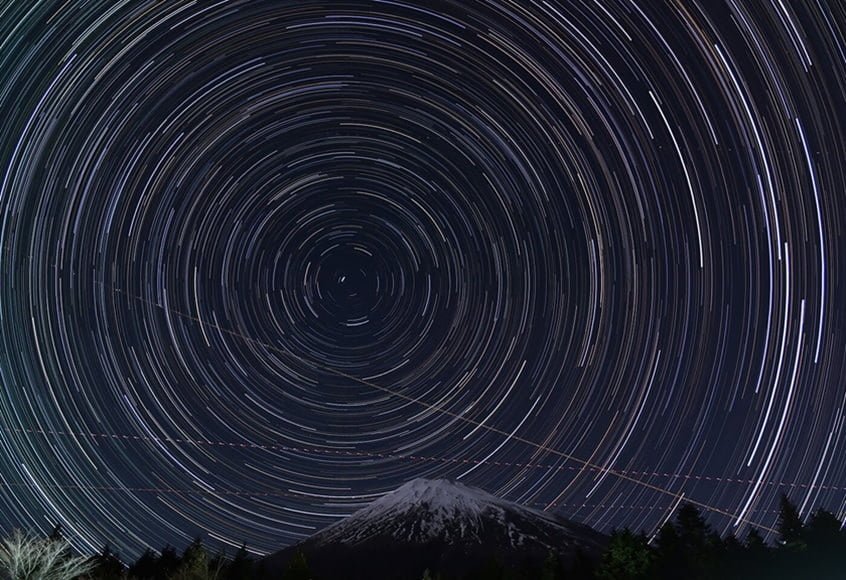
When shooting long exposures with the Canon G9 X mark II, especially in cold climates, battery life will be even shorter.
Compact cameras at this price point usually struggle with auto-focus, especially those with zoom lenses. Thankfully, the Canon G9 X Mark II is surprisingly fast to acquire focus on both static and moving subjects.
As I mentioned at the start of the review, auto-focus speed was a primary concern for me when compiling this list. Many cameras have excellent image quality but have slow auto-focus, so I left them out of this review.
The Canon G series has been a long-time favourite of amateur photographers, and the Canon G9 X Mark II is a solid travel camera at an affordable price.
In image quality stakes, it definitely can’t keep up with the others on this list, but it’s still more than adequate for the average family holiday. The zoom lens also offers great flexibility for those who are too lazy to move their feet…!
Travel Camera Buyer’s Guide
Haven’t got time to read through all my recommendations? Here’s the long and short of it:
📸 Only got $500 to spend? Get this renewed Sony a6000 with 16-50mm Power Zoom .
📸 Want the latest technology under $1,000? Get this Sony a6400 with 16-50mm Power Zoom .
📸 Don’t want the fuss of changing lenses? Get the Fujfilm X100V .
📸 Want a camera with the most affordable lenses? Get the Olympus OM-D EM10 Mark III .
📸 Just want the best small camera for travel regardless of price? Get the megapixel monster Sony a7RIII .
📸 Want the smallest travel camera you can slip in a shirt pocket? Get the excellent Ricoh GRIII .
I’ve shot with all these cameras and can assure you that whichever one you pick, it’ll serve you well on your next trip.
In all honesty, there’s no such thing as the best travel camera, since any modern camera could be considered the ‘best’, depending on your wants and needs.
You’ll just have to decide what criteria are most important to you when going shopping, so let’s take a closer look at that now.
How to Choose a Travel Camera
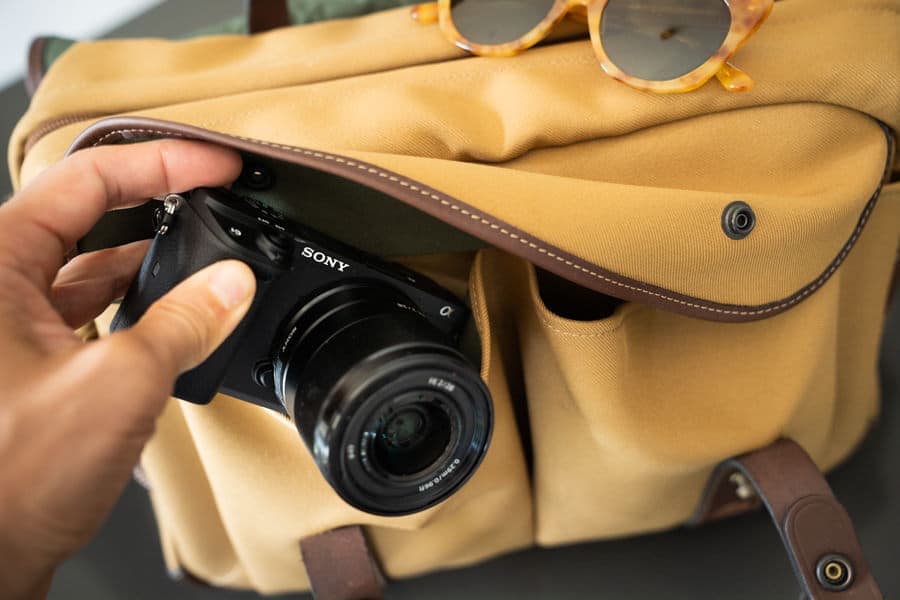
If your camera needs its own bag, it’s probably not right for travel!
In this article, I make recommendations on what I believe to be the top travel camera of the year (so far), between $500~1,500.
Too many guides tell you that the best travel camera is some $2,000+ full frame model combined with a $1,000+ lens… this just isn’t realistic for the average traveler.
I wanted to create a guide that’s for the average person going on holiday, wanting a camera to capture some great-looking photos, but not wanting to spend more than their whole holiday on it!
I recommend that you check the 5 main criteria I used to evaluate all the different cameras on the market, and see which ones are most important to you.
While I don’t want to advocate spending a fortune on a camera, it has to be said that you do get what you pay for when it comes to technology.
Yes, you can spend under $500 on a camera and produce some beautiful images, but investing a little more is advisable – not necessarily on the camera itself, but on the camera and some lenses.
However, to feel comfortable travelling with a camera, it can’t be too expensive either. I concentrated on cameras under $1,500 for this post, with a range of prices to suit all wallets.
2. Size/Weight
Great image quality used to come at a compromise to size/weight, but thanks to the advancements in sensor quality, this is no longer the case.
That said, there still comes a point where you may need to attach a bit of bulk to your compact travel camera, aka a lens.
While there are some excellent ‘fixed lens’ point and shoot cameras available that I recommend, being able to swap lenses can open up some creative opportunities , not to mention be more versatile while traveling.
The best camera to travel with is usually one that can be slipped into a pocket (compact cameras), or worn on a shoulder – definitely not something that requires a bulky DSLR camera backpack .
3. Image Quality
There are cameras under $200 that are lightweight and small, but they also only have average image quality – usually similar to your smartphone.
The travel cameras I’ve recommended here all have great image quality , for those once in a lifetime sights you see on holiday, or to capture your child’s face at Disneyland for the first time! This is one criterion that you really can’t ignore.
4. Auto Focus
It’s really important for a travel camera to have fast and accurate auto-focus . This allows you to get your shot and move on, leaving you to enjoy your holiday rather than worrying about whether your last photo was in focus.
The auto focus on smartphones is getting better, but it’ll still be years before they come close to the cameras featured here.
5. Flexibility
Waterproof cameras that function 50m underwater; zoom cameras that can see to the moon; shock-proof cameras that can survive an elephant stampede… and any other specific usage so-called cameras always sacrifice one of the above criteria, usually image quality. These are not good travel cameras.
For this post, I’m only interested in the cameras that are flexible enough to be used effectively in multiple situations that you may find yourself on holiday.
Frequently Asked Questions
What is the best travel camera in 2024?
There are a few good options, but we believe the Sony a6400 offers the best bang for your buck this year. Coupled with a lightweight prime or zoom lens, you can capture amazing images or 4k video on your next trip.
Is it worth buying a camera for travel?
Yes, definitely! Despite smartphones getting better and better each year, a dedicated camera is still the best option, especially when it comes to preserving your travel memories.
What should I look for in a travel camera?
Size, weight, battery life, ruggedness, auto-focus speed, image quality and price are all important criteria when shopping for a travel camera.
Travelling with a Camera | Final Words
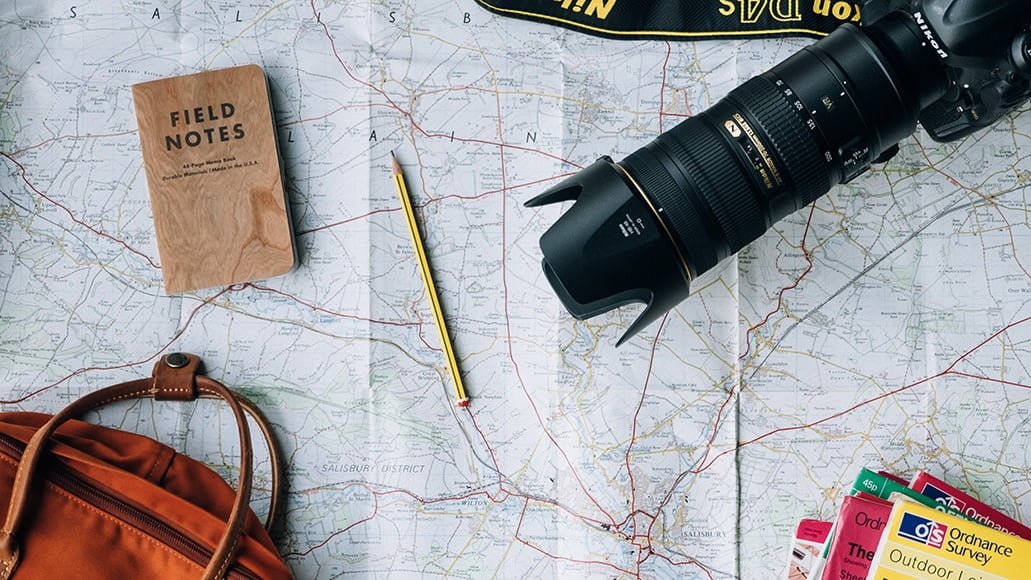
Don’t ever let me catch you on holiday with one of these hanging around your neck…!
I hope you enjoyed my roundup of what I believe to be the best cameras for travel in 2024. When you’ve just spent hundreds of dollars on a holiday, I know it’s tempting to skimp a little on camera purchases. After all, you’ve got your iPhone, right?!
However, I’m a strong believer in getting the best quality image every time you take a photo , as well as having a camera that’s enjoyable and convenient to use.
For photos of your loved ones on holiday right down to photos of the mountain you just skied down, capture those memories in all their glory by investing in a great camera for travel.
I have access to some of the best dSLR camera equipment available, but I’d never dream of using those big, bulky cameras for travel. I’ll also leave my expensive full frame mirrorless camera at home too – there’s no point risking something that value when on holiday.
Safe travels and happy snapping!

Mark Condon is a British wedding photographer and editor of Shotkit. When he’s not taking photos or reviewing the latest camera gear and software, Mark can be found cycling around the northern rivers.
65 Comments
awesome list, you put it together very well 🙂 i got a Sony A6400 from amazon and it’s absolutely amazing, it really show in my vlogs.
Great info. I’m considering to switch to Sony for my travel camera and get a mount adapter. Thanks!
I can’t argue with your rankings but, as a Canon user with several lenses, I opted for a Canon EOS M50 with the EF-M adapter. I got it at a great price ($516.69 w/ 15-45mm lens – gray market) and have been very happy with it. The focusing is faster than I expected and it has some great features, including the built-in EVF. I’ve used it with my 24-70 f/2.8L II, my 70-200 f/2.8L IS II (it does look funny with that big a lens on it) and I bought an 18-135 f/3.5-5.6 IS USM (Nano) to use on it everyday. With the kit lens, it’s very small. I’m sure the Sony cameras are superior but, for Canon users that are deep into the system, this is a great option. I really enjoy using the M50!
We have a full review of the M50 coming out this month, Michael. I agree – it’s a great little camera.
wielkie dzięki za artykuł <3
Nie ma za co
Thanks for the great article… It made up my mind to continue with the Sony brand same sensor same mega pixels . Being familiar with the menus made setup so fast. Having carried my Sony a77 around the cities of Europe for a couple of years, the Sony a6000 feels like a lens with a sensor (and it fits neatly in hand luggage taking up little space!)
haha ‘lens with a sensor’ made me laugh! I bet your back is thanking you, Graham…
I’ve several systems. The most disappointing one is the Sony NEX system, inc a6000. Why? The telezoom isn’t great, the battery life is shocking and the autofocus, while deadly accurate on static targets doesn’t actually work very reliably. Also, though very light, the form of the camera plus lens is a bit awkward. Don’t get me started on the menu system. The best travel camera I’ve used is the Panasonic FZ1000 . It’s fast with great autofocus and good battery life and you don’t have to change lenses.
Thanks for the feedback, Garry. Shame you can’t get on with the NEX system. The FZ1000 is a great camera, albeit a tad bulky for me.
Mark, Thanks for a very helpful guide. Do you have additional lens recommendations for the Sony a6400?
No problem, Jim. Check back to the site in a couple of days and they’ll be a review just for that exact topic ;-)
Nice expansive list of interesting travel cams. I’ve used the Canon G series in the past, and liked them. However you can’t escape the latest smartphones. The technology and image quality now is amazing! Though I love my Nikon D850 and the roster of lenses I travel with, my backup travel cam is now an iPhone 7 Plus. With twin lenses and different shooting modes, plus the ability to shoot 4k video, the quality is just outstanding! Of course it’s not great for night (astro) photography which my D850 excels at, but for daylight photography, colour, sharpness and quality, it rivals the compact cameras listed above.
Additionally, the Camera2 + app which can shoot in RAW, and Filmic Pro app for superb hi-def videos, gives smartphones a diversity matching or surpassing some of the cams listed above. Best of all, is the additional features, like being able to operate my DJI Mavic2 Pro drone, and toting along apps like Stellarium to track stars and Waze to navigate through traffic!
Perhaps you need to do an evaluation of the top of the line smartphones vs cameras with fixed lenses in the same price range. If you do that analysis like I did, you may find that smartphones are getting hard to beat.
Hey Frederic, I agree that smartphones are getting and better and better for photography, but there’s simply no comparison to something like a D850 like you own + pro glass. For a consumer in daylight without specific needs, perhaps a phone is most convenient, but for a pro, a smartphone can’t be compared to a dedicated camera + lens.
Curious why you never cover anything from Panasonic. The GX1 and GX80 have been perfect for me when needing a small portable camera for travel or street photography.
They’re good cameras, Gus – nothing wrong with them really. Just the options presented here are better IMO.
Agree with the X100 and Ricoh GR recommendations. If anyone is already invested in the Fujifilm Len ecosystem then the X-T30 would be well worth a look. Might just be the best specced ICL CMOS camera for the price?
I agree, Simon. X-T30 is fantastic, and I’ll probably be adding it to this list soon.
I bought a GRII Best camera I’ve ever had. Better than all my old Leica’s, my Nikon’s, my canons and my new quiver of Sony’s. Why? Because it’s always with me. I never miss a picture. Portraits, street, landscapes. It can do them all.
That’s the way, Matt! Best camera = one that’s always with you.
Good selection, but Im kind of surprised you didn’t include the Fuji X-T2. It’s way cheaper now that the newer model came out. AF and image quality are pretty good and the body is weather sealed. You can pair it with the amazingly small f2 weather resistant primes and have a perfect travel kit. I would say Fuji has a far better lens selection than Sony and a lot of people prefer the experience of using a Fuji. If you are mainly a photographer, you don’t need the new features of the X-T3. You can get a mint condition X-T2 for $800 right now.
Yeah that’s great value for money, I agree Guille. I’m considered swapping the X100F for the XT-30 in my recommendations, but decided against it in the end. I agree that the Fujinon lenses are excellent, but for travel and simplicity, a fixed lens is also a huge plus. Perhaps I’ll add in the XT-30 for those of us who like the option of multiple lenses… but I do like your budget X-T2 idea too. The 23mm f/2 WR is one of my favourite lenses. Thanks for the comment.
I would put on that list the Canon m6 or the Canon m100 which has the new 24mp sensor Canon at apsc size and modestly priced, better image quality than the Canon G9x which is the 1 inch sensor. The m series lenses are much more compact than regular apsc lenses from Canon. Priced at around $400 for m100 and currently around $600 for m6 with a sharp and decent zoom kit lens, these are great cameras with dual pixel fast autofocus and very good dynamic range (similar sensor to the 80D in a compact body).
Thanks for the feedback, Adrian. The EOS M series has been surprisingly popular for Canon users, with new models due to be released this year too. Watch this space!
Hey there, You mention the G9xmkII has a sensor just a little bigger then a phone. It’s actually a 1 inch sensor, the same size as the RX100’s. That’s what makes it and the G7 so compelling.
I have had my eye on the Fujifilm X100. I’ve read many reviews, and most (as did your) boast of the outstanding image quality, build, etc.., but the one question I always found unanswered was if I would miss a zoom lens if I got a fixed focal length such as the Fujifilm as my travel camera. Your review addressed this quite clearly which I appreciate. Now if I can only justify the cost.
Hello Mark. Thank you for the review, it is very useful. Are you recommending Olympus OM-D E-M5 or E-M10? The links refer to different photo camera to what is written
Ah thanks Inga, I need to update that. I actually recommend both the mark II versions of those cameras, but especially the EM-10 as it’s more affordable with very similar features.
Fujifilm X100F all the way for me. It’s a killer camera and occasionaly I use it to shoot weddings.
What an informative write up on cameras! It looks as if there is something for everyone in the market irrespective of what they need. Travel is not any good if you do not capture the memories on film.
Wow. This is really in depth. Thanks for the info!
Sure thing Christy! I checked out your guide on travel cameras too – nice work ;-)
Nice picks! Personally I have been shooting almost entirely on my X100T since I got it 3 years ago. Really forced myself to work around the prime lens and now I end up pretty much knowing where and when I can take a shot. If I see something too far away I just enjoy the moment – some of the best times you get when you travel.
I enjoy traveling alone as I’m basically on a photo walk each time, and my T is my travel buddy sharing those memories with me. Which might sound a bit sad haha although I do enjoy traveling with family and my significant other as well. Those times I’m with them I feel the X100 to be a little to slow – I like walking at a deliberate pace and taking time to compose shots unless I’m doing street snaps.
So for those times with family I’m thinking about getting a complementary camera to the X100. Really happy with a prime so I’m considering the GR II and the X70. Logic tells me they overlap with my current so I’m also looking at the Sony RX 100 m3 or Canon G7X ii. But then I had sold my DSLRs years ago so maybe I should just get an OMD or an XT2/XE3. But then over my travels this year it had rained so many times I’ve wished I had a waterproof camera on me. This is driving me nuts I’ll probably just end up buying a new weather resistant smartphone and use that for family shots!
So almost 3 weeks and I’m still spending way too much time thinking about this. I think I’ve got my options down to two. Getting a Canon G7x ii as a fast, more of snapshot camera I can bring together with the X100T or getting the Fuji X-T20 with 18-55 which will essentially replace the X100T because of versatility when I’m out with family and I’ll just have the T when I do street or when I’m traveling alone. Any thoughts?
Not sure how the Sony RX100 Series didn’t make it onto this list. I’ve taken some truly incredible pictures with my Mark III. It also fits well in the budget range.
I couldn’t get hold of a Sony RX100 IV to review when I wrote this Kyle, but I agree, it should be a strong contender.
Great article, but I ofte wonder what really is travel photography. Personally I often travel to take pictures and since taking pictures is the main reason for visiting a certain place I often need more flexible solutions.
I have the X100F and GR II. Great cameras for street photography and casual “snapshots”, but too limiting for wildlife, landscapes and architecture. I usually thorn between taking my X-T2 or D750 with various lenses. At least I am right now… On a vacation trip I will be more than happy with only bring the X100F or GR II, though.
Two great cameras for sure!
Curious to know if you ever travel with both. I love my X100T but I’ve always been intrigued with the GR.
Great article! I am obsessed with the Fujifilm X100F and will hopefully purchase that soon for my travels. I too use a D750 for the heavy lifting. It’s a low light beast.
Weatherproofing isn’t about shooting in the rain, it’s about shooting when there’s surf splashing around, or in dusty deserts, or on beaches with swirling sand and so forth. Or even underwater (I’m no Jacques Cousteau but I always take a waterproof compact on holiday). And what about when it’s snowing? It can be absolutely beautiful.
Pity to miss so many photo opportunities because you’re worried about damaging your equipment.
Plus there are certain activities where rainwater gets in EVERYWHERE, no matter how well packed you think you are. I once had a camera wrecked by rain on a motorcycling holiday while it was packed in my luggage. And my Mum recently wrecked her compact while hillwalking in the rain – the camera was in a supposedly-waterproof pocket.
Fair points, Brian!
Great article! The main thing about it is that you first describe how to find best travel camera. I think Fujifilm cameras is best for traveling and have a high-resolution smart camera which makes travel more happier. Thanks for sharing with us.
I need to agree with George Mahlum about Sony A7. Actually, I am using it myself, and I can’t recommend it enough. Together with 28mm Sony lens, you can get some serious shots. Plus the size and the weight is perfect for me.
Truth to be told, I like Fuji X100F a lot. Did not use it actually, but I used X100S, and I know that F is serious upgrade. But still for the price, I would go for a Sony variant.
But than again, that small lens on Fuji is a winner, if you can live with only one lens (which in my opinion is awesome for travel ~35mm f3).
Thanks for your comment Boris. Another vote for the A7 it seems!
Surely need a bit of zoom in a travel camera. I’ve enjoy the Fujifilm X30 (or is there a newer model of this?) for travels – zoom, adjustable screen, optical viewfinder, mode selection via top dial, built-in flash, great ISO range, myriad of other features, fits a jacket pocket, unobtrusive for street photography.
Thank you for the insightful and useful post as always! If investing in a second camera – do you think the Fujifilm x100 earlier versions would be worth getting to get a used one at a lower price point for the x100s or x100t? I have the Fujifilm xt-1 and I am about to trade it in for the xt-2 I would love to have another small portable camera. Would you recommend the Fuji x100 (is it worth getting the newest even with the high price point?) or do you think one of the other cameras would be a better to developing my personal kit?
Additionally I have a gopro hero 5 session, an old panasonic point and shoot, and a Nikon D90.
Hey Nicole, I wouldn’t recommend the X100 series cameras except the T or the F. Ideally the F, since the advancements are considerable. I’ve used the original and it’s very slow. I owned the S and it was much better, but still slow. The T is good enough, but the F is definitely the best. I’d get a used T, or save up for the F!
Mark, too much to choose from, I took a Sony HX90V walking in France recently and some city/urban time. The results were excellent, the camera fitted in my shirt top pocket, good zoom. I use the pictures for collage and multi media/illustration/installation
Really nice article I also will suggest Fuji X70 as a travel camera, light weighted, 28 lens, tilt-able touch screen and many more features
Ah yes, a great little camera!
Oh no! Always hesitating between the X100F and the X-T20 for different reasons and now they are both featured in the same article!! Which one would you choose?
I chose the X100F for the reasons I mentioned above ;-) They’re both great cameras, but their uses are slightly different. If you aim for simplicity, follow my suit. If you crave versatility, get the X-T20.
hi mr Mark, i have get more knowledge from your Best Advice……. Thank You So Much
You’re welcome Hemant! Thanks for the comment.
Nice read. Have to disagree on the X100F lens being sharper than the interchangeable options available- I owned one and sent it back as shooting wide open with it, I just didn’t like what I was seeing. At F2 I found the images soft and not as good as my X-Pro 2 and 23mm F1.4, or the F2.
I worried though that I’d been too hasty as I loved the rest of the camera, and got one on loan for a recent trip to see U2 in Dublin. It was perfect for everything that weekend, small, I was able to take it into the concert without anyone stopping me for having a ‘pro’ camera, but I still felt the images at F2 weren’t as good.
I will look again at the next version in the hope that Fuji updated the lens as I feel it’s just not as good as the rest of the camera.
Ah interesting. It’s definitely a tough comparison as it’s not really an apples to apples thing, but I did feel the image was sharper when you stop down on the X100F. The 23mm f/1.4 or 2 are both excellent lenses – I’d have a hard time deciding between the two if I owned an X-Pro 2.
You might also look at the original Sony A7….light weight…full frame…weather resistant…cheap…add the fe 28/2 and the fe 85/1.8…one super package.
Ah yep nice recommendation, George. I haven’t had any hands on experience with the camera personally but know someone who raves about it. Will investigate!
Thanks for the great write up on travel cameras. I just came back from a 5 week family road trip out to the Canadian Rockies (BC and Alberta) from Ontario with my wife and 2 boys. I am not a professional photographer – just an enthusiast shooter. I have both a D750 and a D3300 but my D3300 is my travel camera. It’s small and light and paired with the 18-55 and 55-200 lenses that can retract to smaller size, it worked perfectly. Paired with a Peak Design capture clip, I took my D3300 everywhere and it never got in the way. I did bring all my other gear but I had a travel trailer to store it in. I used my D750/Nikon 14-24mm for landscapes and star shots.
Nice insight, Chris. I used to do something similar with a Nikon D40 and 35mm lens (50mm equivalent). The small dSLRs paired with lightweight lenses are fine for travel, but I just feel they lose out to all the technological advancements present in mirrorless cameras of the same price nowadays.
Nice read, but I ofte wonder when you’re not a snapping casual travel photos, but yet not a pro. Like most(?) who reads photography related sites, I travel to take photos for my own joy and often want/need a varity of focal lengths when traveling. It’s very useful and interesting to see how like minded solve packing for their road trip, city trip or hiking trip.
I have often traveled with my X100/s/t/f and it is one of my favorite cameras. Yet, I want that DSLR for Anthelope Canyon or Horse Shoe Bend. Or maybe some of the wildlife. I often end up only taking the X100F out if we’re out for dinner or somewhere where a larger DSLR may be a little “out of place”. Also, the lack of weather sealing especially during Winter (I don’t tend to be so much outside in the rain..). In the end I always end up bringing multiple cameras…
I really wish I could be satisfied with just a smaller and a larger camera. ;-)
haha yeah it’s often a question of compromise, Ian. I too wish I could have my D750 performance in a small, lightweight, pocketable body, but unfortunately that’s not possible yet.
Great article my friend. All you articles have so many important details. Yes, carrying my Canon 6D around with her 24-105mm lens can be a pain in the butt…. I am seriously thinking of a new one and this article gave me a lot of ideas.
Glad you liked it Alex!
Leave a Comment Cancel Reply
👋 WELCOME TO SHOTKIT!

🔥 Popular NOW:

Unlock the EXACT blueprint to capture breathtaking iPhone photos!
FUJI X WEEKLY
The fujifilm x-t50 is really good for travel photography.
Posted on May 25 by Ritchie Roesch

Today is National Roadtrip Day in America! Oh, and the Fujifilm X-T50 is a pretty darn good travel camera.
All of the double-digit X-T series models are especially good for travel, thanks to their compactness. What I like about the X-T50 in particular is the slightly larger grip (compared to the X-T30), which helps when using bulkier lenses, the new Film Dial , which adds some SOOC versatility, and IBIS, which is great for low-light situations. While any of the double-digital X-T cameras are good options, including the original X-T10, the X-T50 is my personal favorite.

Fujifilm sent me a preproduction X-T50 to try out for a few weeks, and during that time I was able to take it on a couple of trips. There are a number of excellent travel cameras in the Fujifilm lineup, and you can’t go wrong with any of them—for example, the X100VI is also a personal favorite, and I like my X-E4 for travel, too. If you are in the market for an interchangeable-lens model that is really good for a roadtrip or cross-country adventure, the Fujifilm X-T50 is one to strongly consider. It worked really well for me, anyway.
Below are some photographs that I captured on a Fujifilm X-T50 while traveling. They’re all camera-made JPEGs that are unedited (aside from minor cropping/straightening).
Sedona, Arizona

Catskills, New York

New York City, New York

See also: How To Add Film Simulation Recipes To Your Fujifilm Camera The Essential 7 Film Simulation Recipes to Program Into Your Fujifilm Camera First
Find these Film Simulation Recipes and over 300 more on the Fuji X Weekly App ! Consider becoming a Patron subscriber to unlock the best App experience and to support Fuji X Weekly.

This post contains affiliate links, and if you make a purchase using my links I’ll be compensated a small amount for it.
Fujifilm X-T50 in black: Amazon , B&H , Moment , Wex , Nuzira Fujifilm X-T50 in silver: Amazon , B&H , Moment , Wex , Nuzira Fujifilm X-T50 in charcoal: Amazon , B&H , Moment , Wex
Share this:
18 comments.
I didn’t get the point of this article. What is it about? Advertising paid?
It was National Road Trip Day, and that’s why I published the article. I found the X-T50 to be especially good for that type of photography, personally. That’s all.
The only sponsor I have is MPB, so if you see an article that’s says “Sponsored by MPB” then that’s paid content (although I have the freedom to say whatever I wish, there are no restrictions, and I’m allowed to be negative if that’s how I feel). They’re sponsoring one article per month for six months.
Stop the BS. Promoting this as a travel camera without weather sealing assumes that the traveler/consumer will be staying in a environmentaly controlled bubble. If you travel like most people you are not staying in a bubble. They are in many different environments ranging from hot,cold,wet,dry, dusty, amd anything else that are travels encounters. Let’s be honest and realistic about the best use for the camera.
I used the camera in triple digits and a dusty wind storm (haboob) in AZ, and I used it in the rain (sometimes pouring) in New York. A camera like the X-T5 will give you better peace of mind when it comes to extreme conditions, but the X-T50 handled it really well for a “non-weather sealed” camera. It clearly has some level of weather-sealing, but not enough to be given the title of weather-sealed. So, yeah, a great option for travel, and that’s not BS.
Ehh, I’ve never had a weather sealed camera- none of the old lenses from the 60s & 70s that I use have any kind of sealing and they’ve held up just fine. Weather sealing is a pretty new tech overall in the realm of photography, and I’d say that folks have been taking stunning pictures for over 100 years at this point. Weather sealing is nice, but I’d prefer the smaller camera over a larger one that gives a touch more peace of mind. A smaller camera means I can spend more of the space budget on more lenses 🤪
I feel similarly. Weather-sealing is nice to have, especially for truly extreme conditions, but it is more of a luxury than a necessity. I’ve never ruined a non-weather-sealed model in heat, cold, snow, rain, or dust.
Funny, I’ve been taking my cameras traveling, hiking, skiing, trekking, etc for 40 years without weather sealing and have never had a problem. Do I use it in a downpour? No. But they don’t need to be babied, they aren’t that fragile.
The very first “weather sealed” camera was released in 1989… not sure how photography existed before that 🤣… no one must have traveled anywhere or photographed in anything other than beautiful blue sky conditions. 🤣
Thanks for the input!
So you get to NYC and you go to an iconic spot to shoot the bridge and there are a zillion people in the street, lol
Truthfully, I’ve been fond of this photograph since it appeared in an earlier post. What captivates me is the assembly of people within the frame. It seems as though they’ve been digitally inserted by an AI tool, lending an abstract quality to the image. To me, the activities of the individuals at this remarkable location are more fascinating than the location itself. There are numerous narratives that could emerge from this. The bridge provides an elegant backdrop to this tableau.
Thanks! Once I realized that it would be impossible to get the picture that I really wanted, I decided to focus on the crowd itself. The guy in the red shirt initially caught my interest, then the lady with the dog walked through. Turned out as best as I could have hoped for.
Yeah, I had a couple of hours of free time, and this was one place that I really wanted to visit. Had no idea that there’d be hundreds of others there, too. 🤣
Hey Ritchie Really nice photos. Thanks for sharing. I wish I knew you were going to be in NYC, it would have been nice to meet you…You lucked out with that shot of the Chelsea Hotel, they just fixed the sign recently. Thanks for you hard work.
Oh, you should have come to the Fujifilm X-Summit Experience in Manhattan! I would have loved to meet you. I had no idea about the sign: happy to be lucky. Next time, though, we’ll have to meet up. 😀
Ritchie – I have 2 question marks over this camera. 1 is that it utilises the older battery, and 2 is that the film sim dial will hamper people wanting to utilise 2 or 3 simulation recipes on the same day.
I like the size of it, the inbuilt flash, the graphite colour, general design etc. I think paired with the new 16-50mm it will be a borderline perfect travel camera. Better than the X100Vi in my opinion. But I have those two question marks…
To answer question 1: I think this is a camera that you’ll want to carry a spare battery for. With that said, only once did I run the battery dead and had to use the spare.
To answer question 2: https://youtu.be/WfjGeQnAhBM?si=2F2mq4KoETEQQ0IR
I hope that helps!
That does help, thanks. Now, if you could only have one camera for the rest of your life, and you’ve only got the X100Vi and XT50 to choose from…which would you pick, and why?
X100VI (or even the X100V). It’s the perfect tool for 95% of my photography. I’d definitely be happy with the X-T50, but it doesn’t quite touch the X100VI for me. I hope that makes sense.
Leave a Reply Cancel reply
Discover more from fuji x weekly.
Subscribe now to keep reading and get access to the full archive.
Type your email…
Continue reading

Currently Trending:
Canon launches pro-spec EOS R1 and EOS R5 Mark II
APS-C vs full-frame – which sensor size is best, and why it matters
Why are we obsessed by full-frame sensors?
Fujifilm X100V and X100VI Alternatives? Best retro cameras
Enter your best landscapes to APOY 2024!
Advertisement
When you purchase through links on our site, we may earn an affiliate commission. Here’s how it works
Home » Forget the Fujifilm X100VI, the X-T50 is the perfect travel camera
Forget the Fujifilm X100VI, the X-T50 is the perfect travel camera
Nigel atherton wonders if he's found the perfect travel camera.
As you may have heard, the world has gone bananas for the Fujifilm X100VI, which updates its predecessor by adding a bunch of features from the X-T5, including the 40MP sensor, Image Stabilisation and Subject Recognition AF making it one of the best Fujifilm cameras .
There is already a waiting list to get hold of one, and there have been reports that this is the most pre-ordered camera in history. And no wonder, because it’s the perfect small, light, retro-style camera that looks and behaves like a classic 35mm analogue camera.
Well, it was until today, because now there is an even smaller, lighter, retro-style camera that looks and behaves like a classic 35mm analogue camera. What’s more, it uses the X mount so you can change the lenses! And depending on which lens you buy it with, it’s potentially cheaper than the X100VI too.
It may sound too good to be true, but I can assure you, dear reader, that the Fujifilm X-T50 is very real , and I had the good fortune to take a pre-production sample on holiday with me, along with an X100VI, to decide for myself which is the better choice for the travelling photographer.
The X-T50 and the X100VI are essentially the same camera on the inside. Same sensor, processor, AF system and IBIS, so the performance and image quality are pretty much indistinguishable.
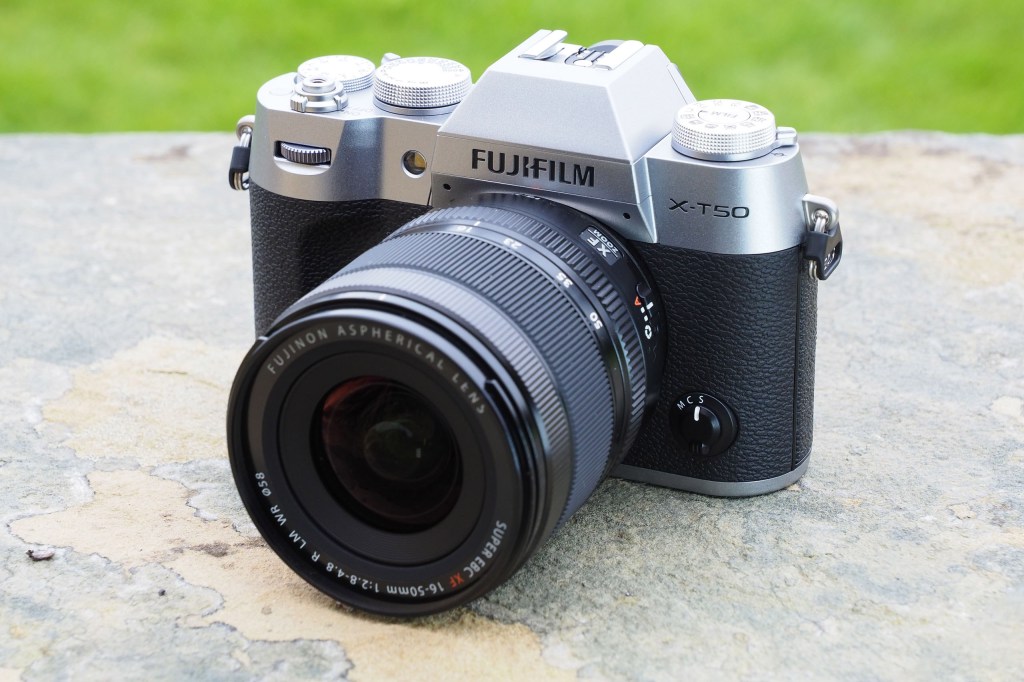
So, what we’re talking about here is body design . Although the X100VI is undeniably a great second camera, I would be reluctant to take one on holiday as my only camera, because it only has a single, fixed 23mm focal length lens (equivalent to 35mm on full-frame) and I struggle with the concept of optical monogamy.
Cartier-Bresson may have been happy with just one lens, but it gives me anxiety. What if I want to photograph something in the distance, or capture a building and can’t stand far enough back? For me, part of the fun of photography is playing with the optical characteristics of the lens: compressing perspective or blowing out the background with tele lenses, and creating an exaggerated ‘in-your-face’ perspective with wide-angles.

I don’t need to do this all the time, but I appreciate the option to do so when the right subject presents itself, by carrying other lens options in my bag. The X-T50 gives me that option, and because Fujifilm produces a good selection of small, lightweight X lenses (a benefit of using APS-C sensors) it isn’t a burden to carry them.
For my trip to Cape Town, South Africa, I took the X-T50 with the new 16-50mm kit lens, plus the 23mm f/2 and the 27mm f/2.8. I chose these primes because I wanted to compare it directly with the X100VI, which has a 23mm f/2 lens. The 27mm f/2.8 pancake, on the other hand, is a better match for the lens on the X100VI in terms of size and weight. I alternated between these two primes as my default, while I carried the X100VI on my other shoulder.

Sure enough there were situations where the 23mm was just not wide enough for the shot I wanted (including a wide shot of Table Mountain with the city below, from the top of Lion’s Head). But the 16mm end of the 16-50mm was just right. Conversely when trying to photograph the colourful birds and flowers at Kirstenbosch Botanical gardens the 50mm end of the kit zoom was a lot more useful than the 23mm lens on the X100VI.
One feature I enjoyed using on the X-T50 is the new film simulation mode dial on the top plate. No longer is one of Fujifilm’s major trump cards hidden away in the menu, it’s now out and proud where everyone can see it, encouraging you to give the dial a twist and see what you get. I loved being able to slip into Acros B&W mode in just a couple of clicks.
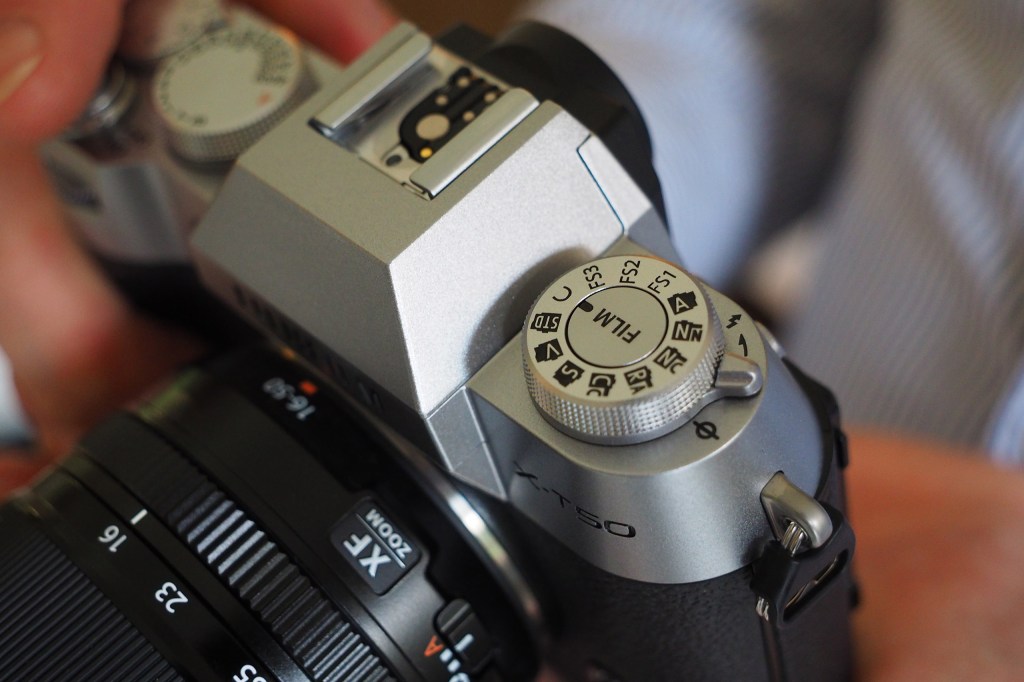
Obviously one feature from the X100VI that the X-T50 lacks is the hybrid viewfinder, and if street photography is your main thing, you may find this an omission that you can’t live with. The rangefinder is undeniably useful for point and shoot situations, but if it comes down to a choice between a hybrid viewfinder and interchangeable lenses, I’ll take the latter every day.
Some may say that the X-T50 lacks the head-turning visual appeal of the X100VI, but I don’t agree. It may not look as cool to the TikTok’ers who turned the X100 series into a fashion accessory, but it still looks like a lovely, small, 35mm film camera to me.
Of course, if you’re lucky enough to be the editor of a photography magazine, or have plenty of money, you can take both, as I did, without even remotely taxing your neck or shoulder muscles. And when I say plenty of money, you don’t even need that much. My entire kit bag of X100VI and X-T50 with three lenses would cost about the same as a single full frame mirrorless camera like the Canon EOS R5, Nikon Z8 or Sony A7 IV with its kit zoom.
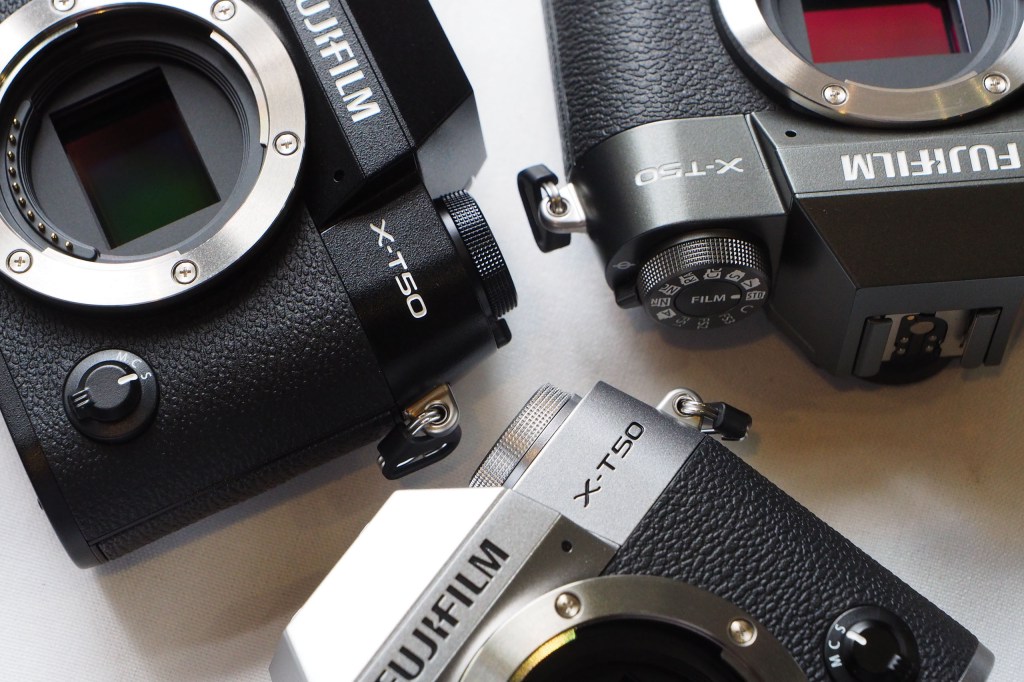
The Fujifilm X-T50 might just be the best travel camera yet made, but it does have some competition other than the X100VI, most notably from the excellent OM System OM-5 , which I took to Cape Town with me on my last trip there back on 2022. The OM-5’s 20MP micro four thirds sensor may not be able to compete with the X-T50’s much larger, higher resolution 40MP APS-C chip, but it does have a few other charms, including full weather-sealing and a fully articulated screen that makes it more suitable for vloggers.
But all things considered, unless something amazing comes out in the meantime, it will be the Fujifilm X-T50 that I will be taking with me on my next holiday. With a couple of extra lenses.
Read our hands-on Fujifilm X-T50 review .

Nigel studied photography at Plymouth College of Art & Design and the University of Westminster and worked as a professional photographer for ten years before joining Amateur Photographer magazine in 1994. He was appointed editor of What Digital Camera in 2002, and Editor of Amateur Photographer in 2013. He has also written and edited several books on photography. His personal website is at www.nigelatherton.com

You may also like...
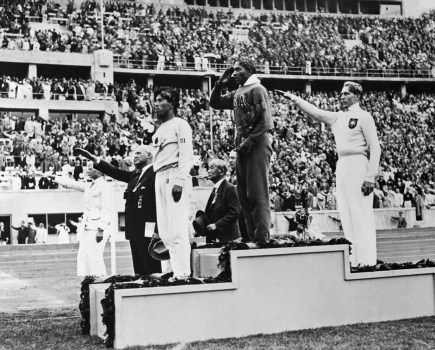
August 9, 2024
The 1936 Olympic long jump medal ceremony friendship is now more important than ever. Nigel Atherton explains why.
by Nigel Atherton

August 4, 2024
Isabella Ruffatti really did bring two mid-range phones to a studio portrait photoshoot. Here's what happened...
by Isabella Ruffatti

July 30, 2024
Have we given up on the DSLR too soon? John Bridges shares his opinion on why he thinks there's still life left in the DSLR
by AP Staff

Looking to improve your photography? Amateur Photographer is the magazine for you, subscribe today and pay just £26 for your first 13 issues!
No thanks, I’m not interested!

Cart (0 product)
Your cart is currently empty, alpha zv-e10 - aps-c interchangeable lens vlog camera 24mp, 4k/30p, vlog style camera, specifications.
and get 2% back in points
Color : Black
Benefits of buying Sony

With the purchase of eligible products**, enjoy 3-month free trial of Ci Media Cloud’s Pro Plan* where you can back up, archive, manage, review, and share your media assets. Learn more
About This Item
- Check Camera to Lens Compatibility
- Check Accessory Compatibility
- Wide lens selection with versatile E-mount system

2x Double your warranty period just by registering
Please see productregistration.sony.com for offer valid dates and details
Reviews & Questions
Return policy, frequently bought together, recently viewed.
- With compatible Sony external flash
- With compatible external flash
- Varies according to shooting conditions or memory card used
- Supports Micro USB compatible device.
- Sony accessories for the Accessory Shoe can be attached.
- The LCD screen is turned on, shot once every 30 seconds, operate zoom alternately between W and T ends, flash strobe once every two times, tum power off and on once every ten times.
- Indication recording time, which is defined by repeating the cycle: Power on, start recording, zoom , stand-by and power off
- Approximately, when compared with a 1/2.3 inch sensor
- 4K (QFHD 3,840 x 2, 160)
- When shooting at XAVC S 4K 24p.
- With battery and memory card included.
- Optical zoom requires a power zoom lens. For other lenses, change the setting to "Clear Image Zoom" or "Digital Zoom" for electronic zoom.
- Employing Al (artificial intelligence) technology, including machine leaning.
- Sound recording is not possible. A Class 10 or above SDHC/SDXC card is required.
- Image crop in Active Mode. Active Mode is not available when recording at frame rates of 120 (100) fps, including S&Q_
- A Class 10 or higher SDHC/SDXC card is required for XAVC S format movie recording. I-IHS speed Class 3 or higher is required for 100 Mbps recording.
- Frame rates are 1-120fps (NTSC) or 1-100fps (PAL)
- In-camera movie playback is in the horizontal position. Whether or not movies are displayed in the vertical position on an external device may depend on the particular device.
- Please use the latest version.
- When shooting stills, eleven effects are available. Not available when shooting in Intelligent Auto mode.
- Wi-Fi does not work during interval shooting.
- Set to movie mode and select "USB Streaming" from Menu before you connect to compatible devices.
- Windows 10, Windows 8.1/macOS 10.13 - 10.15, macOS 11.0. Please refer to the Sony website, or contact customer support for information regarding support on upcoming Xperia TU smartphones. Compatibility with other smartphones depends on manufacturers' specifications. A commercially available USB cable and/or terminal adaptor may be used to connect to equipment with a USB Type-C port.
- Continuous recording time for movies.
- CIPA standards.
- Supported in Catalyst Browse/Prepare Version 2020.1 or later Image stabilization metadata that can be used by Catalyst is generated when using a Sony E-mount lens with the camera's optical image stabilization set to [OFF] or [Active].
- Features and specifications are subject to change without prior notice.
© 2021 Sony Electronics Inc. All rights reserved. Reproduction in whole or in part without written permission is prohibited. Sony is not responsible for typographical and photographic errors. Features and specifications are subject to change without notice. Sony, the Sony logo, the Alpha logo, Exmor and BIONZ X are trademarks of Sony Corporation. All other trademarks are trademarks of their respective owners.

There are two large regions called Altai: the Altai Republic with the administrative center in Gorno-Altaysk and the Altai Krai with its capital Barnaul. The most famous attractions are in the Altai Mountains, but you can also spend some great days in Altai Krai. Here I am telling you where to go in the Altai Krai to have a great time.
Visit Belokurikha - to walk along a terrenkur

Visit Altayskoye - to learn all about Altai herbs

Visit Basargino and experience life in a modern village

Basargino looks like it was created in some kind of computer simulation game. And there, on a little piece of land you need to arrange cozy wooden comfortable houses, a farm, a church, a cafe and a restaurant with insanely delicious meals, an apiary, lakes with fish, a chicken coop and pastures. You also should have cows, pigs, goats and sheep. And also wolves and yaks to make the visitors even more delighted.

Visit the forge in Belokurikha and forge a horseshoe for good luck

There is not a feminine equivalent for a blacksmith, therefore I will simply introduce Anna Biletskaya as the blacksmith. Anna, armed with a heavy hammer and an anvil, is able to forge a horseshoe for a horse in 15 minutes and a decorative horseshoe for luck in only 10 minutes. Well the last one is more in demand lately. Anna opened her smithy to visitors a few years ago. This blacksmith in a skirt shows the whole process during her short master classes: first heat a piece of metal over a fire, then take a hammer and beat it well on the anvil, pull it back, then bend it and put it back into the fire. Finally, cool and clean it.

Visit "The Gold of Altai"(Zoloto Altaya) - to bath in Sanduny or to ride a horse

A hot bath filled with herbs such as hypericum, yarrow, camomile and also a rejuvenating bathtub - these are the Russian answer to the best Asian spa with plumeria flowers. Well, the Altai version looks more brutal, but you will quickly feel the great effect. The herbs are collected and specially prepared here, in "The Gold of Altai" eco-hotel on the shore of the lake. Bathhouses are warmed up in both old Russian traditional ways: the "black" banya (a smoke goes out of bathhouse through cracks in wooden walls) and the "white" banya (a smoke goes out of the bathhouse through a pipe). The professional bath attendants will help guests adjust the right amount of steam and smack them briskly all over their bodies with special bath brooms. The largest horse farm in this district is also located in the hotel area; you should not miss the chance to ride a horse at least around the local territory.

What else to do in Altai:
- Take a walk through the pine forest near Barnaul
- Stop by the village of Srostki, where Vasily Shukshin (the soviet movie director) was born
- Spend a day at the "Biruzovaya Katun" Resort
- Take a walk along Biysk and visit the museum of the Chuysky Tract
- Relax in the "Altay Palace", check-in to the only official gaming zone in Siberia
- Go to Lake Aya

You can see the photo report about Altai Krai and Altai Mountains here .
Also read about Altai: The Princess of Ukok The most beautiful places of the Altai Mountains Looking for a snow leopard A female Blacksmith: The Mother-anvil Karakol Valley: Protected by Spirits Translation: Irina Romanova, Instagram: @astrabella1
Also related posts:

Leave a comment
1. By accepting the terms of this Agreement, the user allows the editor of the "Orange Traveler" blog to collect, store and process his personal data indicated by filling out the web forms at www.orange-traveler.com and www.olgarastegaeva.com - the site). Personal data is any kind of information related to a person directly or indirectly defined or determined individual (citizen).
2. The user also gives the permission of processing and cross-border transfer of the Company's personal data for marketing and informational distribution.
3. The basis for the procession of personal data are: Article 24 of the Constitution of the Russian Federation and Article 6 of the Federal Law No. 152-FZ "About Personal Data" with additions and amendments.
4. While processing personal data, the following operations will be performed: collection, storage, clarification, transfer, blocking, removal, destruction - all the actions mentioned above only have the purposes specified in point 2 of this Agreement.
5. The company accepts the responsibility not to share the User’s data with third parties. Sharing the data with third parties acting according to the agreement with the Company to fulfill obligations to the User and within this Agreement is not a violation of the rules.
6. Personal data is stored and processed until all the necessary procedures are completed or until the company is eliminated.
7. “Orange traveler” does not identify unregistered visitors and does not attempt to connect visitors’ technical data with their personal data. Any personal information shared with the Site by the reader is only processed according to the previously mentioned goals.
8. The consent can be withdrawn by the User or the User’s representative by sending a written application to the Company using this email address [email protected]. The User can also unsubscribe from getting emails using the “Unsubscribe” link at the end of each letter.
9. The User accepts the policy of using cookies files which is used by the Site and gives consent of getting the information about IP-address and other information about the User’s activity while using the Site. This information is not used for identifying the User.
10. While processing of personal data the company takes necessary and sufficient organizational and technical approaches to protect personal data from illegal access to it and from other illegal activities connected to personal data.
11. All information in the site is purely informative and is not a recommendation or motivation for any kind of actions. “Orange traveler” is not responsible for any actions committed using the published information. The Site and the apps can include links to third-party sites, products and services the content of which is not controlled by “Orange traveler” and the company is not responsible for it. It is recommended to learn about privacy policy of the third-party resources.
12. “Orange traveler” may use cookie files and other technologies which let us better understand the readers’ behavior, rate and improve the quality of the product and the efficiency of the advertisement. The information collected with the use of cookie files and other technologies is not personal information. However, IP-addresses and similar identifiers are considered personal information if it is envisaged by local law.
- Bahasa Indonesia
- Slovenščina
- Science & Tech
- Russian Kitchen
Ancient Traditions and Untouched Landscapes: The Altai Mountains
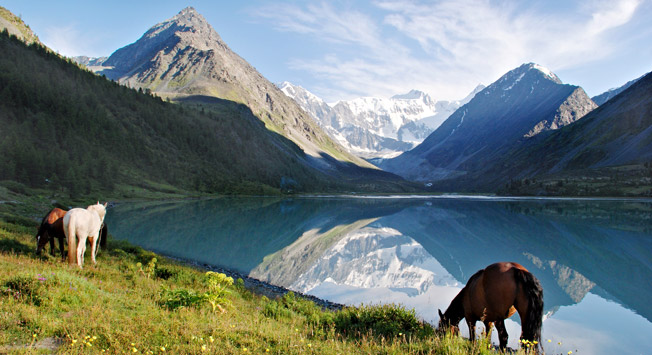
Altai Republic vs. Altai Krai
Before leaving for your trip, you should know where to go. The largest part of the Altai mountain range crosses the territories of the Atlai Republic and Altai Krai -- administrative subjects of Russia that are often confused with one another. The locals are not fond of this confusion, therefore it is worth it to make a minimum effort to remember that Gorno-Altaisk is the capital and only city in the Altai Republic, located just south, while Barnaul is the capital of Altai Krai, where the closest airport is located -- you most likely will arrive there if you decide to travel to Altai by plane. There is no transportation by rail, so getting to this hill country is possible only by plane or by car -- from Barnaul to the mountains you must travel by bus. In general, the center of the Altai Republic, Gorno- Altaisk, is the transit point to the Altai Mountains.
The Altai Republic is located at the heart of the center of the Eurasian continent. Though it is far from the largest administrative unit of Russia, its size is comparable to Portugal, Jordan, and Hungary. Roughly 200,000 people live in the area, and are mostly ethnic Russians and Altai people. Altai people are considered ancestors of modern Turkic peoples, including Tatars, Yakuts, Uzbeks, Azerbaijanis -- Mesopotamian Sumerians used expressions and words found in the Altai language as early as 3000 B.C.
Kaichi and Throat Singing
Altai, as one of the few places in the world in which a unique type of oral folklore endures, is a place of storytelling. Storytellers, known in Altai as kaichi, perform their work through throat singing, with accompanying music on the tapshure, a two-stringed musical instrument. Kaichi sing both folk songs and heroic epics -- known as kai. Do not miss the chance to listen to kaichi, as they are very impressive. The longest kaichi performance can last several days.
The Katun River is one of the most famous and relatively accessible attractions of the Altai Republic. Many legends about the Katun exist among the local people -- almost all of them include the daughter of Khan Altai, who seeks her beloved Biya (Biya is yet another Altai river) -- and so as the Katun River turns, along with the Biya River it merges into the Ob, Siberia’s largest waterway. The easiest way to begin a journey is from the village of Manzherok, which is located near the lake of the same name, as well as directly on the shores of the Katun. The chain of tourists facilities begin here, at which you can rent equipment and kits for motor-rafting and rafting. Prices are fairly reasonable -- a boat excursion to the famous Kamyshlinsky waterfall costs around 500 rubles or less. The season for rafting starts in May and ends in October.
The Expeditions of Nicholas Roerich
The first tourist to Altai was the Russian artist and philosopher Nicholas Roerich -- he arrived in Altai in 1926. In the village of Verkhny Uimon (which in Altai means ten wisdoms), the house of local resident Bartholomew Atamanov, where Nicholas Roerich organized his headquarters, is now home to a museum for the artist. Bartholomew Atamanov was repressed during the Soviet era and his estate was recovered as a museum only in the 1990s.
Kerzhak believers still reside in the village of Verkhny Uimon, as they fled to Altai from persecution in the region of Nizhy-Novgorod during the eighteenth century (the name Kerzhak originates from the Kerzhenets River). The Kerzhaks were one of the first Russian groups to settle in Siberia, and they maintained an indoor way of life with strict religious rules and cultural traditions. Deserters from government duties also settled with the Kerzhaks, and they formed a group of Altai masons, known as the Highlanders.
According to Roerich, who studied the culture of the Old Believers, here, in the valley of the Bukhtarma and Katun rivers, lies the legendary country Belovode, the Slavic Shambala, the “land of freedom” from Russian folktales. After the death of Roerich, one of the peaks of the Altai mountains was named in his honor. Today, climbing to its top by horse costs about 1000 rubles. Many tourist facilities in Altai offer horseback riding and hiking for one or more. It’s hard to be bored in this beautiful landscape: wherever you go you will find mountains, rivers, waterfalls and ancient forests to explore.
Chuysky Trakt: Chuya Highway
When travelling through the Altai Mountains, it is impossible not to drive on highway M-52, which is also known as the Chuysky Trakt. M-52, 541 km long, extends across the Altai Mountains to the Mongolian border. Construction on the highway began in the second half of the nineteenth century and was finished in the mid-twentieth century. It is one of the most picturesque highways in Russia, and perhaps the world. Chuysky Trakt leads to Kalbak-Tash (in Altai, flat rock), the site on the right bank of the River Chu full of runic inscriptions. Thousands of petroglyphs belonging to the Scythians, Huns and ancient Turks are preserved here. The petroglyphs of Kalbak-Tash make a strong impression, and they are public -- viewing them and taking photos are absolutely free.
Pazyryk Burials
In his diaries, Nicholas Roerich wrote that during the Great Migrations, Altai played a key role as a transition point for a variety of nomadic peoples on the continent. In prehistoric and likewise historic times, according to Roerich, Altai was like an “unopened treasure.” The Pazyryk Burials are one part of this treasure trove, with its Scythian tombs for tribal chiefs that date from the 5th to 2nd centuries B.C. Because of the conditions prevalent at altitudes of 2000 meters such as permafrost, perfectly preserved mummies can be found in graves -- one body is so well preserved that complex drawings are visible on its skin, which is the oldest example of a tattoo in the world. Additionally, each of the three-meter burial mounds preserved vehicles, patterns, and textiles, including the world’s oldest carpet. Most of these discoveries are exhibited at the State Hermitage in St. Petersburg. The Pazyryk Burials also has its own princess -- in 1993 the mummy “Princess Ukoka,” as she was christened to the local people, was found. During excavation of the third mound, a burial site from the Iron Age was discovered, under which lies another more ancient site. During the excavation, archaeologists found that the trough in which the body was placed in and buried was filled with ice.
That is why the female mummy was so well preserved. The lower burial was found to be bricked with a layer of ice. A camera discovered six saddled horses with harnesses in the lower burial, and the ancient trough was made from larch wood and boarded shut with bronze nails.
Lake Teletskoye
Close to the Pazyryk Burials is the Katu-Yaryk pass (in Altai: dangerous place) -- the pass was build with record speed: only three bulldozers were used over three summers. The slope of the mountainside of Katu-Yaryk reaches 70 degrees. Traveling through the pass allows one to reach the southern region of Lake Teletskoye, a UNESCO World Heritage Site comprised of the Golden Mountains of Altai.
Many rivers empty into Lake Teletskoye -- a miniature Lake Baikal -- but only one river flows out of the lake, Lake Biya. Even in the summer, the water temperature does not rise higher than ten degrees. Holding nearly forty cubic kilometers of practically distilled water, Lake Teletskoye is one of the fifteen deepest lakes on the planet (its depth reaches 325 meters). The lake has not yet been disturbed by tourists, and Teletskoye’s main contingent includes tourist-fishermen. The lake is not too large and can be circled in one day. Its water is clear and the air is clean. Sport hunting and fishing are permitted, but not in the reserves. Almost all of the eastern part of the Altai Republic is occupied by the Altai reserve, one of the largest in Russia. The territory contains 1290 species of plants, 73 species of mammals, 300 species of birds and 1190 glacial lakes.
All rights reserved by Rossiyskaya Gazeta.
to our newsletter!
Get the week's best stories straight to your inbox
This website uses cookies. Click here to find out more.

COMMENTS
1. 50mm lenses are small and lightweight. In travel photography, weight is a big deal. You want to carry a light load; that way, your travels can be as convenient and comfortable as possible. Of course, the best way to avoid a heavy load is by packing gear that is essential, small, and lightweight. The 50mm lens fits all three of these ...
Canon EF 24-105mm f/4L IS USM (Best Canon EF Zoom Lens for Travel Photography) The Canon EF 24-105mm f/4L IS USM is a travel photography favourite, thanks to its blend of versatility and image quality. As part of Canon's esteemed L-Series, it's well-known for superior optical performance.
The 5 Best Compact Cameras For Travel - Spring ...
The best travel camera in 2024
5.9. Body Type SLR-Style. Mirrorless Yes. Sensor Size 4/3 (MFT) See all our test results. The OM SYSTEM OM-5 is the best digital camera for travel that you can get. As part of the Micro Four Thirds (MFT) system, it offers a balanced mix of portability, ruggedness, and image quality. Though it isn't as heavy-duty as higher-end models like the OM ...
The Best Travel Cameras for 2024. ... But its extra-wide 18-50mm F1.8-4.0 zoom lens and large Type 1 Stacked CMOS sensor also make it ideal for capturing cityscapes, landscapes, ...
The 50mm focal length is among the most used across different photography genres, and by photography masters across history. But if you're new to the 50mm lens, today's featured video should help you get started. In the video above, Jorge Delgado-Ureña of The Raw Society shares his insights on 50mm — its strengths and what makes it the focal length of choice for many.
50mm Travel Photography Basics. The 50mm lens is one of the first lenses I purchased when I got serious about photography. There's a reason that it's called the "nifty fifty.". It's nimble, flexible, and it works great at different skill levels. There are three popular versions of this lens with a range of f/stops.
What many travel photographers opt for instead is a wider prime and in this video, TKNORTH discusses his new favorite, the Sigma 24mm f/1.4 DG HSM Art. That is particularly wide and fast, which ...
The Z50 is a mirrorless camera, meaning it's compact in size and more lightweight than most DSLR brothers. For a travel camera particularly, the small size and weight is definitely something you will appreciate, having to carry it with you on tours and hikes. However much I love my Nikon D3 DSLR, after a while, it feels like I'm carrying a ...
Best pocketable travel camera: Ricoh GR III. 24MP APS-C sensor | 28mm equiv. F2.8 lens | Wi-Fi + Bluetooth. The Ricoh is a pocketable compact with a large APS-C sensor. Photo: Barney Britton. Buy now: $997 at B&H Photo $997 at Adorama $1016 at Amazon.
Last Updated on 05/20/2019 by Mark Beckenbach. If you're just getting started with travel photography and have been browsing around for some tips on the best lenses to use, this 35mm vs 50mm ...
The 50mm f/1.4 is typical in having a beautifully engineered metal barrel and a full set of weather-seals. The optical design is based on Zeiss's legendary Distagon principles. The long rotational travel of the focus ring helps focusing precision, and its super-smooth fluidity makes focusing a joy.
Regardless of how big your camera is, snapping a 50mm on to the front of it will change the way your arms and back approach your photographs. ... Am shooting Nikon F6 - travel, street, architecture, details. Save the 50mm af for tracking kiddies and other things that move. Also own a D750, but transitioning back to film and traveling light. thanks!
Need the best travel camera to take on your next trip? Lightweight, high performance and affordable - this in-depth guide reveals the 6 top options! ... Get this renewed Sony a6000 with 16-50mm Power Zoom. 📸 Want the latest technology under $1,000? Get this Sony a6400 with 16-50mm Power Zoom. 📸 Don't want the fuss of changing lenses?
Best Advanced Point-and-Shoot - Canon Powershot G1 X III. Best Budget Mirrorless - Panasonic Lumix GX80 / GX85. Best Mirrorless For Travel - Sony A6500. Best Budget DSLR - Nikon D3500. Best DSLR For Travel - Canon EOS 80D. Best Action Camera - GoPro HERO10. Best Smartphone Camera - Google Pixel 3a.
Oh, and the Fujifilm X-T50 is a pretty darn good travel camera. All of the double-digit X-T series models are especially good for travel, thanks to their compactness. What I like about the X-T50 in particular is the slightly larger grip (compared to the X-T30), which helps when using bulkier lenses, the new Film Dial, which adds some SOOC ...
16 May 2024 / 07:00 BST. The Fujifilm X-T50 is lightweight but built to last (shown here with the new 16-50mm lens). As you may have heard, the world has gone bananas for the Fujifilm X100VI, which updates its predecessor by adding a bunch of features from the X-T5, including the 40MP sensor, Image Stabilisation and Subject Recognition AF ...
Discover how to bring your vlogging to the next level with Sony ZV-E10/B APS-C Camera. Wi-Fi connectivity and precise focus and audio. Compatible with 60 Sony lenses. ... Body + 16-50mm Zoom Lens. Color : Black #212028 | Black. #FCFCFD | White. Free Shipping : Est. Delivery Sep 9-10 . ADD TO CART . Benefits of buying Sony
Skip to main content. Discover. Trips
Visit Basargino and experience life in a modern village. Basargino looks like it was created in some kind of computer simulation game. And there, on a little piece of land you need to arrange cozy wooden comfortable houses, a farm, a church, a cafe and a restaurant with insanely delicious meals, an apiary, lakes with fish, a chicken coop and pastures.
State Art Museum of Altai Krai, Barnaul: See 7 reviews, articles, and 8 photos of State Art Museum of Altai Krai, ranked No.34 on Tripadvisor among 238 attractions in Barnaul.
Follow Russia Beyond on Telegram. The Altai Mountains, considered by some the "Green Pharmacy" of the earth and the "lungs" of the planet, is one of the cleanest and most unpolluted ...